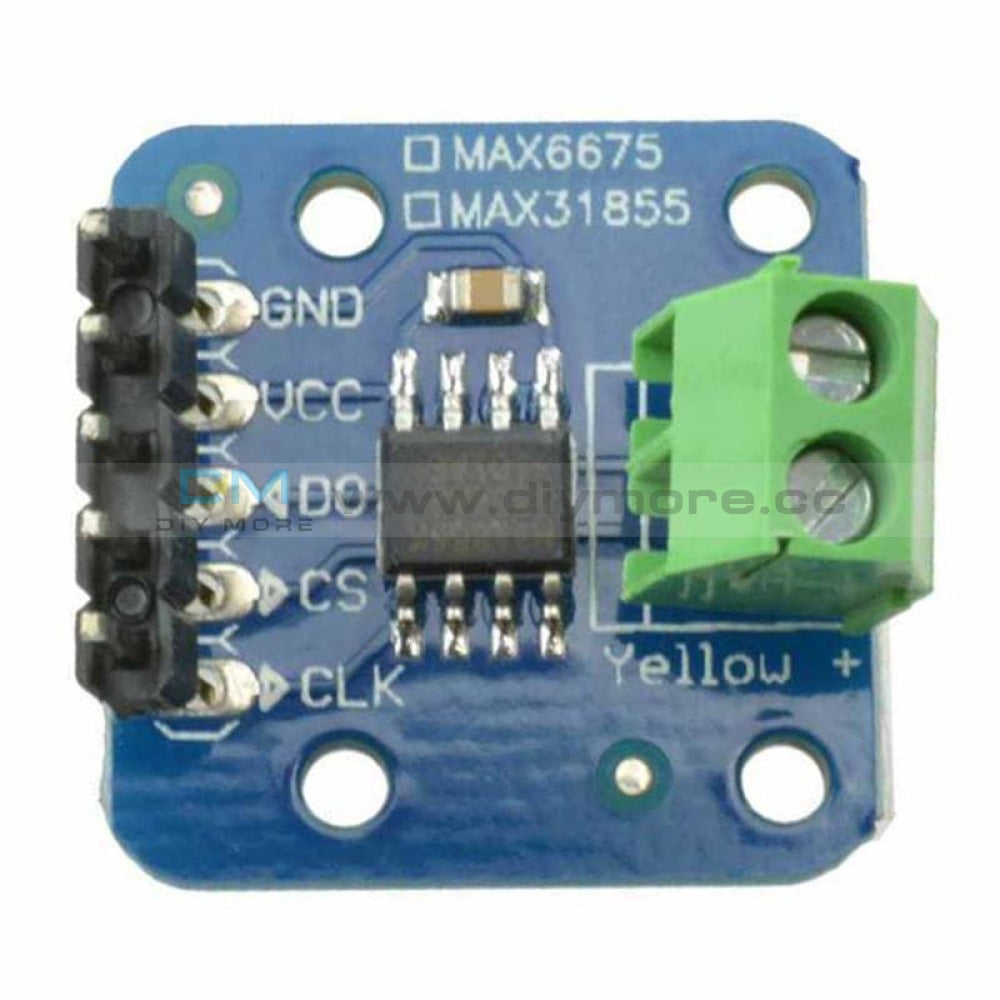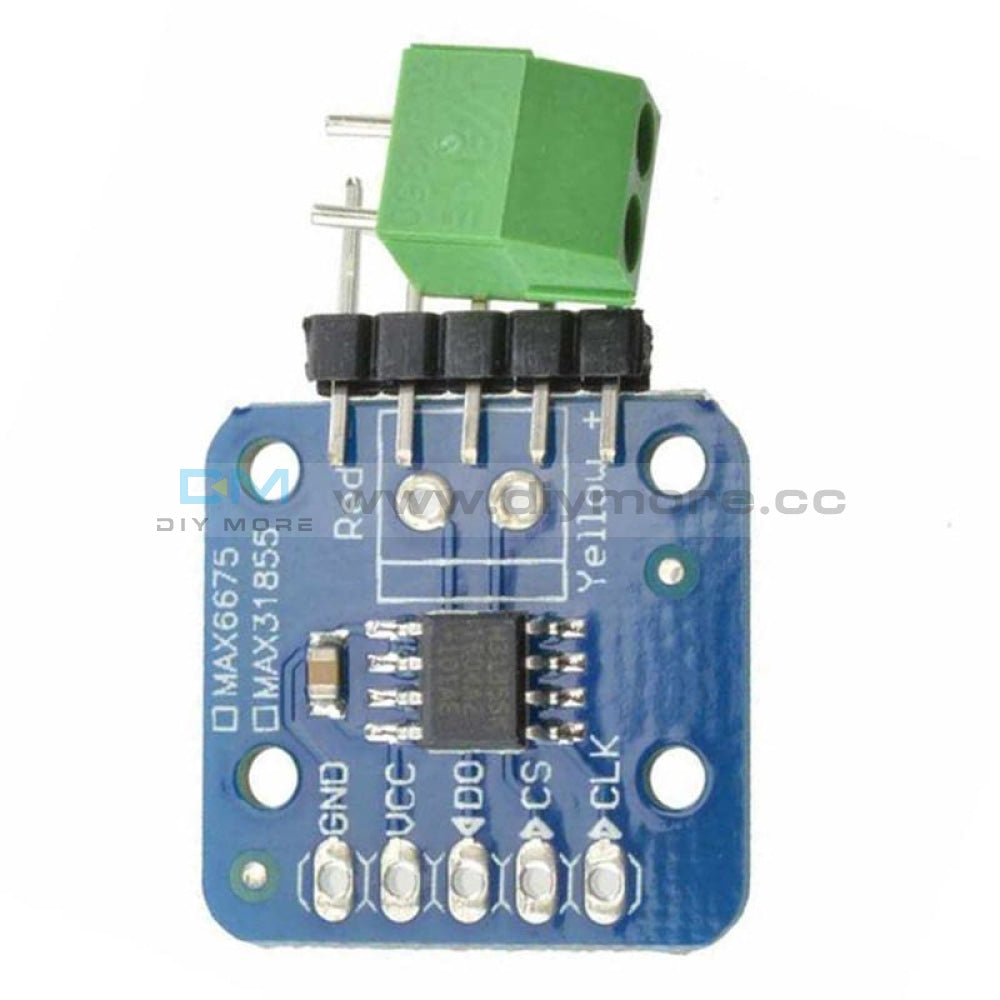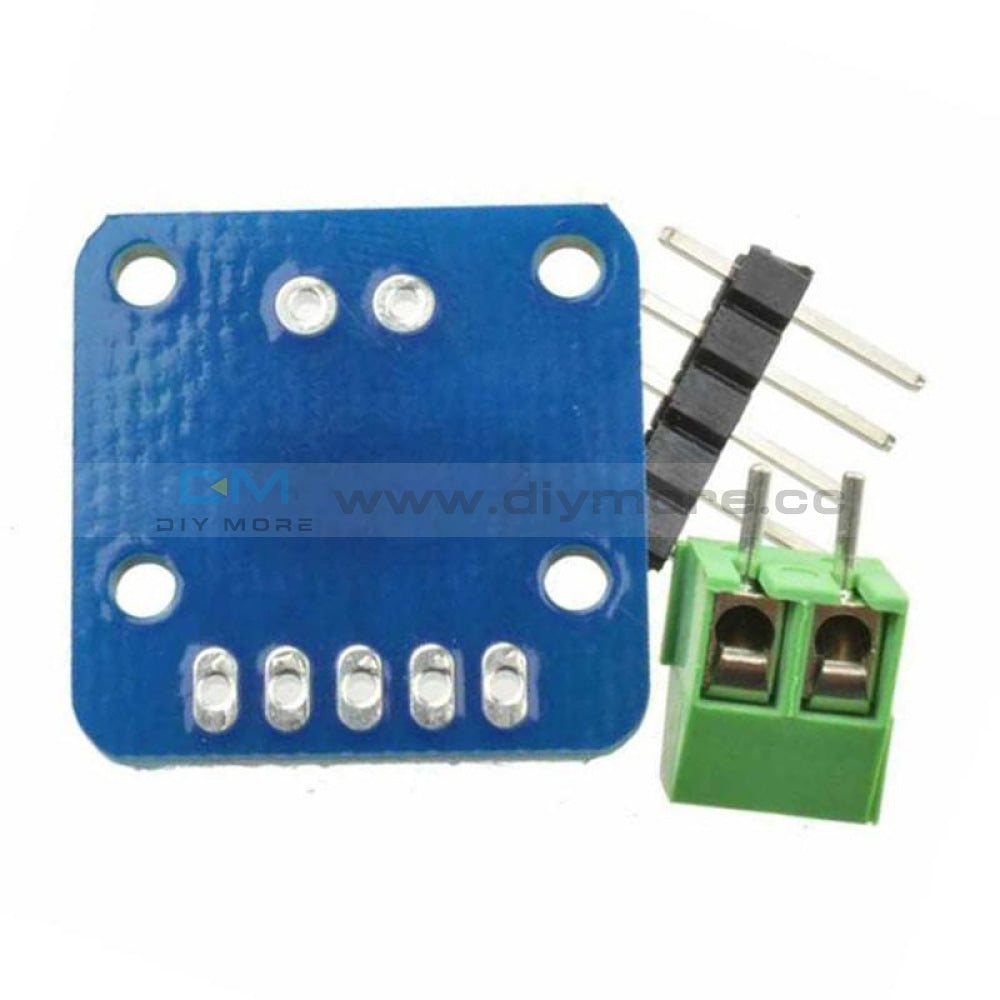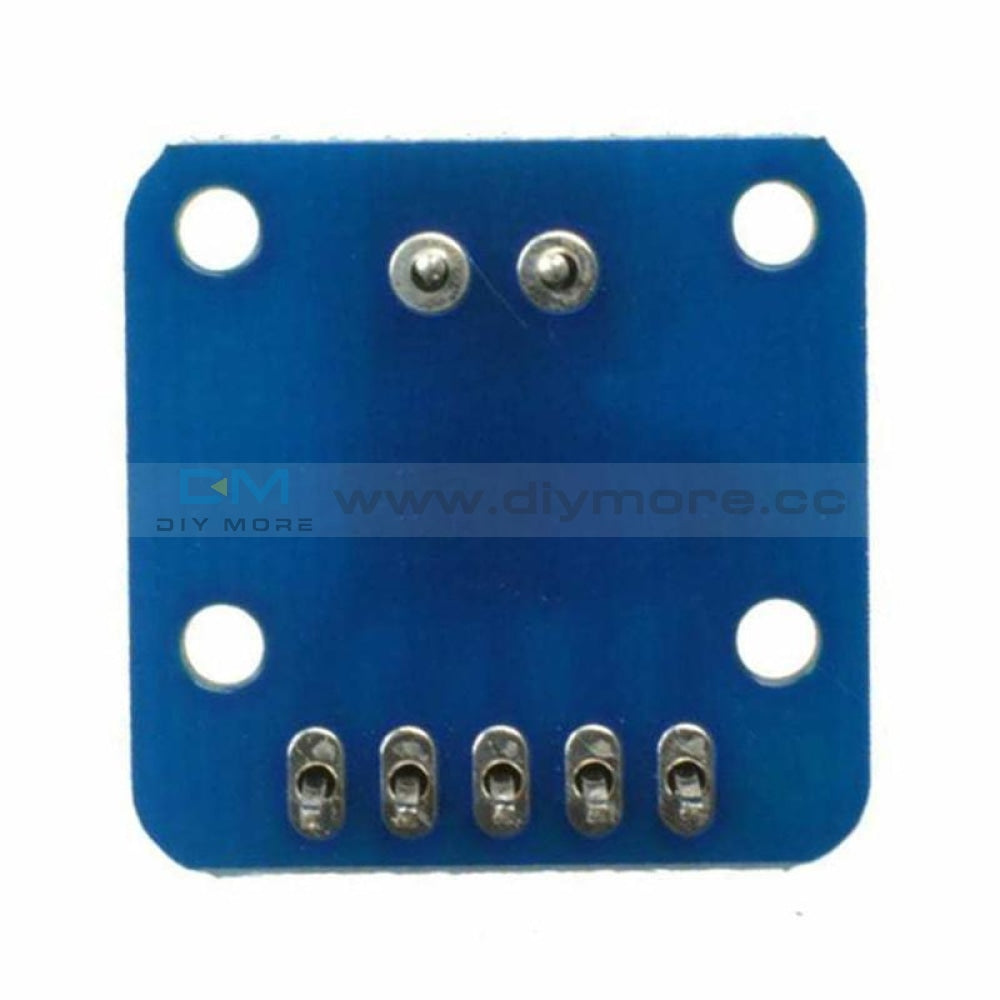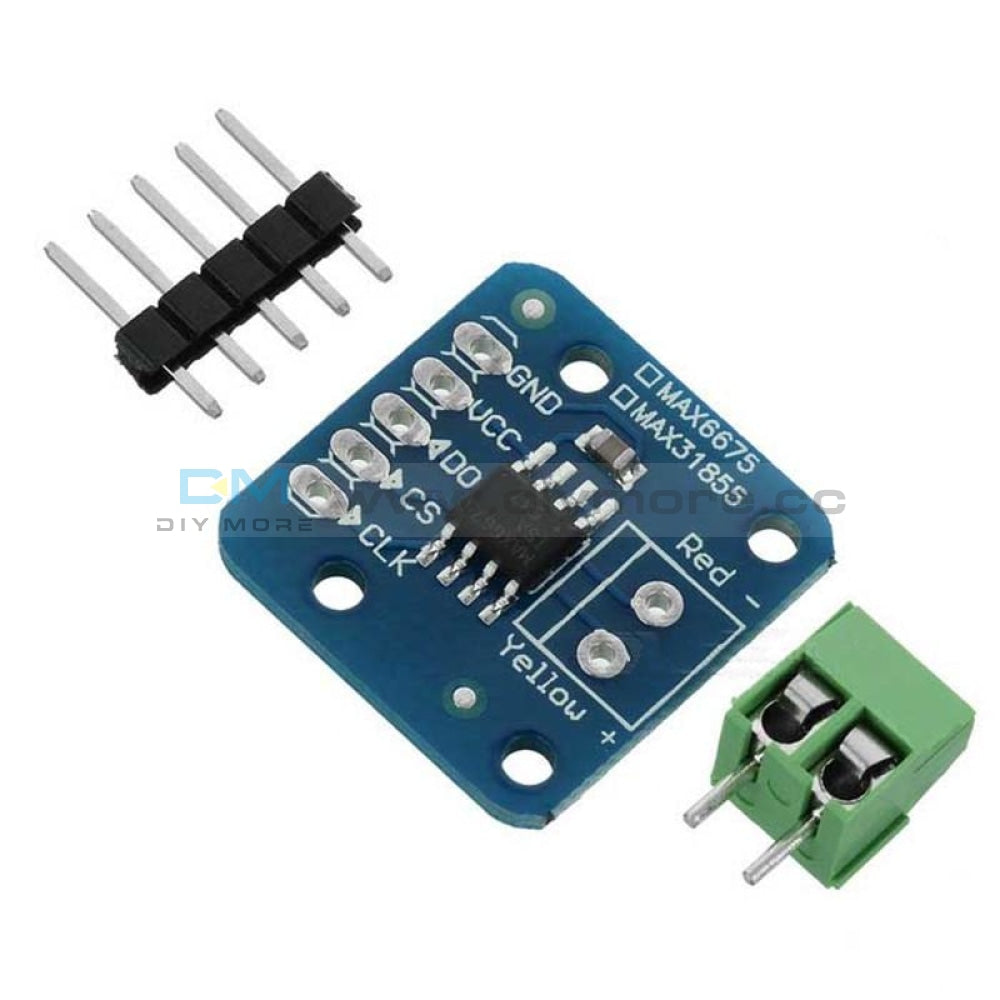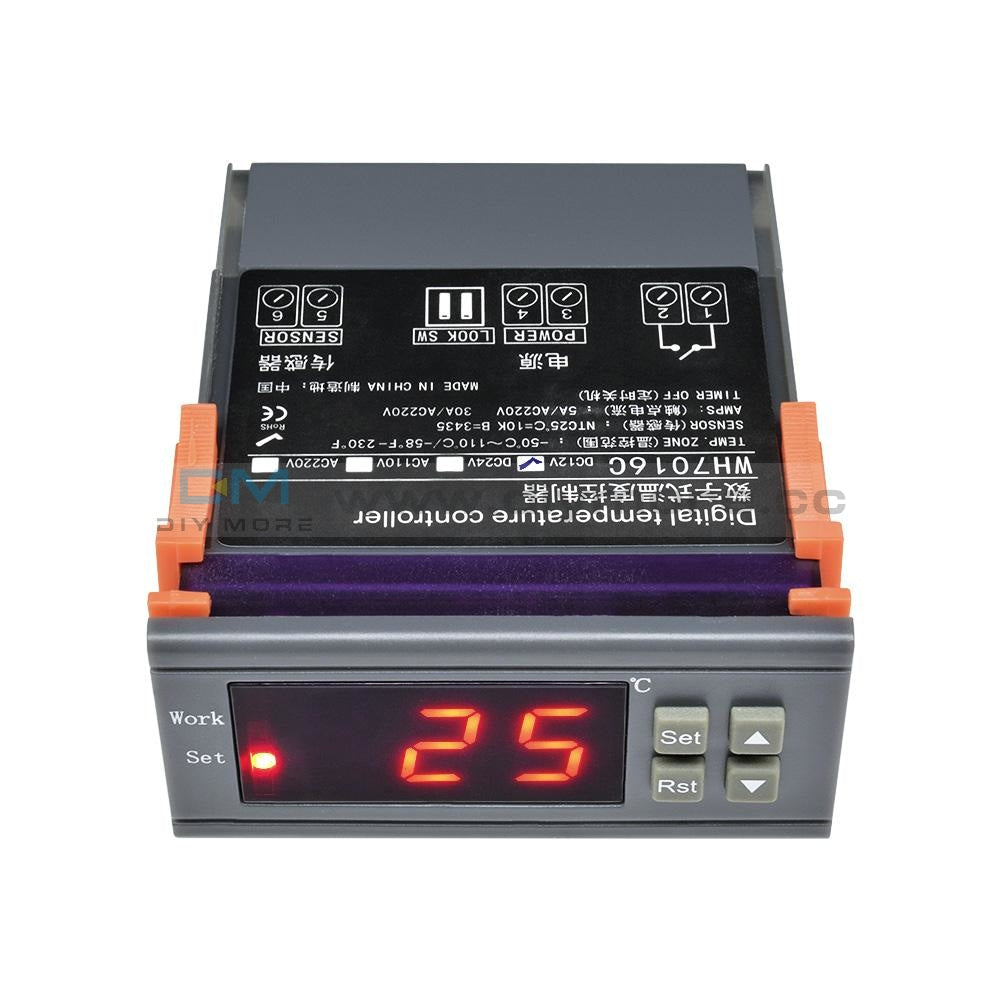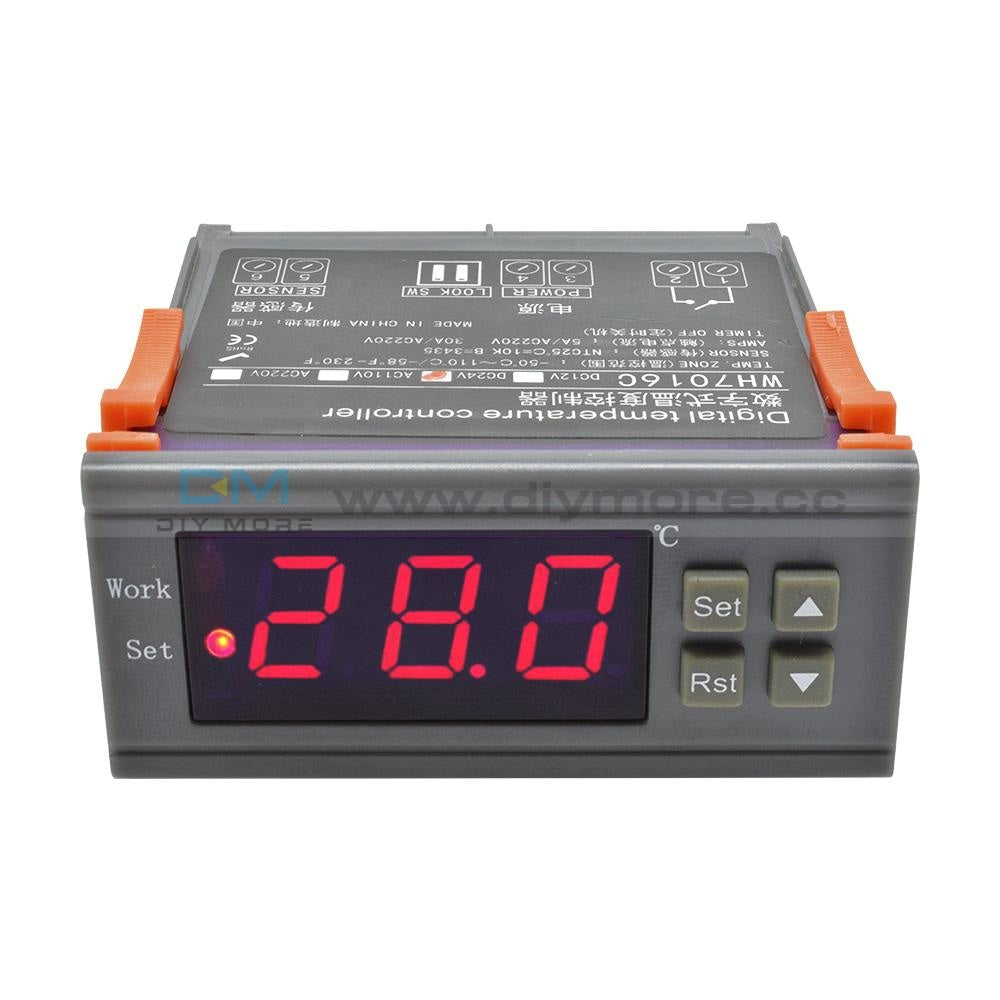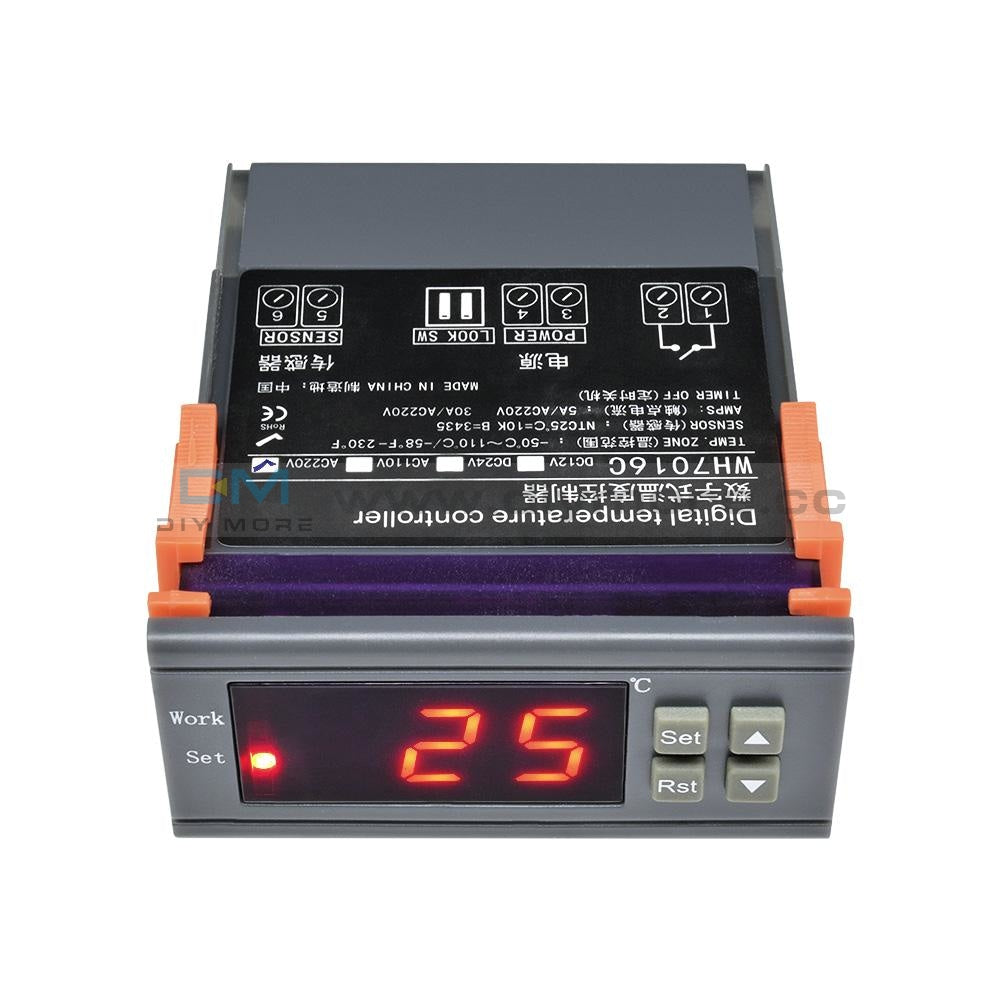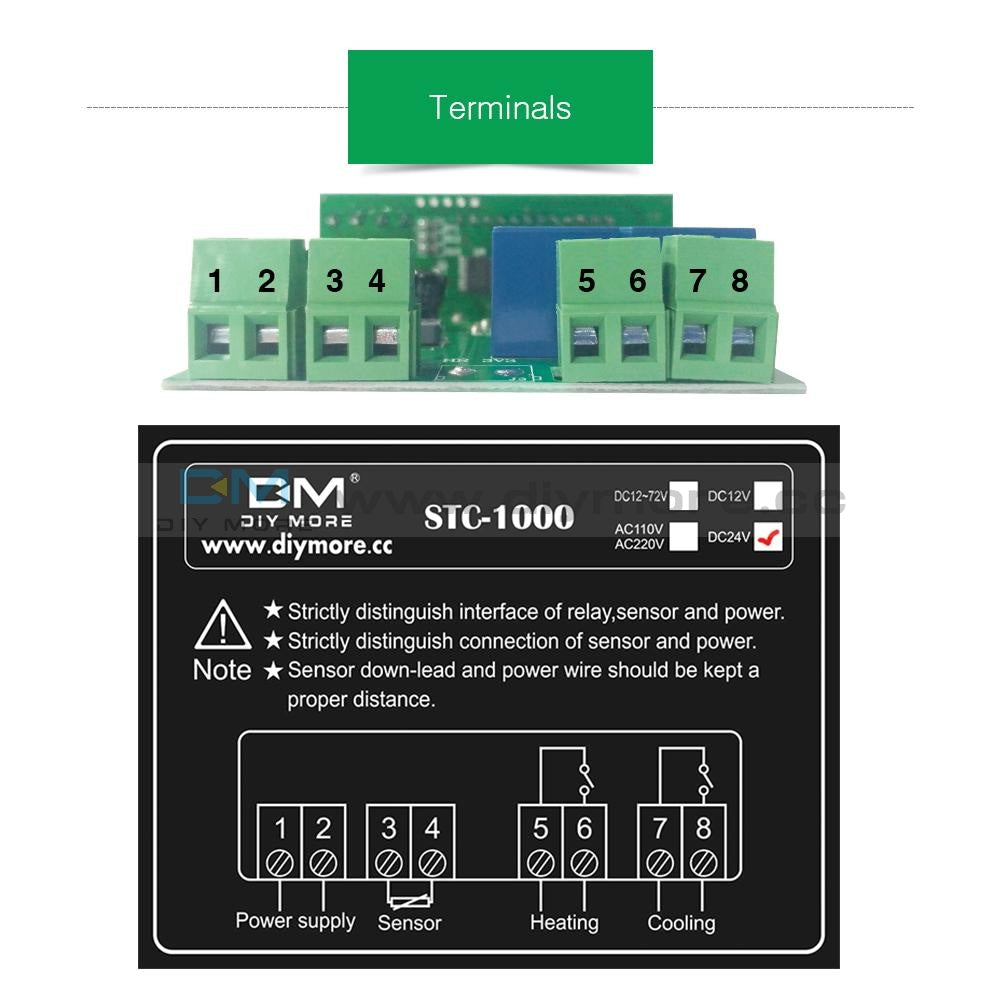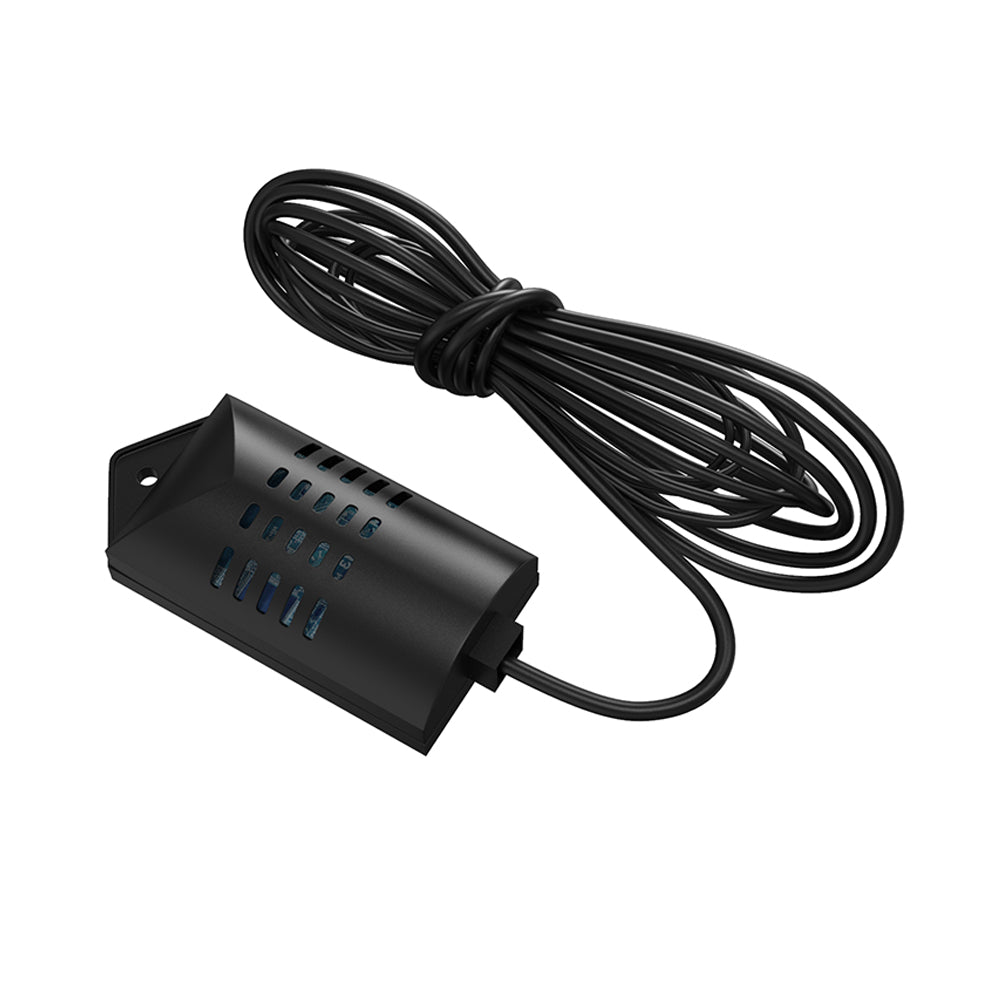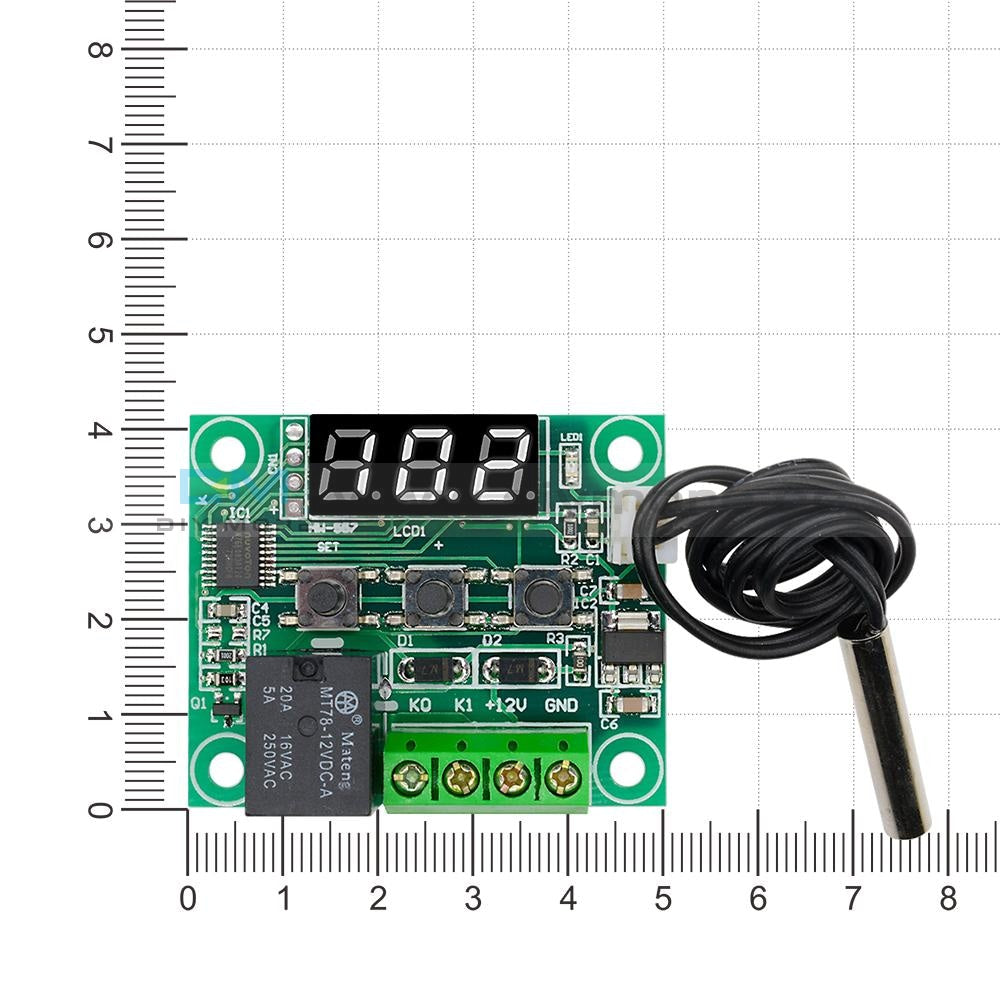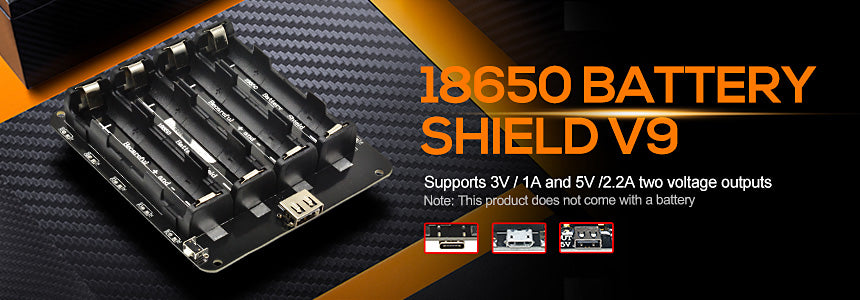MAX6675 K-Typ thermocouple Breakout Temperature -200 bis+ 1350℃ Module
MAX6675 K-Typ thermocouple Breakout Temperature -200 bis+ 1350℃ Module
SKU:012184- guaranteeQuality checked
- Special gift cardsSpecial gift cards
- Free return Within 60 days
- Consultancy86-0755-85201155
Power supply: 3.3 V
Accuracy: ±2°C to ±6°C
Output: -200°C to +1350°C
The conversion time of the MAX6675 is typical: 0.17s with a maximum of 0.22s.
Feature:
Thermocouples are very sensitive, require a good amplifier with a cold-compensation reference.
This breakout board has the chip itself, a 3.3V regulator with 10uF bypass capacitors and level shifting circuitry, all assembled and tested.
Comes with a 2 pin terminal block (for connecting to the thermocouple) and pin header (to plug into any breadboard or perfboard).
Logic level compliant, internal temperature reading.
SPI data output requires any 3 digital I/O pins.
Durable and stable.
With a fixed mounting holes for easy fixed installation.
Works with any K type thermocouple.
Note:
Optimal
Force
A
The complete data needs to be read out with 16 clock signals and read on the falling edge of the clock.
D15 is always 0;
D14~D3 are conversion results;
D2 is open circuit detection, generally 0, 1 when no K-type thermocouple is connected;
D1 is 0 to provide the device number of the MAX6675.
D0 is tri-stated.
T- must be connected to GND, and the connection end of T- is as close as possible to the GND of the chip.
In order to prevent measurement errors caused by self-heating effects, large-area paving is used to improve measurement accuracy.
The following measures can also be taken to improve accuracy:
Use as thick a wire as possible, but do not let the wire be a thermal conductor;
If only thin conductors can be used, use only thin conductors in the measurement area and then use the compensation extension line where there is no temperature gradient;
Avoid mechanical stress and vibration;
When the thermocouple wire is long, use a twisted pair extension cable;
Avoid the presence of severe temperature gradients;
Use thermocouples within the scope of application;
Protect the thermocouple wires with a suitable coating material in harsh environments;
Use extension cords only at lower temperatures and smaller temperature gradients;
Save an event log and continuously record the resistance of the thermocouple.
Package Included:
1PC*MAX6675 K-Typ Thermocouple Breakout Board
Purchasing & Delivery
Before you make your purchase, it’s helpful to know the measurements of the area you plan to place the furniture. You should also measure any doorways and hallways through which the furniture will pass to get to its final destination.Picking up at the store
Shopify Shop requires that all products are properly inspected BEFORE you take it home to insure there are no surprises. Our team is happy to open all packages and will assist in the inspection process. We will then reseal packages for safe transport. We encourage all customers to bring furniture pads or blankets to protect the items during transport as well as rope or tie downs. Shopify Shop will not be responsible for damage that occurs after leaving the store or during transit. It is the purchaser’s responsibility to make sure the correct items are picked up and in good condition.Delivery
Customers are able to pick the next available delivery day that best fits their schedule. However, to route stops as efficiently as possible, Shopify Shop will provide the time frame. Customers will not be able to choose a time. You will be notified in advance of your scheduled time frame. Please make sure that a responsible adult (18 years or older) will be home at that time.In preparation for your delivery, please remove existing furniture, pictures, mirrors, accessories, etc. to prevent damages. Also insure that the area where you would like your furniture placed is clear of any old furniture and any other items that may obstruct the passageway of the delivery team. Shopify Shop will deliver, assemble, and set-up your new furniture purchase and remove all packing materials from your home. Our delivery crews are not permitted to move your existing furniture or other household items. Delivery personnel will attempt to deliver the purchased items in a safe and controlled manner but will not attempt to place furniture if they feel it will result in damage to the product or your home. Delivery personnel are unable to remove doors, hoist furniture or carry furniture up more than 3 flights of stairs. An elevator must be available for deliveries to the 4th floor and above.
Other Customers also buy:
-
Translation missing: en.products.product.regular_price $6.99 USD{"id":2388480688186,"title":"MAX6675 K-Typ thermocouple Breakout Temperature -200 bis+ 1350℃ Module","handle":"max6675-k-typ-thermoelement-breakout-temperature-200-bis-1350-module","description":"\u003cp\u003ePower supply: 3.3 V\u003cbr\u003eAccuracy: ±2°C to ±6°C\u003cbr\u003eOutput: -200°C to +1350°C\u003c\/p\u003e\n\u003cp\u003eThe conversion time of the MAX6675 is typical: 0.17s with a maximum of 0.22s.\u003cbr\u003e\u003cbr\u003eFeature:\u003cbr\u003eThermocouples are very sensitive, require a good amplifier with a cold-compensation reference. \u003cbr\u003eThis breakout board has the chip itself, a 3.3V regulator with 10uF bypass capacitors and level shifting circuitry, all assembled and tested. \u003cbr\u003eComes with a 2 pin terminal block (for connecting to the thermocouple) and pin header (to plug into any breadboard or perfboard).\u003cbr\u003eLogic level compliant, internal temperature reading.\u003cbr\u003eSPI data output requires any 3 digital I\/O pins.\u003cbr\u003eDurable and stable.\u003cbr\u003eWith a fixed mounting holes for easy fixed installation.\u003cbr\u003eWorks with any K type thermocouple.\u003cbr\u003e\u003cbr\u003e\u003cstrong\u003eNote:\u003c\/strong\u003e\u003c\/p\u003e\n\u003cp\u003e\u003cspan\u003eOptimal \u003c\/span\u003e\u003cwbr\u003e\u003cspan\u003eperformance \u003c\/span\u003e\u003cwbr\u003e\u003cspan\u003efrom \u003c\/span\u003e\u003cwbr\u003e\u003cspan\u003ethe \u003c\/span\u003e\u003cwbr\u003e\u003cspan\u003eMAX6675 \u003c\/span\u003e\u003cwbr\u003e\u003cspan\u003eis \u003c\/span\u003e\u003cwbr\u003e\u003cspan\u003eachieved \u003c\/span\u003e\u003cwbr\u003e\u003cspan\u003ewhen \u003c\/span\u003e\u003cwbr\u003e\u003cspan\u003ethe \u003c\/span\u003e\u003cwbr\u003e\u003cspan\u003ethermocouple \u003c\/span\u003e\u003cwbr\u003e\u003cspan\u003ecold \u003c\/span\u003e\u003cwbr\u003e\u003cspan\u003ejunction \u003c\/span\u003e\u003cwbr\u003e\u003cspan\u003eand \u003c\/span\u003e\u003cwbr\u003e\u003cspan\u003ethe \u003c\/span\u003e\u003cwbr\u003e\u003cspan\u003eMAX6675 \u003c\/span\u003e\u003cwbr\u003e\u003cspan\u003eare \u003c\/span\u003e\u003cwbr\u003e\u003cspan\u003eat \u003c\/span\u003e\u003cwbr\u003e\u003cspan\u003ethe \u003c\/span\u003e\u003cwbr\u003e\u003cspan\u003esame \u003c\/span\u003e\u003cwbr\u003e\u003cspan\u003etemperature. \u003c\/span\u003e\u003cwbr\u003e\u003cspan\u003eAvoid \u003c\/span\u003e\u003cwbr\u003e\u003cspan\u003eplacing \u003c\/span\u003e\u003cwbr\u003e\u003cspan\u003eheat-generating \u003c\/span\u003e\u003cwbr\u003e\u003cspan\u003edevices \u003c\/span\u003e\u003cwbr\u003e\u003cspan\u003eor \u003c\/span\u003e\u003cwbr\u003e\u003cspan\u003ecomponents \u003c\/span\u003e\u003cwbr\u003e\u003cspan\u003enear \u003c\/span\u003e\u003cwbr\u003e\u003cspan\u003ethe \u003c\/span\u003e\u003cwbr\u003e\u003cspan\u003eMAX6675 \u003c\/span\u003e\u003cwbr\u003e\u003cspan\u003ebecause \u003c\/span\u003e\u003cwbr\u003e\u003cspan\u003ethis \u003c\/span\u003e\u003cwbr\u003e\u003cspan\u003emay \u003c\/span\u003e\u003cwbr\u003e\u003cspan\u003eproduce \u003c\/span\u003e\u003cwbr\u003e\u003cspan\u003ecold-junction-related \u003c\/span\u003e\u003cwbr\u003e\u003cspan\u003eerrors.\u003c\/span\u003e\u003c\/wbr\u003e\u003c\/wbr\u003e\u003c\/wbr\u003e\u003c\/wbr\u003e\u003c\/wbr\u003e\u003c\/wbr\u003e\u003c\/wbr\u003e\u003c\/wbr\u003e\u003c\/wbr\u003e\u003c\/wbr\u003e\u003c\/wbr\u003e\u003c\/wbr\u003e\u003c\/wbr\u003e\u003c\/wbr\u003e\u003c\/wbr\u003e\u003c\/wbr\u003e\u003c\/wbr\u003e\u003c\/p\u003e\n\u003cp\u003e\u003cspan\u003eForce \u003cwbr\u003eCS \u003cwbr\u003elow \u003cwbr\u003eand \u003cwbr\u003eapply \u003cwbr\u003ea \u003cwbr\u003eclock \u003cwbr\u003esignal \u003cwbr\u003eat \u003cwbr\u003eSCK \u003cwbr\u003eto \u003cwbr\u003eread \u003cwbr\u003ethe \u003cwbr\u003eresults \u003cwbr\u003eat \u003cwbr\u003eSO. \u003cwbr\u003eForcing \u003cwbr\u003eCS \u003cwbr\u003elow \u003cwbr\u003eimmediately \u003cwbr\u003estops \u003cwbr\u003eany \u003cwbr\u003econversion \u003cwbr\u003eprocess. \u003cwbr\u003eInitiate \u003cwbr\u003ea \u003cwbr\u003enew \u003cwbr\u003econversionprocess \u003cwbr\u003eby \u003cwbr\u003eforcing \u003cwbr\u003eCS \u003cwbr\u003ehigh.\u003c\/wbr\u003e\u003c\/wbr\u003e\u003c\/wbr\u003e\u003c\/wbr\u003e\u003c\/wbr\u003e\u003c\/wbr\u003e\u003c\/wbr\u003e\u003c\/wbr\u003e\u003c\/wbr\u003e\u003c\/wbr\u003e\u003c\/wbr\u003e\u003c\/wbr\u003e\u003c\/wbr\u003e\u003c\/wbr\u003e\u003c\/wbr\u003e\u003c\/wbr\u003e\u003c\/span\u003e\u003c\/p\u003e\n\u003cp\u003e\u003cspan\u003eA \u003cwbr\u003ecomplete \u003cwbr\u003eserial \u003cwbr\u003einterface \u003cwbr\u003eread \u003cwbr\u003erequires \u003cwbr\u003e16 \u003cwbr\u003eclock \u003cwbr\u003ecycles. \u003cwbr\u003eRead \u003cwbr\u003ethe \u003cwbr\u003e16 \u003cwbr\u003eoutput \u003cwbr\u003ebits \u003cwbr\u003eon \u003cwbr\u003ethe \u003cwbr\u003efalling \u003cwbr\u003eedge \u003cwbr\u003eof \u003cwbr\u003ethe \u003cwbr\u003eclock.The \u003cwbr\u003efirst \u003cwbr\u003ebit, \u003cwbr\u003eD15, \u003cwbr\u003eis \u003cwbr\u003ea \u003cwbr\u003edummy \u003cwbr\u003esign \u003cwbr\u003ebit \u003cwbr\u003eand \u003cwbr\u003eis \u003cwbr\u003ealways \u003cwbr\u003ezero. \u003cwbr\u003eBits \u003cwbr\u003eD14–D3 \u003cwbr\u003econtain \u003cwbr\u003ethe \u003cwbr\u003econverted \u003cwbr\u003etemperature \u003cwbr\u003ein \u003cwbr\u003ethe \u003cwbr\u003eorder \u003cwbr\u003eof \u003cwbr\u003eMSB \u003cwbr\u003eto \u003cwbr\u003eLSB. \u003cwbr\u003eBit \u003cwbr\u003eD2 \u003cwbr\u003eis \u003cwbr\u003enormally \u003cwbr\u003elow \u003cwbr\u003eand \u003cwbr\u003egoes \u003cwbr\u003ehigh \u003cwbr\u003ewhen \u003cwbr\u003ethe \u003cwbr\u003ethermocouple \u003cwbr\u003einput \u003cwbr\u003eis \u003cwbr\u003eopen. \u003cwbr\u003eD1 \u003cwbr\u003eis \u003cwbr\u003elow \u003cwbr\u003eto \u003cwbr\u003eprovide \u003cwbr\u003ea \u003cwbr\u003edevice \u003cwbr\u003eID \u003cwbr\u003efor \u003cwbr\u003ethe \u003cwbr\u003eMAX6675 \u003cwbr\u003eand \u003cwbr\u003ebit \u003cwbr\u003eD0 \u003cwbr\u003eis \u003cwbr\u003ethree-state.\u003c\/wbr\u003e\u003c\/wbr\u003e\u003c\/wbr\u003e\u003c\/wbr\u003e\u003c\/wbr\u003e\u003c\/wbr\u003e\u003c\/wbr\u003e\u003c\/wbr\u003e\u003c\/wbr\u003e\u003c\/wbr\u003e\u003c\/wbr\u003e\u003c\/wbr\u003e\u003c\/wbr\u003e\u003c\/wbr\u003e\u003c\/wbr\u003e\u003c\/wbr\u003e\u003c\/wbr\u003e\u003c\/wbr\u003e\u003c\/wbr\u003e\u003c\/wbr\u003e\u003c\/wbr\u003e\u003c\/wbr\u003e\u003c\/wbr\u003e\u003c\/wbr\u003e\u003c\/wbr\u003e\u003c\/wbr\u003e\u003c\/wbr\u003e\u003c\/wbr\u003e\u003c\/wbr\u003e\u003c\/wbr\u003e\u003c\/wbr\u003e\u003c\/wbr\u003e\u003c\/wbr\u003e\u003c\/wbr\u003e\u003c\/wbr\u003e\u003c\/wbr\u003e\u003c\/wbr\u003e\u003c\/wbr\u003e\u003c\/span\u003e\u003c\/p\u003e\n\u003cp\u003eThe complete data needs to be read out with 16 clock signals and read on the falling edge of the clock.\u003cbr\u003eD15 is always 0;\u003cbr\u003eD14~D3 are conversion results;\u003cbr\u003eD2 is open circuit detection, generally 0, 1 when no K-type thermocouple is connected;\u003cbr\u003eD1 is 0 to provide the device number of the MAX6675.\u003cbr\u003eD0 is tri-stated.\u003cbr\u003e \u003cbr\u003eT- must be connected to GND, and the connection end of T- is as close as possible to the GND of the chip.\u003cbr\u003e \u003cbr\u003eIn order to prevent measurement errors caused by self-heating effects, large-area paving is used to improve measurement accuracy.\u003cbr\u003e\u003cbr\u003eThe following measures can also be taken to improve accuracy:\u003cbr\u003e\u003cbr\u003eUse as thick a wire as possible, but do not let the wire be a thermal conductor;\u003cbr\u003e\u003cbr\u003eIf only thin conductors can be used, use only thin conductors in the measurement area and then use the compensation extension line where there is no temperature gradient;\u003cbr\u003e\u003cbr\u003eAvoid mechanical stress and vibration;\u003cbr\u003e\u003cbr\u003eWhen the thermocouple wire is long, use a twisted pair extension cable;\u003cbr\u003e\u003cbr\u003eAvoid the presence of severe temperature gradients;\u003cbr\u003e\u003cbr\u003eUse thermocouples within the scope of application;\u003cbr\u003e\u003cbr\u003eProtect the thermocouple wires with a suitable coating material in harsh environments;\u003cbr\u003e\u003cbr\u003eUse extension cords only at lower temperatures and smaller temperature gradients;\u003cbr\u003e\u003cbr\u003eSave an event log and continuously record the resistance of the thermocouple.\u003c\/p\u003e\n\u003cp\u003e\u003cbr\u003e\u003cbr\u003ePackage Included:\u003cbr\u003e1PC*MAX6675 K-Typ Thermocouple Breakout Board\u003c\/p\u003e","published_at":"2019-04-20T11:12:32+08:00","created_at":"2019-04-20T11:24:48+08:00","vendor":"diymore","type":"Thermostat","tags":["Amplifier","STC 1000","STC1000"],"price":699,"price_min":699,"price_max":699,"available":true,"price_varies":false,"compare_at_price":null,"compare_at_price_min":0,"compare_at_price_max":0,"compare_at_price_varies":false,"variants":[{"id":23070075355194,"title":"Default Title","option1":"Default Title","option2":null,"option3":null,"sku":"012184","requires_shipping":true,"taxable":false,"featured_image":null,"available":true,"name":"MAX6675 K-Typ thermocouple Breakout Temperature -200 bis+ 1350℃ Module","public_title":null,"options":["Default Title"],"price":699,"weight":13,"compare_at_price":null,"inventory_management":null,"barcode":"","requires_selling_plan":false,"selling_plan_allocations":[]}],"images":["\/\/www.diymore.cc\/cdn\/shop\/products\/012184_4_700.jpg?v=1588659590","\/\/www.diymore.cc\/cdn\/shop\/products\/012184_1_550.jpg?v=1588659590","\/\/www.diymore.cc\/cdn\/shop\/products\/012184_2_992.jpg?v=1588659590","\/\/www.diymore.cc\/cdn\/shop\/products\/012184_5_745.jpg?v=1588659590","\/\/www.diymore.cc\/cdn\/shop\/products\/012184_6_866.jpg?v=1588659590","\/\/www.diymore.cc\/cdn\/shop\/products\/012184_7_561.jpg?v=1588659590"],"featured_image":"\/\/www.diymore.cc\/cdn\/shop\/products\/012184_4_700.jpg?v=1588659590","options":["Title"],"media":[{"alt":"Max6675 K-Typ Thermocouple Breakout Temperature -200 Bis+ 1350 Module Thermostat","id":6678963847239,"position":1,"preview_image":{"aspect_ratio":1.0,"height":1000,"width":1000,"src":"\/\/www.diymore.cc\/cdn\/shop\/products\/012184_4_700.jpg?v=1588659590"},"aspect_ratio":1.0,"height":1000,"media_type":"image","src":"\/\/www.diymore.cc\/cdn\/shop\/products\/012184_4_700.jpg?v=1588659590","width":1000},{"alt":"Max6675 K-Typ Thermocouple Breakout Temperature -200 Bis+ 1350 Module Thermostat","id":6678963945543,"position":2,"preview_image":{"aspect_ratio":1.0,"height":1000,"width":1000,"src":"\/\/www.diymore.cc\/cdn\/shop\/products\/012184_1_550.jpg?v=1588659590"},"aspect_ratio":1.0,"height":1000,"media_type":"image","src":"\/\/www.diymore.cc\/cdn\/shop\/products\/012184_1_550.jpg?v=1588659590","width":1000},{"alt":"Max6675 K-Typ Thermocouple Breakout Temperature -200 Bis+ 1350 Module Thermostat","id":6678964043847,"position":3,"preview_image":{"aspect_ratio":1.0,"height":1000,"width":1000,"src":"\/\/www.diymore.cc\/cdn\/shop\/products\/012184_2_992.jpg?v=1588659590"},"aspect_ratio":1.0,"height":1000,"media_type":"image","src":"\/\/www.diymore.cc\/cdn\/shop\/products\/012184_2_992.jpg?v=1588659590","width":1000},{"alt":"Max6675 K-Typ Thermocouple Breakout Temperature -200 Bis+ 1350 Module Thermostat","id":6678964109383,"position":4,"preview_image":{"aspect_ratio":1.0,"height":1000,"width":1000,"src":"\/\/www.diymore.cc\/cdn\/shop\/products\/012184_5_745.jpg?v=1588659590"},"aspect_ratio":1.0,"height":1000,"media_type":"image","src":"\/\/www.diymore.cc\/cdn\/shop\/products\/012184_5_745.jpg?v=1588659590","width":1000},{"alt":"Max6675 K-Typ Thermocouple Breakout Temperature -200 Bis+ 1350 Module Thermostat","id":6678964142151,"position":5,"preview_image":{"aspect_ratio":1.0,"height":1000,"width":1000,"src":"\/\/www.diymore.cc\/cdn\/shop\/products\/012184_6_866.jpg?v=1588659590"},"aspect_ratio":1.0,"height":1000,"media_type":"image","src":"\/\/www.diymore.cc\/cdn\/shop\/products\/012184_6_866.jpg?v=1588659590","width":1000},{"alt":"Max6675 K-Typ Thermocouple Breakout Temperature -200 Bis+ 1350 Module Thermostat","id":6678964371527,"position":6,"preview_image":{"aspect_ratio":1.0,"height":1000,"width":1000,"src":"\/\/www.diymore.cc\/cdn\/shop\/products\/012184_7_561.jpg?v=1588659590"},"aspect_ratio":1.0,"height":1000,"media_type":"image","src":"\/\/www.diymore.cc\/cdn\/shop\/products\/012184_7_561.jpg?v=1588659590","width":1000}],"requires_selling_plan":false,"selling_plan_groups":[],"content":"\u003cp\u003ePower supply: 3.3 V\u003cbr\u003eAccuracy: ±2°C to ±6°C\u003cbr\u003eOutput: -200°C to +1350°C\u003c\/p\u003e\n\u003cp\u003eThe conversion time of the MAX6675 is typical: 0.17s with a maximum of 0.22s.\u003cbr\u003e\u003cbr\u003eFeature:\u003cbr\u003eThermocouples are very sensitive, require a good amplifier with a cold-compensation reference. \u003cbr\u003eThis breakout board has the chip itself, a 3.3V regulator with 10uF bypass capacitors and level shifting circuitry, all assembled and tested. \u003cbr\u003eComes with a 2 pin terminal block (for connecting to the thermocouple) and pin header (to plug into any breadboard or perfboard).\u003cbr\u003eLogic level compliant, internal temperature reading.\u003cbr\u003eSPI data output requires any 3 digital I\/O pins.\u003cbr\u003eDurable and stable.\u003cbr\u003eWith a fixed mounting holes for easy fixed installation.\u003cbr\u003eWorks with any K type thermocouple.\u003cbr\u003e\u003cbr\u003e\u003cstrong\u003eNote:\u003c\/strong\u003e\u003c\/p\u003e\n\u003cp\u003e\u003cspan\u003eOptimal \u003c\/span\u003e\u003cwbr\u003e\u003cspan\u003eperformance \u003c\/span\u003e\u003cwbr\u003e\u003cspan\u003efrom \u003c\/span\u003e\u003cwbr\u003e\u003cspan\u003ethe \u003c\/span\u003e\u003cwbr\u003e\u003cspan\u003eMAX6675 \u003c\/span\u003e\u003cwbr\u003e\u003cspan\u003eis \u003c\/span\u003e\u003cwbr\u003e\u003cspan\u003eachieved \u003c\/span\u003e\u003cwbr\u003e\u003cspan\u003ewhen \u003c\/span\u003e\u003cwbr\u003e\u003cspan\u003ethe \u003c\/span\u003e\u003cwbr\u003e\u003cspan\u003ethermocouple \u003c\/span\u003e\u003cwbr\u003e\u003cspan\u003ecold \u003c\/span\u003e\u003cwbr\u003e\u003cspan\u003ejunction \u003c\/span\u003e\u003cwbr\u003e\u003cspan\u003eand \u003c\/span\u003e\u003cwbr\u003e\u003cspan\u003ethe \u003c\/span\u003e\u003cwbr\u003e\u003cspan\u003eMAX6675 \u003c\/span\u003e\u003cwbr\u003e\u003cspan\u003eare \u003c\/span\u003e\u003cwbr\u003e\u003cspan\u003eat \u003c\/span\u003e\u003cwbr\u003e\u003cspan\u003ethe \u003c\/span\u003e\u003cwbr\u003e\u003cspan\u003esame \u003c\/span\u003e\u003cwbr\u003e\u003cspan\u003etemperature. \u003c\/span\u003e\u003cwbr\u003e\u003cspan\u003eAvoid \u003c\/span\u003e\u003cwbr\u003e\u003cspan\u003eplacing \u003c\/span\u003e\u003cwbr\u003e\u003cspan\u003eheat-generating \u003c\/span\u003e\u003cwbr\u003e\u003cspan\u003edevices \u003c\/span\u003e\u003cwbr\u003e\u003cspan\u003eor \u003c\/span\u003e\u003cwbr\u003e\u003cspan\u003ecomponents \u003c\/span\u003e\u003cwbr\u003e\u003cspan\u003enear \u003c\/span\u003e\u003cwbr\u003e\u003cspan\u003ethe \u003c\/span\u003e\u003cwbr\u003e\u003cspan\u003eMAX6675 \u003c\/span\u003e\u003cwbr\u003e\u003cspan\u003ebecause \u003c\/span\u003e\u003cwbr\u003e\u003cspan\u003ethis \u003c\/span\u003e\u003cwbr\u003e\u003cspan\u003emay \u003c\/span\u003e\u003cwbr\u003e\u003cspan\u003eproduce \u003c\/span\u003e\u003cwbr\u003e\u003cspan\u003ecold-junction-related \u003c\/span\u003e\u003cwbr\u003e\u003cspan\u003eerrors.\u003c\/span\u003e\u003c\/wbr\u003e\u003c\/wbr\u003e\u003c\/wbr\u003e\u003c\/wbr\u003e\u003c\/wbr\u003e\u003c\/wbr\u003e\u003c\/wbr\u003e\u003c\/wbr\u003e\u003c\/wbr\u003e\u003c\/wbr\u003e\u003c\/wbr\u003e\u003c\/wbr\u003e\u003c\/wbr\u003e\u003c\/wbr\u003e\u003c\/wbr\u003e\u003c\/wbr\u003e\u003c\/wbr\u003e\u003c\/p\u003e\n\u003cp\u003e\u003cspan\u003eForce \u003cwbr\u003eCS \u003cwbr\u003elow \u003cwbr\u003eand \u003cwbr\u003eapply \u003cwbr\u003ea \u003cwbr\u003eclock \u003cwbr\u003esignal \u003cwbr\u003eat \u003cwbr\u003eSCK \u003cwbr\u003eto \u003cwbr\u003eread \u003cwbr\u003ethe \u003cwbr\u003eresults \u003cwbr\u003eat \u003cwbr\u003eSO. \u003cwbr\u003eForcing \u003cwbr\u003eCS \u003cwbr\u003elow \u003cwbr\u003eimmediately \u003cwbr\u003estops \u003cwbr\u003eany \u003cwbr\u003econversion \u003cwbr\u003eprocess. \u003cwbr\u003eInitiate \u003cwbr\u003ea \u003cwbr\u003enew \u003cwbr\u003econversionprocess \u003cwbr\u003eby \u003cwbr\u003eforcing \u003cwbr\u003eCS \u003cwbr\u003ehigh.\u003c\/wbr\u003e\u003c\/wbr\u003e\u003c\/wbr\u003e\u003c\/wbr\u003e\u003c\/wbr\u003e\u003c\/wbr\u003e\u003c\/wbr\u003e\u003c\/wbr\u003e\u003c\/wbr\u003e\u003c\/wbr\u003e\u003c\/wbr\u003e\u003c\/wbr\u003e\u003c\/wbr\u003e\u003c\/wbr\u003e\u003c\/wbr\u003e\u003c\/wbr\u003e\u003c\/span\u003e\u003c\/p\u003e\n\u003cp\u003e\u003cspan\u003eA \u003cwbr\u003ecomplete \u003cwbr\u003eserial \u003cwbr\u003einterface \u003cwbr\u003eread \u003cwbr\u003erequires \u003cwbr\u003e16 \u003cwbr\u003eclock \u003cwbr\u003ecycles. \u003cwbr\u003eRead \u003cwbr\u003ethe \u003cwbr\u003e16 \u003cwbr\u003eoutput \u003cwbr\u003ebits \u003cwbr\u003eon \u003cwbr\u003ethe \u003cwbr\u003efalling \u003cwbr\u003eedge \u003cwbr\u003eof \u003cwbr\u003ethe \u003cwbr\u003eclock.The \u003cwbr\u003efirst \u003cwbr\u003ebit, \u003cwbr\u003eD15, \u003cwbr\u003eis \u003cwbr\u003ea \u003cwbr\u003edummy \u003cwbr\u003esign \u003cwbr\u003ebit \u003cwbr\u003eand \u003cwbr\u003eis \u003cwbr\u003ealways \u003cwbr\u003ezero. \u003cwbr\u003eBits \u003cwbr\u003eD14–D3 \u003cwbr\u003econtain \u003cwbr\u003ethe \u003cwbr\u003econverted \u003cwbr\u003etemperature \u003cwbr\u003ein \u003cwbr\u003ethe \u003cwbr\u003eorder \u003cwbr\u003eof \u003cwbr\u003eMSB \u003cwbr\u003eto \u003cwbr\u003eLSB. \u003cwbr\u003eBit \u003cwbr\u003eD2 \u003cwbr\u003eis \u003cwbr\u003enormally \u003cwbr\u003elow \u003cwbr\u003eand \u003cwbr\u003egoes \u003cwbr\u003ehigh \u003cwbr\u003ewhen \u003cwbr\u003ethe \u003cwbr\u003ethermocouple \u003cwbr\u003einput \u003cwbr\u003eis \u003cwbr\u003eopen. \u003cwbr\u003eD1 \u003cwbr\u003eis \u003cwbr\u003elow \u003cwbr\u003eto \u003cwbr\u003eprovide \u003cwbr\u003ea \u003cwbr\u003edevice \u003cwbr\u003eID \u003cwbr\u003efor \u003cwbr\u003ethe \u003cwbr\u003eMAX6675 \u003cwbr\u003eand \u003cwbr\u003ebit \u003cwbr\u003eD0 \u003cwbr\u003eis \u003cwbr\u003ethree-state.\u003c\/wbr\u003e\u003c\/wbr\u003e\u003c\/wbr\u003e\u003c\/wbr\u003e\u003c\/wbr\u003e\u003c\/wbr\u003e\u003c\/wbr\u003e\u003c\/wbr\u003e\u003c\/wbr\u003e\u003c\/wbr\u003e\u003c\/wbr\u003e\u003c\/wbr\u003e\u003c\/wbr\u003e\u003c\/wbr\u003e\u003c\/wbr\u003e\u003c\/wbr\u003e\u003c\/wbr\u003e\u003c\/wbr\u003e\u003c\/wbr\u003e\u003c\/wbr\u003e\u003c\/wbr\u003e\u003c\/wbr\u003e\u003c\/wbr\u003e\u003c\/wbr\u003e\u003c\/wbr\u003e\u003c\/wbr\u003e\u003c\/wbr\u003e\u003c\/wbr\u003e\u003c\/wbr\u003e\u003c\/wbr\u003e\u003c\/wbr\u003e\u003c\/wbr\u003e\u003c\/wbr\u003e\u003c\/wbr\u003e\u003c\/wbr\u003e\u003c\/wbr\u003e\u003c\/wbr\u003e\u003c\/wbr\u003e\u003c\/span\u003e\u003c\/p\u003e\n\u003cp\u003eThe complete data needs to be read out with 16 clock signals and read on the falling edge of the clock.\u003cbr\u003eD15 is always 0;\u003cbr\u003eD14~D3 are conversion results;\u003cbr\u003eD2 is open circuit detection, generally 0, 1 when no K-type thermocouple is connected;\u003cbr\u003eD1 is 0 to provide the device number of the MAX6675.\u003cbr\u003eD0 is tri-stated.\u003cbr\u003e \u003cbr\u003eT- must be connected to GND, and the connection end of T- is as close as possible to the GND of the chip.\u003cbr\u003e \u003cbr\u003eIn order to prevent measurement errors caused by self-heating effects, large-area paving is used to improve measurement accuracy.\u003cbr\u003e\u003cbr\u003eThe following measures can also be taken to improve accuracy:\u003cbr\u003e\u003cbr\u003eUse as thick a wire as possible, but do not let the wire be a thermal conductor;\u003cbr\u003e\u003cbr\u003eIf only thin conductors can be used, use only thin conductors in the measurement area and then use the compensation extension line where there is no temperature gradient;\u003cbr\u003e\u003cbr\u003eAvoid mechanical stress and vibration;\u003cbr\u003e\u003cbr\u003eWhen the thermocouple wire is long, use a twisted pair extension cable;\u003cbr\u003e\u003cbr\u003eAvoid the presence of severe temperature gradients;\u003cbr\u003e\u003cbr\u003eUse thermocouples within the scope of application;\u003cbr\u003e\u003cbr\u003eProtect the thermocouple wires with a suitable coating material in harsh environments;\u003cbr\u003e\u003cbr\u003eUse extension cords only at lower temperatures and smaller temperature gradients;\u003cbr\u003e\u003cbr\u003eSave an event log and continuously record the resistance of the thermocouple.\u003c\/p\u003e\n\u003cp\u003e\u003cbr\u003e\u003cbr\u003ePackage Included:\u003cbr\u003e1PC*MAX6675 K-Typ Thermocouple Breakout Board\u003c\/p\u003e"}
-
Translation missing: en.products.product.regular_price $5.99 USD{"id":2388480688186,"title":"MAX6675 K-Typ thermocouple Breakout Temperature -200 bis+ 1350℃ Module","handle":"max6675-k-typ-thermoelement-breakout-temperature-200-bis-1350-module","description":"\u003cp\u003ePower supply: 3.3 V\u003cbr\u003eAccuracy: ±2°C to ±6°C\u003cbr\u003eOutput: -200°C to +1350°C\u003c\/p\u003e\n\u003cp\u003eThe conversion time of the MAX6675 is typical: 0.17s with a maximum of 0.22s.\u003cbr\u003e\u003cbr\u003eFeature:\u003cbr\u003eThermocouples are very sensitive, require a good amplifier with a cold-compensation reference. \u003cbr\u003eThis breakout board has the chip itself, a 3.3V regulator with 10uF bypass capacitors and level shifting circuitry, all assembled and tested. \u003cbr\u003eComes with a 2 pin terminal block (for connecting to the thermocouple) and pin header (to plug into any breadboard or perfboard).\u003cbr\u003eLogic level compliant, internal temperature reading.\u003cbr\u003eSPI data output requires any 3 digital I\/O pins.\u003cbr\u003eDurable and stable.\u003cbr\u003eWith a fixed mounting holes for easy fixed installation.\u003cbr\u003eWorks with any K type thermocouple.\u003cbr\u003e\u003cbr\u003e\u003cstrong\u003eNote:\u003c\/strong\u003e\u003c\/p\u003e\n\u003cp\u003e\u003cspan\u003eOptimal \u003c\/span\u003e\u003cwbr\u003e\u003cspan\u003eperformance \u003c\/span\u003e\u003cwbr\u003e\u003cspan\u003efrom \u003c\/span\u003e\u003cwbr\u003e\u003cspan\u003ethe \u003c\/span\u003e\u003cwbr\u003e\u003cspan\u003eMAX6675 \u003c\/span\u003e\u003cwbr\u003e\u003cspan\u003eis \u003c\/span\u003e\u003cwbr\u003e\u003cspan\u003eachieved \u003c\/span\u003e\u003cwbr\u003e\u003cspan\u003ewhen \u003c\/span\u003e\u003cwbr\u003e\u003cspan\u003ethe \u003c\/span\u003e\u003cwbr\u003e\u003cspan\u003ethermocouple \u003c\/span\u003e\u003cwbr\u003e\u003cspan\u003ecold \u003c\/span\u003e\u003cwbr\u003e\u003cspan\u003ejunction \u003c\/span\u003e\u003cwbr\u003e\u003cspan\u003eand \u003c\/span\u003e\u003cwbr\u003e\u003cspan\u003ethe \u003c\/span\u003e\u003cwbr\u003e\u003cspan\u003eMAX6675 \u003c\/span\u003e\u003cwbr\u003e\u003cspan\u003eare \u003c\/span\u003e\u003cwbr\u003e\u003cspan\u003eat \u003c\/span\u003e\u003cwbr\u003e\u003cspan\u003ethe \u003c\/span\u003e\u003cwbr\u003e\u003cspan\u003esame \u003c\/span\u003e\u003cwbr\u003e\u003cspan\u003etemperature. \u003c\/span\u003e\u003cwbr\u003e\u003cspan\u003eAvoid \u003c\/span\u003e\u003cwbr\u003e\u003cspan\u003eplacing \u003c\/span\u003e\u003cwbr\u003e\u003cspan\u003eheat-generating \u003c\/span\u003e\u003cwbr\u003e\u003cspan\u003edevices \u003c\/span\u003e\u003cwbr\u003e\u003cspan\u003eor \u003c\/span\u003e\u003cwbr\u003e\u003cspan\u003ecomponents \u003c\/span\u003e\u003cwbr\u003e\u003cspan\u003enear \u003c\/span\u003e\u003cwbr\u003e\u003cspan\u003ethe \u003c\/span\u003e\u003cwbr\u003e\u003cspan\u003eMAX6675 \u003c\/span\u003e\u003cwbr\u003e\u003cspan\u003ebecause \u003c\/span\u003e\u003cwbr\u003e\u003cspan\u003ethis \u003c\/span\u003e\u003cwbr\u003e\u003cspan\u003emay \u003c\/span\u003e\u003cwbr\u003e\u003cspan\u003eproduce \u003c\/span\u003e\u003cwbr\u003e\u003cspan\u003ecold-junction-related \u003c\/span\u003e\u003cwbr\u003e\u003cspan\u003eerrors.\u003c\/span\u003e\u003c\/wbr\u003e\u003c\/wbr\u003e\u003c\/wbr\u003e\u003c\/wbr\u003e\u003c\/wbr\u003e\u003c\/wbr\u003e\u003c\/wbr\u003e\u003c\/wbr\u003e\u003c\/wbr\u003e\u003c\/wbr\u003e\u003c\/wbr\u003e\u003c\/wbr\u003e\u003c\/wbr\u003e\u003c\/wbr\u003e\u003c\/wbr\u003e\u003c\/wbr\u003e\u003c\/wbr\u003e\u003c\/p\u003e\n\u003cp\u003e\u003cspan\u003eForce \u003cwbr\u003eCS \u003cwbr\u003elow \u003cwbr\u003eand \u003cwbr\u003eapply \u003cwbr\u003ea \u003cwbr\u003eclock \u003cwbr\u003esignal \u003cwbr\u003eat \u003cwbr\u003eSCK \u003cwbr\u003eto \u003cwbr\u003eread \u003cwbr\u003ethe \u003cwbr\u003eresults \u003cwbr\u003eat \u003cwbr\u003eSO. \u003cwbr\u003eForcing \u003cwbr\u003eCS \u003cwbr\u003elow \u003cwbr\u003eimmediately \u003cwbr\u003estops \u003cwbr\u003eany \u003cwbr\u003econversion \u003cwbr\u003eprocess. \u003cwbr\u003eInitiate \u003cwbr\u003ea \u003cwbr\u003enew \u003cwbr\u003econversionprocess \u003cwbr\u003eby \u003cwbr\u003eforcing \u003cwbr\u003eCS \u003cwbr\u003ehigh.\u003c\/wbr\u003e\u003c\/wbr\u003e\u003c\/wbr\u003e\u003c\/wbr\u003e\u003c\/wbr\u003e\u003c\/wbr\u003e\u003c\/wbr\u003e\u003c\/wbr\u003e\u003c\/wbr\u003e\u003c\/wbr\u003e\u003c\/wbr\u003e\u003c\/wbr\u003e\u003c\/wbr\u003e\u003c\/wbr\u003e\u003c\/wbr\u003e\u003c\/wbr\u003e\u003c\/span\u003e\u003c\/p\u003e\n\u003cp\u003e\u003cspan\u003eA \u003cwbr\u003ecomplete \u003cwbr\u003eserial \u003cwbr\u003einterface \u003cwbr\u003eread \u003cwbr\u003erequires \u003cwbr\u003e16 \u003cwbr\u003eclock \u003cwbr\u003ecycles. \u003cwbr\u003eRead \u003cwbr\u003ethe \u003cwbr\u003e16 \u003cwbr\u003eoutput \u003cwbr\u003ebits \u003cwbr\u003eon \u003cwbr\u003ethe \u003cwbr\u003efalling \u003cwbr\u003eedge \u003cwbr\u003eof \u003cwbr\u003ethe \u003cwbr\u003eclock.The \u003cwbr\u003efirst \u003cwbr\u003ebit, \u003cwbr\u003eD15, \u003cwbr\u003eis \u003cwbr\u003ea \u003cwbr\u003edummy \u003cwbr\u003esign \u003cwbr\u003ebit \u003cwbr\u003eand \u003cwbr\u003eis \u003cwbr\u003ealways \u003cwbr\u003ezero. \u003cwbr\u003eBits \u003cwbr\u003eD14–D3 \u003cwbr\u003econtain \u003cwbr\u003ethe \u003cwbr\u003econverted \u003cwbr\u003etemperature \u003cwbr\u003ein \u003cwbr\u003ethe \u003cwbr\u003eorder \u003cwbr\u003eof \u003cwbr\u003eMSB \u003cwbr\u003eto \u003cwbr\u003eLSB. \u003cwbr\u003eBit \u003cwbr\u003eD2 \u003cwbr\u003eis \u003cwbr\u003enormally \u003cwbr\u003elow \u003cwbr\u003eand \u003cwbr\u003egoes \u003cwbr\u003ehigh \u003cwbr\u003ewhen \u003cwbr\u003ethe \u003cwbr\u003ethermocouple \u003cwbr\u003einput \u003cwbr\u003eis \u003cwbr\u003eopen. \u003cwbr\u003eD1 \u003cwbr\u003eis \u003cwbr\u003elow \u003cwbr\u003eto \u003cwbr\u003eprovide \u003cwbr\u003ea \u003cwbr\u003edevice \u003cwbr\u003eID \u003cwbr\u003efor \u003cwbr\u003ethe \u003cwbr\u003eMAX6675 \u003cwbr\u003eand \u003cwbr\u003ebit \u003cwbr\u003eD0 \u003cwbr\u003eis \u003cwbr\u003ethree-state.\u003c\/wbr\u003e\u003c\/wbr\u003e\u003c\/wbr\u003e\u003c\/wbr\u003e\u003c\/wbr\u003e\u003c\/wbr\u003e\u003c\/wbr\u003e\u003c\/wbr\u003e\u003c\/wbr\u003e\u003c\/wbr\u003e\u003c\/wbr\u003e\u003c\/wbr\u003e\u003c\/wbr\u003e\u003c\/wbr\u003e\u003c\/wbr\u003e\u003c\/wbr\u003e\u003c\/wbr\u003e\u003c\/wbr\u003e\u003c\/wbr\u003e\u003c\/wbr\u003e\u003c\/wbr\u003e\u003c\/wbr\u003e\u003c\/wbr\u003e\u003c\/wbr\u003e\u003c\/wbr\u003e\u003c\/wbr\u003e\u003c\/wbr\u003e\u003c\/wbr\u003e\u003c\/wbr\u003e\u003c\/wbr\u003e\u003c\/wbr\u003e\u003c\/wbr\u003e\u003c\/wbr\u003e\u003c\/wbr\u003e\u003c\/wbr\u003e\u003c\/wbr\u003e\u003c\/wbr\u003e\u003c\/wbr\u003e\u003c\/span\u003e\u003c\/p\u003e\n\u003cp\u003eThe complete data needs to be read out with 16 clock signals and read on the falling edge of the clock.\u003cbr\u003eD15 is always 0;\u003cbr\u003eD14~D3 are conversion results;\u003cbr\u003eD2 is open circuit detection, generally 0, 1 when no K-type thermocouple is connected;\u003cbr\u003eD1 is 0 to provide the device number of the MAX6675.\u003cbr\u003eD0 is tri-stated.\u003cbr\u003e \u003cbr\u003eT- must be connected to GND, and the connection end of T- is as close as possible to the GND of the chip.\u003cbr\u003e \u003cbr\u003eIn order to prevent measurement errors caused by self-heating effects, large-area paving is used to improve measurement accuracy.\u003cbr\u003e\u003cbr\u003eThe following measures can also be taken to improve accuracy:\u003cbr\u003e\u003cbr\u003eUse as thick a wire as possible, but do not let the wire be a thermal conductor;\u003cbr\u003e\u003cbr\u003eIf only thin conductors can be used, use only thin conductors in the measurement area and then use the compensation extension line where there is no temperature gradient;\u003cbr\u003e\u003cbr\u003eAvoid mechanical stress and vibration;\u003cbr\u003e\u003cbr\u003eWhen the thermocouple wire is long, use a twisted pair extension cable;\u003cbr\u003e\u003cbr\u003eAvoid the presence of severe temperature gradients;\u003cbr\u003e\u003cbr\u003eUse thermocouples within the scope of application;\u003cbr\u003e\u003cbr\u003eProtect the thermocouple wires with a suitable coating material in harsh environments;\u003cbr\u003e\u003cbr\u003eUse extension cords only at lower temperatures and smaller temperature gradients;\u003cbr\u003e\u003cbr\u003eSave an event log and continuously record the resistance of the thermocouple.\u003c\/p\u003e\n\u003cp\u003e\u003cbr\u003e\u003cbr\u003ePackage Included:\u003cbr\u003e1PC*MAX6675 K-Typ Thermocouple Breakout Board\u003c\/p\u003e","published_at":"2019-04-20T11:12:32+08:00","created_at":"2019-04-20T11:24:48+08:00","vendor":"diymore","type":"Thermostat","tags":["Amplifier","STC 1000","STC1000"],"price":699,"price_min":699,"price_max":699,"available":true,"price_varies":false,"compare_at_price":null,"compare_at_price_min":0,"compare_at_price_max":0,"compare_at_price_varies":false,"variants":[{"id":23070075355194,"title":"Default Title","option1":"Default Title","option2":null,"option3":null,"sku":"012184","requires_shipping":true,"taxable":false,"featured_image":null,"available":true,"name":"MAX6675 K-Typ thermocouple Breakout Temperature -200 bis+ 1350℃ Module","public_title":null,"options":["Default Title"],"price":699,"weight":13,"compare_at_price":null,"inventory_management":null,"barcode":"","requires_selling_plan":false,"selling_plan_allocations":[]}],"images":["\/\/www.diymore.cc\/cdn\/shop\/products\/012184_4_700.jpg?v=1588659590","\/\/www.diymore.cc\/cdn\/shop\/products\/012184_1_550.jpg?v=1588659590","\/\/www.diymore.cc\/cdn\/shop\/products\/012184_2_992.jpg?v=1588659590","\/\/www.diymore.cc\/cdn\/shop\/products\/012184_5_745.jpg?v=1588659590","\/\/www.diymore.cc\/cdn\/shop\/products\/012184_6_866.jpg?v=1588659590","\/\/www.diymore.cc\/cdn\/shop\/products\/012184_7_561.jpg?v=1588659590"],"featured_image":"\/\/www.diymore.cc\/cdn\/shop\/products\/012184_4_700.jpg?v=1588659590","options":["Title"],"media":[{"alt":"Max6675 K-Typ Thermocouple Breakout Temperature -200 Bis+ 1350 Module Thermostat","id":6678963847239,"position":1,"preview_image":{"aspect_ratio":1.0,"height":1000,"width":1000,"src":"\/\/www.diymore.cc\/cdn\/shop\/products\/012184_4_700.jpg?v=1588659590"},"aspect_ratio":1.0,"height":1000,"media_type":"image","src":"\/\/www.diymore.cc\/cdn\/shop\/products\/012184_4_700.jpg?v=1588659590","width":1000},{"alt":"Max6675 K-Typ Thermocouple Breakout Temperature -200 Bis+ 1350 Module Thermostat","id":6678963945543,"position":2,"preview_image":{"aspect_ratio":1.0,"height":1000,"width":1000,"src":"\/\/www.diymore.cc\/cdn\/shop\/products\/012184_1_550.jpg?v=1588659590"},"aspect_ratio":1.0,"height":1000,"media_type":"image","src":"\/\/www.diymore.cc\/cdn\/shop\/products\/012184_1_550.jpg?v=1588659590","width":1000},{"alt":"Max6675 K-Typ Thermocouple Breakout Temperature -200 Bis+ 1350 Module Thermostat","id":6678964043847,"position":3,"preview_image":{"aspect_ratio":1.0,"height":1000,"width":1000,"src":"\/\/www.diymore.cc\/cdn\/shop\/products\/012184_2_992.jpg?v=1588659590"},"aspect_ratio":1.0,"height":1000,"media_type":"image","src":"\/\/www.diymore.cc\/cdn\/shop\/products\/012184_2_992.jpg?v=1588659590","width":1000},{"alt":"Max6675 K-Typ Thermocouple Breakout Temperature -200 Bis+ 1350 Module Thermostat","id":6678964109383,"position":4,"preview_image":{"aspect_ratio":1.0,"height":1000,"width":1000,"src":"\/\/www.diymore.cc\/cdn\/shop\/products\/012184_5_745.jpg?v=1588659590"},"aspect_ratio":1.0,"height":1000,"media_type":"image","src":"\/\/www.diymore.cc\/cdn\/shop\/products\/012184_5_745.jpg?v=1588659590","width":1000},{"alt":"Max6675 K-Typ Thermocouple Breakout Temperature -200 Bis+ 1350 Module Thermostat","id":6678964142151,"position":5,"preview_image":{"aspect_ratio":1.0,"height":1000,"width":1000,"src":"\/\/www.diymore.cc\/cdn\/shop\/products\/012184_6_866.jpg?v=1588659590"},"aspect_ratio":1.0,"height":1000,"media_type":"image","src":"\/\/www.diymore.cc\/cdn\/shop\/products\/012184_6_866.jpg?v=1588659590","width":1000},{"alt":"Max6675 K-Typ Thermocouple Breakout Temperature -200 Bis+ 1350 Module Thermostat","id":6678964371527,"position":6,"preview_image":{"aspect_ratio":1.0,"height":1000,"width":1000,"src":"\/\/www.diymore.cc\/cdn\/shop\/products\/012184_7_561.jpg?v=1588659590"},"aspect_ratio":1.0,"height":1000,"media_type":"image","src":"\/\/www.diymore.cc\/cdn\/shop\/products\/012184_7_561.jpg?v=1588659590","width":1000}],"requires_selling_plan":false,"selling_plan_groups":[],"content":"\u003cp\u003ePower supply: 3.3 V\u003cbr\u003eAccuracy: ±2°C to ±6°C\u003cbr\u003eOutput: -200°C to +1350°C\u003c\/p\u003e\n\u003cp\u003eThe conversion time of the MAX6675 is typical: 0.17s with a maximum of 0.22s.\u003cbr\u003e\u003cbr\u003eFeature:\u003cbr\u003eThermocouples are very sensitive, require a good amplifier with a cold-compensation reference. \u003cbr\u003eThis breakout board has the chip itself, a 3.3V regulator with 10uF bypass capacitors and level shifting circuitry, all assembled and tested. \u003cbr\u003eComes with a 2 pin terminal block (for connecting to the thermocouple) and pin header (to plug into any breadboard or perfboard).\u003cbr\u003eLogic level compliant, internal temperature reading.\u003cbr\u003eSPI data output requires any 3 digital I\/O pins.\u003cbr\u003eDurable and stable.\u003cbr\u003eWith a fixed mounting holes for easy fixed installation.\u003cbr\u003eWorks with any K type thermocouple.\u003cbr\u003e\u003cbr\u003e\u003cstrong\u003eNote:\u003c\/strong\u003e\u003c\/p\u003e\n\u003cp\u003e\u003cspan\u003eOptimal \u003c\/span\u003e\u003cwbr\u003e\u003cspan\u003eperformance \u003c\/span\u003e\u003cwbr\u003e\u003cspan\u003efrom \u003c\/span\u003e\u003cwbr\u003e\u003cspan\u003ethe \u003c\/span\u003e\u003cwbr\u003e\u003cspan\u003eMAX6675 \u003c\/span\u003e\u003cwbr\u003e\u003cspan\u003eis \u003c\/span\u003e\u003cwbr\u003e\u003cspan\u003eachieved \u003c\/span\u003e\u003cwbr\u003e\u003cspan\u003ewhen \u003c\/span\u003e\u003cwbr\u003e\u003cspan\u003ethe \u003c\/span\u003e\u003cwbr\u003e\u003cspan\u003ethermocouple \u003c\/span\u003e\u003cwbr\u003e\u003cspan\u003ecold \u003c\/span\u003e\u003cwbr\u003e\u003cspan\u003ejunction \u003c\/span\u003e\u003cwbr\u003e\u003cspan\u003eand \u003c\/span\u003e\u003cwbr\u003e\u003cspan\u003ethe \u003c\/span\u003e\u003cwbr\u003e\u003cspan\u003eMAX6675 \u003c\/span\u003e\u003cwbr\u003e\u003cspan\u003eare \u003c\/span\u003e\u003cwbr\u003e\u003cspan\u003eat \u003c\/span\u003e\u003cwbr\u003e\u003cspan\u003ethe \u003c\/span\u003e\u003cwbr\u003e\u003cspan\u003esame \u003c\/span\u003e\u003cwbr\u003e\u003cspan\u003etemperature. \u003c\/span\u003e\u003cwbr\u003e\u003cspan\u003eAvoid \u003c\/span\u003e\u003cwbr\u003e\u003cspan\u003eplacing \u003c\/span\u003e\u003cwbr\u003e\u003cspan\u003eheat-generating \u003c\/span\u003e\u003cwbr\u003e\u003cspan\u003edevices \u003c\/span\u003e\u003cwbr\u003e\u003cspan\u003eor \u003c\/span\u003e\u003cwbr\u003e\u003cspan\u003ecomponents \u003c\/span\u003e\u003cwbr\u003e\u003cspan\u003enear \u003c\/span\u003e\u003cwbr\u003e\u003cspan\u003ethe \u003c\/span\u003e\u003cwbr\u003e\u003cspan\u003eMAX6675 \u003c\/span\u003e\u003cwbr\u003e\u003cspan\u003ebecause \u003c\/span\u003e\u003cwbr\u003e\u003cspan\u003ethis \u003c\/span\u003e\u003cwbr\u003e\u003cspan\u003emay \u003c\/span\u003e\u003cwbr\u003e\u003cspan\u003eproduce \u003c\/span\u003e\u003cwbr\u003e\u003cspan\u003ecold-junction-related \u003c\/span\u003e\u003cwbr\u003e\u003cspan\u003eerrors.\u003c\/span\u003e\u003c\/wbr\u003e\u003c\/wbr\u003e\u003c\/wbr\u003e\u003c\/wbr\u003e\u003c\/wbr\u003e\u003c\/wbr\u003e\u003c\/wbr\u003e\u003c\/wbr\u003e\u003c\/wbr\u003e\u003c\/wbr\u003e\u003c\/wbr\u003e\u003c\/wbr\u003e\u003c\/wbr\u003e\u003c\/wbr\u003e\u003c\/wbr\u003e\u003c\/wbr\u003e\u003c\/wbr\u003e\u003c\/p\u003e\n\u003cp\u003e\u003cspan\u003eForce \u003cwbr\u003eCS \u003cwbr\u003elow \u003cwbr\u003eand \u003cwbr\u003eapply \u003cwbr\u003ea \u003cwbr\u003eclock \u003cwbr\u003esignal \u003cwbr\u003eat \u003cwbr\u003eSCK \u003cwbr\u003eto \u003cwbr\u003eread \u003cwbr\u003ethe \u003cwbr\u003eresults \u003cwbr\u003eat \u003cwbr\u003eSO. \u003cwbr\u003eForcing \u003cwbr\u003eCS \u003cwbr\u003elow \u003cwbr\u003eimmediately \u003cwbr\u003estops \u003cwbr\u003eany \u003cwbr\u003econversion \u003cwbr\u003eprocess. \u003cwbr\u003eInitiate \u003cwbr\u003ea \u003cwbr\u003enew \u003cwbr\u003econversionprocess \u003cwbr\u003eby \u003cwbr\u003eforcing \u003cwbr\u003eCS \u003cwbr\u003ehigh.\u003c\/wbr\u003e\u003c\/wbr\u003e\u003c\/wbr\u003e\u003c\/wbr\u003e\u003c\/wbr\u003e\u003c\/wbr\u003e\u003c\/wbr\u003e\u003c\/wbr\u003e\u003c\/wbr\u003e\u003c\/wbr\u003e\u003c\/wbr\u003e\u003c\/wbr\u003e\u003c\/wbr\u003e\u003c\/wbr\u003e\u003c\/wbr\u003e\u003c\/wbr\u003e\u003c\/span\u003e\u003c\/p\u003e\n\u003cp\u003e\u003cspan\u003eA \u003cwbr\u003ecomplete \u003cwbr\u003eserial \u003cwbr\u003einterface \u003cwbr\u003eread \u003cwbr\u003erequires \u003cwbr\u003e16 \u003cwbr\u003eclock \u003cwbr\u003ecycles. \u003cwbr\u003eRead \u003cwbr\u003ethe \u003cwbr\u003e16 \u003cwbr\u003eoutput \u003cwbr\u003ebits \u003cwbr\u003eon \u003cwbr\u003ethe \u003cwbr\u003efalling \u003cwbr\u003eedge \u003cwbr\u003eof \u003cwbr\u003ethe \u003cwbr\u003eclock.The \u003cwbr\u003efirst \u003cwbr\u003ebit, \u003cwbr\u003eD15, \u003cwbr\u003eis \u003cwbr\u003ea \u003cwbr\u003edummy \u003cwbr\u003esign \u003cwbr\u003ebit \u003cwbr\u003eand \u003cwbr\u003eis \u003cwbr\u003ealways \u003cwbr\u003ezero. \u003cwbr\u003eBits \u003cwbr\u003eD14–D3 \u003cwbr\u003econtain \u003cwbr\u003ethe \u003cwbr\u003econverted \u003cwbr\u003etemperature \u003cwbr\u003ein \u003cwbr\u003ethe \u003cwbr\u003eorder \u003cwbr\u003eof \u003cwbr\u003eMSB \u003cwbr\u003eto \u003cwbr\u003eLSB. \u003cwbr\u003eBit \u003cwbr\u003eD2 \u003cwbr\u003eis \u003cwbr\u003enormally \u003cwbr\u003elow \u003cwbr\u003eand \u003cwbr\u003egoes \u003cwbr\u003ehigh \u003cwbr\u003ewhen \u003cwbr\u003ethe \u003cwbr\u003ethermocouple \u003cwbr\u003einput \u003cwbr\u003eis \u003cwbr\u003eopen. \u003cwbr\u003eD1 \u003cwbr\u003eis \u003cwbr\u003elow \u003cwbr\u003eto \u003cwbr\u003eprovide \u003cwbr\u003ea \u003cwbr\u003edevice \u003cwbr\u003eID \u003cwbr\u003efor \u003cwbr\u003ethe \u003cwbr\u003eMAX6675 \u003cwbr\u003eand \u003cwbr\u003ebit \u003cwbr\u003eD0 \u003cwbr\u003eis \u003cwbr\u003ethree-state.\u003c\/wbr\u003e\u003c\/wbr\u003e\u003c\/wbr\u003e\u003c\/wbr\u003e\u003c\/wbr\u003e\u003c\/wbr\u003e\u003c\/wbr\u003e\u003c\/wbr\u003e\u003c\/wbr\u003e\u003c\/wbr\u003e\u003c\/wbr\u003e\u003c\/wbr\u003e\u003c\/wbr\u003e\u003c\/wbr\u003e\u003c\/wbr\u003e\u003c\/wbr\u003e\u003c\/wbr\u003e\u003c\/wbr\u003e\u003c\/wbr\u003e\u003c\/wbr\u003e\u003c\/wbr\u003e\u003c\/wbr\u003e\u003c\/wbr\u003e\u003c\/wbr\u003e\u003c\/wbr\u003e\u003c\/wbr\u003e\u003c\/wbr\u003e\u003c\/wbr\u003e\u003c\/wbr\u003e\u003c\/wbr\u003e\u003c\/wbr\u003e\u003c\/wbr\u003e\u003c\/wbr\u003e\u003c\/wbr\u003e\u003c\/wbr\u003e\u003c\/wbr\u003e\u003c\/wbr\u003e\u003c\/wbr\u003e\u003c\/span\u003e\u003c\/p\u003e\n\u003cp\u003eThe complete data needs to be read out with 16 clock signals and read on the falling edge of the clock.\u003cbr\u003eD15 is always 0;\u003cbr\u003eD14~D3 are conversion results;\u003cbr\u003eD2 is open circuit detection, generally 0, 1 when no K-type thermocouple is connected;\u003cbr\u003eD1 is 0 to provide the device number of the MAX6675.\u003cbr\u003eD0 is tri-stated.\u003cbr\u003e \u003cbr\u003eT- must be connected to GND, and the connection end of T- is as close as possible to the GND of the chip.\u003cbr\u003e \u003cbr\u003eIn order to prevent measurement errors caused by self-heating effects, large-area paving is used to improve measurement accuracy.\u003cbr\u003e\u003cbr\u003eThe following measures can also be taken to improve accuracy:\u003cbr\u003e\u003cbr\u003eUse as thick a wire as possible, but do not let the wire be a thermal conductor;\u003cbr\u003e\u003cbr\u003eIf only thin conductors can be used, use only thin conductors in the measurement area and then use the compensation extension line where there is no temperature gradient;\u003cbr\u003e\u003cbr\u003eAvoid mechanical stress and vibration;\u003cbr\u003e\u003cbr\u003eWhen the thermocouple wire is long, use a twisted pair extension cable;\u003cbr\u003e\u003cbr\u003eAvoid the presence of severe temperature gradients;\u003cbr\u003e\u003cbr\u003eUse thermocouples within the scope of application;\u003cbr\u003e\u003cbr\u003eProtect the thermocouple wires with a suitable coating material in harsh environments;\u003cbr\u003e\u003cbr\u003eUse extension cords only at lower temperatures and smaller temperature gradients;\u003cbr\u003e\u003cbr\u003eSave an event log and continuously record the resistance of the thermocouple.\u003c\/p\u003e\n\u003cp\u003e\u003cbr\u003e\u003cbr\u003ePackage Included:\u003cbr\u003e1PC*MAX6675 K-Typ Thermocouple Breakout Board\u003c\/p\u003e"}
-
Translation missing: en.products.product.regular_price $9.99 USD{"id":2388480688186,"title":"MAX6675 K-Typ thermocouple Breakout Temperature -200 bis+ 1350℃ Module","handle":"max6675-k-typ-thermoelement-breakout-temperature-200-bis-1350-module","description":"\u003cp\u003ePower supply: 3.3 V\u003cbr\u003eAccuracy: ±2°C to ±6°C\u003cbr\u003eOutput: -200°C to +1350°C\u003c\/p\u003e\n\u003cp\u003eThe conversion time of the MAX6675 is typical: 0.17s with a maximum of 0.22s.\u003cbr\u003e\u003cbr\u003eFeature:\u003cbr\u003eThermocouples are very sensitive, require a good amplifier with a cold-compensation reference. \u003cbr\u003eThis breakout board has the chip itself, a 3.3V regulator with 10uF bypass capacitors and level shifting circuitry, all assembled and tested. \u003cbr\u003eComes with a 2 pin terminal block (for connecting to the thermocouple) and pin header (to plug into any breadboard or perfboard).\u003cbr\u003eLogic level compliant, internal temperature reading.\u003cbr\u003eSPI data output requires any 3 digital I\/O pins.\u003cbr\u003eDurable and stable.\u003cbr\u003eWith a fixed mounting holes for easy fixed installation.\u003cbr\u003eWorks with any K type thermocouple.\u003cbr\u003e\u003cbr\u003e\u003cstrong\u003eNote:\u003c\/strong\u003e\u003c\/p\u003e\n\u003cp\u003e\u003cspan\u003eOptimal \u003c\/span\u003e\u003cwbr\u003e\u003cspan\u003eperformance \u003c\/span\u003e\u003cwbr\u003e\u003cspan\u003efrom \u003c\/span\u003e\u003cwbr\u003e\u003cspan\u003ethe \u003c\/span\u003e\u003cwbr\u003e\u003cspan\u003eMAX6675 \u003c\/span\u003e\u003cwbr\u003e\u003cspan\u003eis \u003c\/span\u003e\u003cwbr\u003e\u003cspan\u003eachieved \u003c\/span\u003e\u003cwbr\u003e\u003cspan\u003ewhen \u003c\/span\u003e\u003cwbr\u003e\u003cspan\u003ethe \u003c\/span\u003e\u003cwbr\u003e\u003cspan\u003ethermocouple \u003c\/span\u003e\u003cwbr\u003e\u003cspan\u003ecold \u003c\/span\u003e\u003cwbr\u003e\u003cspan\u003ejunction \u003c\/span\u003e\u003cwbr\u003e\u003cspan\u003eand \u003c\/span\u003e\u003cwbr\u003e\u003cspan\u003ethe \u003c\/span\u003e\u003cwbr\u003e\u003cspan\u003eMAX6675 \u003c\/span\u003e\u003cwbr\u003e\u003cspan\u003eare \u003c\/span\u003e\u003cwbr\u003e\u003cspan\u003eat \u003c\/span\u003e\u003cwbr\u003e\u003cspan\u003ethe \u003c\/span\u003e\u003cwbr\u003e\u003cspan\u003esame \u003c\/span\u003e\u003cwbr\u003e\u003cspan\u003etemperature. \u003c\/span\u003e\u003cwbr\u003e\u003cspan\u003eAvoid \u003c\/span\u003e\u003cwbr\u003e\u003cspan\u003eplacing \u003c\/span\u003e\u003cwbr\u003e\u003cspan\u003eheat-generating \u003c\/span\u003e\u003cwbr\u003e\u003cspan\u003edevices \u003c\/span\u003e\u003cwbr\u003e\u003cspan\u003eor \u003c\/span\u003e\u003cwbr\u003e\u003cspan\u003ecomponents \u003c\/span\u003e\u003cwbr\u003e\u003cspan\u003enear \u003c\/span\u003e\u003cwbr\u003e\u003cspan\u003ethe \u003c\/span\u003e\u003cwbr\u003e\u003cspan\u003eMAX6675 \u003c\/span\u003e\u003cwbr\u003e\u003cspan\u003ebecause \u003c\/span\u003e\u003cwbr\u003e\u003cspan\u003ethis \u003c\/span\u003e\u003cwbr\u003e\u003cspan\u003emay \u003c\/span\u003e\u003cwbr\u003e\u003cspan\u003eproduce \u003c\/span\u003e\u003cwbr\u003e\u003cspan\u003ecold-junction-related \u003c\/span\u003e\u003cwbr\u003e\u003cspan\u003eerrors.\u003c\/span\u003e\u003c\/wbr\u003e\u003c\/wbr\u003e\u003c\/wbr\u003e\u003c\/wbr\u003e\u003c\/wbr\u003e\u003c\/wbr\u003e\u003c\/wbr\u003e\u003c\/wbr\u003e\u003c\/wbr\u003e\u003c\/wbr\u003e\u003c\/wbr\u003e\u003c\/wbr\u003e\u003c\/wbr\u003e\u003c\/wbr\u003e\u003c\/wbr\u003e\u003c\/wbr\u003e\u003c\/wbr\u003e\u003c\/p\u003e\n\u003cp\u003e\u003cspan\u003eForce \u003cwbr\u003eCS \u003cwbr\u003elow \u003cwbr\u003eand \u003cwbr\u003eapply \u003cwbr\u003ea \u003cwbr\u003eclock \u003cwbr\u003esignal \u003cwbr\u003eat \u003cwbr\u003eSCK \u003cwbr\u003eto \u003cwbr\u003eread \u003cwbr\u003ethe \u003cwbr\u003eresults \u003cwbr\u003eat \u003cwbr\u003eSO. \u003cwbr\u003eForcing \u003cwbr\u003eCS \u003cwbr\u003elow \u003cwbr\u003eimmediately \u003cwbr\u003estops \u003cwbr\u003eany \u003cwbr\u003econversion \u003cwbr\u003eprocess. \u003cwbr\u003eInitiate \u003cwbr\u003ea \u003cwbr\u003enew \u003cwbr\u003econversionprocess \u003cwbr\u003eby \u003cwbr\u003eforcing \u003cwbr\u003eCS \u003cwbr\u003ehigh.\u003c\/wbr\u003e\u003c\/wbr\u003e\u003c\/wbr\u003e\u003c\/wbr\u003e\u003c\/wbr\u003e\u003c\/wbr\u003e\u003c\/wbr\u003e\u003c\/wbr\u003e\u003c\/wbr\u003e\u003c\/wbr\u003e\u003c\/wbr\u003e\u003c\/wbr\u003e\u003c\/wbr\u003e\u003c\/wbr\u003e\u003c\/wbr\u003e\u003c\/wbr\u003e\u003c\/span\u003e\u003c\/p\u003e\n\u003cp\u003e\u003cspan\u003eA \u003cwbr\u003ecomplete \u003cwbr\u003eserial \u003cwbr\u003einterface \u003cwbr\u003eread \u003cwbr\u003erequires \u003cwbr\u003e16 \u003cwbr\u003eclock \u003cwbr\u003ecycles. \u003cwbr\u003eRead \u003cwbr\u003ethe \u003cwbr\u003e16 \u003cwbr\u003eoutput \u003cwbr\u003ebits \u003cwbr\u003eon \u003cwbr\u003ethe \u003cwbr\u003efalling \u003cwbr\u003eedge \u003cwbr\u003eof \u003cwbr\u003ethe \u003cwbr\u003eclock.The \u003cwbr\u003efirst \u003cwbr\u003ebit, \u003cwbr\u003eD15, \u003cwbr\u003eis \u003cwbr\u003ea \u003cwbr\u003edummy \u003cwbr\u003esign \u003cwbr\u003ebit \u003cwbr\u003eand \u003cwbr\u003eis \u003cwbr\u003ealways \u003cwbr\u003ezero. \u003cwbr\u003eBits \u003cwbr\u003eD14–D3 \u003cwbr\u003econtain \u003cwbr\u003ethe \u003cwbr\u003econverted \u003cwbr\u003etemperature \u003cwbr\u003ein \u003cwbr\u003ethe \u003cwbr\u003eorder \u003cwbr\u003eof \u003cwbr\u003eMSB \u003cwbr\u003eto \u003cwbr\u003eLSB. \u003cwbr\u003eBit \u003cwbr\u003eD2 \u003cwbr\u003eis \u003cwbr\u003enormally \u003cwbr\u003elow \u003cwbr\u003eand \u003cwbr\u003egoes \u003cwbr\u003ehigh \u003cwbr\u003ewhen \u003cwbr\u003ethe \u003cwbr\u003ethermocouple \u003cwbr\u003einput \u003cwbr\u003eis \u003cwbr\u003eopen. \u003cwbr\u003eD1 \u003cwbr\u003eis \u003cwbr\u003elow \u003cwbr\u003eto \u003cwbr\u003eprovide \u003cwbr\u003ea \u003cwbr\u003edevice \u003cwbr\u003eID \u003cwbr\u003efor \u003cwbr\u003ethe \u003cwbr\u003eMAX6675 \u003cwbr\u003eand \u003cwbr\u003ebit \u003cwbr\u003eD0 \u003cwbr\u003eis \u003cwbr\u003ethree-state.\u003c\/wbr\u003e\u003c\/wbr\u003e\u003c\/wbr\u003e\u003c\/wbr\u003e\u003c\/wbr\u003e\u003c\/wbr\u003e\u003c\/wbr\u003e\u003c\/wbr\u003e\u003c\/wbr\u003e\u003c\/wbr\u003e\u003c\/wbr\u003e\u003c\/wbr\u003e\u003c\/wbr\u003e\u003c\/wbr\u003e\u003c\/wbr\u003e\u003c\/wbr\u003e\u003c\/wbr\u003e\u003c\/wbr\u003e\u003c\/wbr\u003e\u003c\/wbr\u003e\u003c\/wbr\u003e\u003c\/wbr\u003e\u003c\/wbr\u003e\u003c\/wbr\u003e\u003c\/wbr\u003e\u003c\/wbr\u003e\u003c\/wbr\u003e\u003c\/wbr\u003e\u003c\/wbr\u003e\u003c\/wbr\u003e\u003c\/wbr\u003e\u003c\/wbr\u003e\u003c\/wbr\u003e\u003c\/wbr\u003e\u003c\/wbr\u003e\u003c\/wbr\u003e\u003c\/wbr\u003e\u003c\/wbr\u003e\u003c\/span\u003e\u003c\/p\u003e\n\u003cp\u003eThe complete data needs to be read out with 16 clock signals and read on the falling edge of the clock.\u003cbr\u003eD15 is always 0;\u003cbr\u003eD14~D3 are conversion results;\u003cbr\u003eD2 is open circuit detection, generally 0, 1 when no K-type thermocouple is connected;\u003cbr\u003eD1 is 0 to provide the device number of the MAX6675.\u003cbr\u003eD0 is tri-stated.\u003cbr\u003e \u003cbr\u003eT- must be connected to GND, and the connection end of T- is as close as possible to the GND of the chip.\u003cbr\u003e \u003cbr\u003eIn order to prevent measurement errors caused by self-heating effects, large-area paving is used to improve measurement accuracy.\u003cbr\u003e\u003cbr\u003eThe following measures can also be taken to improve accuracy:\u003cbr\u003e\u003cbr\u003eUse as thick a wire as possible, but do not let the wire be a thermal conductor;\u003cbr\u003e\u003cbr\u003eIf only thin conductors can be used, use only thin conductors in the measurement area and then use the compensation extension line where there is no temperature gradient;\u003cbr\u003e\u003cbr\u003eAvoid mechanical stress and vibration;\u003cbr\u003e\u003cbr\u003eWhen the thermocouple wire is long, use a twisted pair extension cable;\u003cbr\u003e\u003cbr\u003eAvoid the presence of severe temperature gradients;\u003cbr\u003e\u003cbr\u003eUse thermocouples within the scope of application;\u003cbr\u003e\u003cbr\u003eProtect the thermocouple wires with a suitable coating material in harsh environments;\u003cbr\u003e\u003cbr\u003eUse extension cords only at lower temperatures and smaller temperature gradients;\u003cbr\u003e\u003cbr\u003eSave an event log and continuously record the resistance of the thermocouple.\u003c\/p\u003e\n\u003cp\u003e\u003cbr\u003e\u003cbr\u003ePackage Included:\u003cbr\u003e1PC*MAX6675 K-Typ Thermocouple Breakout Board\u003c\/p\u003e","published_at":"2019-04-20T11:12:32+08:00","created_at":"2019-04-20T11:24:48+08:00","vendor":"diymore","type":"Thermostat","tags":["Amplifier","STC 1000","STC1000"],"price":699,"price_min":699,"price_max":699,"available":true,"price_varies":false,"compare_at_price":null,"compare_at_price_min":0,"compare_at_price_max":0,"compare_at_price_varies":false,"variants":[{"id":23070075355194,"title":"Default Title","option1":"Default Title","option2":null,"option3":null,"sku":"012184","requires_shipping":true,"taxable":false,"featured_image":null,"available":true,"name":"MAX6675 K-Typ thermocouple Breakout Temperature -200 bis+ 1350℃ Module","public_title":null,"options":["Default Title"],"price":699,"weight":13,"compare_at_price":null,"inventory_management":null,"barcode":"","requires_selling_plan":false,"selling_plan_allocations":[]}],"images":["\/\/www.diymore.cc\/cdn\/shop\/products\/012184_4_700.jpg?v=1588659590","\/\/www.diymore.cc\/cdn\/shop\/products\/012184_1_550.jpg?v=1588659590","\/\/www.diymore.cc\/cdn\/shop\/products\/012184_2_992.jpg?v=1588659590","\/\/www.diymore.cc\/cdn\/shop\/products\/012184_5_745.jpg?v=1588659590","\/\/www.diymore.cc\/cdn\/shop\/products\/012184_6_866.jpg?v=1588659590","\/\/www.diymore.cc\/cdn\/shop\/products\/012184_7_561.jpg?v=1588659590"],"featured_image":"\/\/www.diymore.cc\/cdn\/shop\/products\/012184_4_700.jpg?v=1588659590","options":["Title"],"media":[{"alt":"Max6675 K-Typ Thermocouple Breakout Temperature -200 Bis+ 1350 Module Thermostat","id":6678963847239,"position":1,"preview_image":{"aspect_ratio":1.0,"height":1000,"width":1000,"src":"\/\/www.diymore.cc\/cdn\/shop\/products\/012184_4_700.jpg?v=1588659590"},"aspect_ratio":1.0,"height":1000,"media_type":"image","src":"\/\/www.diymore.cc\/cdn\/shop\/products\/012184_4_700.jpg?v=1588659590","width":1000},{"alt":"Max6675 K-Typ Thermocouple Breakout Temperature -200 Bis+ 1350 Module Thermostat","id":6678963945543,"position":2,"preview_image":{"aspect_ratio":1.0,"height":1000,"width":1000,"src":"\/\/www.diymore.cc\/cdn\/shop\/products\/012184_1_550.jpg?v=1588659590"},"aspect_ratio":1.0,"height":1000,"media_type":"image","src":"\/\/www.diymore.cc\/cdn\/shop\/products\/012184_1_550.jpg?v=1588659590","width":1000},{"alt":"Max6675 K-Typ Thermocouple Breakout Temperature -200 Bis+ 1350 Module Thermostat","id":6678964043847,"position":3,"preview_image":{"aspect_ratio":1.0,"height":1000,"width":1000,"src":"\/\/www.diymore.cc\/cdn\/shop\/products\/012184_2_992.jpg?v=1588659590"},"aspect_ratio":1.0,"height":1000,"media_type":"image","src":"\/\/www.diymore.cc\/cdn\/shop\/products\/012184_2_992.jpg?v=1588659590","width":1000},{"alt":"Max6675 K-Typ Thermocouple Breakout Temperature -200 Bis+ 1350 Module Thermostat","id":6678964109383,"position":4,"preview_image":{"aspect_ratio":1.0,"height":1000,"width":1000,"src":"\/\/www.diymore.cc\/cdn\/shop\/products\/012184_5_745.jpg?v=1588659590"},"aspect_ratio":1.0,"height":1000,"media_type":"image","src":"\/\/www.diymore.cc\/cdn\/shop\/products\/012184_5_745.jpg?v=1588659590","width":1000},{"alt":"Max6675 K-Typ Thermocouple Breakout Temperature -200 Bis+ 1350 Module Thermostat","id":6678964142151,"position":5,"preview_image":{"aspect_ratio":1.0,"height":1000,"width":1000,"src":"\/\/www.diymore.cc\/cdn\/shop\/products\/012184_6_866.jpg?v=1588659590"},"aspect_ratio":1.0,"height":1000,"media_type":"image","src":"\/\/www.diymore.cc\/cdn\/shop\/products\/012184_6_866.jpg?v=1588659590","width":1000},{"alt":"Max6675 K-Typ Thermocouple Breakout Temperature -200 Bis+ 1350 Module Thermostat","id":6678964371527,"position":6,"preview_image":{"aspect_ratio":1.0,"height":1000,"width":1000,"src":"\/\/www.diymore.cc\/cdn\/shop\/products\/012184_7_561.jpg?v=1588659590"},"aspect_ratio":1.0,"height":1000,"media_type":"image","src":"\/\/www.diymore.cc\/cdn\/shop\/products\/012184_7_561.jpg?v=1588659590","width":1000}],"requires_selling_plan":false,"selling_plan_groups":[],"content":"\u003cp\u003ePower supply: 3.3 V\u003cbr\u003eAccuracy: ±2°C to ±6°C\u003cbr\u003eOutput: -200°C to +1350°C\u003c\/p\u003e\n\u003cp\u003eThe conversion time of the MAX6675 is typical: 0.17s with a maximum of 0.22s.\u003cbr\u003e\u003cbr\u003eFeature:\u003cbr\u003eThermocouples are very sensitive, require a good amplifier with a cold-compensation reference. \u003cbr\u003eThis breakout board has the chip itself, a 3.3V regulator with 10uF bypass capacitors and level shifting circuitry, all assembled and tested. \u003cbr\u003eComes with a 2 pin terminal block (for connecting to the thermocouple) and pin header (to plug into any breadboard or perfboard).\u003cbr\u003eLogic level compliant, internal temperature reading.\u003cbr\u003eSPI data output requires any 3 digital I\/O pins.\u003cbr\u003eDurable and stable.\u003cbr\u003eWith a fixed mounting holes for easy fixed installation.\u003cbr\u003eWorks with any K type thermocouple.\u003cbr\u003e\u003cbr\u003e\u003cstrong\u003eNote:\u003c\/strong\u003e\u003c\/p\u003e\n\u003cp\u003e\u003cspan\u003eOptimal \u003c\/span\u003e\u003cwbr\u003e\u003cspan\u003eperformance \u003c\/span\u003e\u003cwbr\u003e\u003cspan\u003efrom \u003c\/span\u003e\u003cwbr\u003e\u003cspan\u003ethe \u003c\/span\u003e\u003cwbr\u003e\u003cspan\u003eMAX6675 \u003c\/span\u003e\u003cwbr\u003e\u003cspan\u003eis \u003c\/span\u003e\u003cwbr\u003e\u003cspan\u003eachieved \u003c\/span\u003e\u003cwbr\u003e\u003cspan\u003ewhen \u003c\/span\u003e\u003cwbr\u003e\u003cspan\u003ethe \u003c\/span\u003e\u003cwbr\u003e\u003cspan\u003ethermocouple \u003c\/span\u003e\u003cwbr\u003e\u003cspan\u003ecold \u003c\/span\u003e\u003cwbr\u003e\u003cspan\u003ejunction \u003c\/span\u003e\u003cwbr\u003e\u003cspan\u003eand \u003c\/span\u003e\u003cwbr\u003e\u003cspan\u003ethe \u003c\/span\u003e\u003cwbr\u003e\u003cspan\u003eMAX6675 \u003c\/span\u003e\u003cwbr\u003e\u003cspan\u003eare \u003c\/span\u003e\u003cwbr\u003e\u003cspan\u003eat \u003c\/span\u003e\u003cwbr\u003e\u003cspan\u003ethe \u003c\/span\u003e\u003cwbr\u003e\u003cspan\u003esame \u003c\/span\u003e\u003cwbr\u003e\u003cspan\u003etemperature. \u003c\/span\u003e\u003cwbr\u003e\u003cspan\u003eAvoid \u003c\/span\u003e\u003cwbr\u003e\u003cspan\u003eplacing \u003c\/span\u003e\u003cwbr\u003e\u003cspan\u003eheat-generating \u003c\/span\u003e\u003cwbr\u003e\u003cspan\u003edevices \u003c\/span\u003e\u003cwbr\u003e\u003cspan\u003eor \u003c\/span\u003e\u003cwbr\u003e\u003cspan\u003ecomponents \u003c\/span\u003e\u003cwbr\u003e\u003cspan\u003enear \u003c\/span\u003e\u003cwbr\u003e\u003cspan\u003ethe \u003c\/span\u003e\u003cwbr\u003e\u003cspan\u003eMAX6675 \u003c\/span\u003e\u003cwbr\u003e\u003cspan\u003ebecause \u003c\/span\u003e\u003cwbr\u003e\u003cspan\u003ethis \u003c\/span\u003e\u003cwbr\u003e\u003cspan\u003emay \u003c\/span\u003e\u003cwbr\u003e\u003cspan\u003eproduce \u003c\/span\u003e\u003cwbr\u003e\u003cspan\u003ecold-junction-related \u003c\/span\u003e\u003cwbr\u003e\u003cspan\u003eerrors.\u003c\/span\u003e\u003c\/wbr\u003e\u003c\/wbr\u003e\u003c\/wbr\u003e\u003c\/wbr\u003e\u003c\/wbr\u003e\u003c\/wbr\u003e\u003c\/wbr\u003e\u003c\/wbr\u003e\u003c\/wbr\u003e\u003c\/wbr\u003e\u003c\/wbr\u003e\u003c\/wbr\u003e\u003c\/wbr\u003e\u003c\/wbr\u003e\u003c\/wbr\u003e\u003c\/wbr\u003e\u003c\/wbr\u003e\u003c\/p\u003e\n\u003cp\u003e\u003cspan\u003eForce \u003cwbr\u003eCS \u003cwbr\u003elow \u003cwbr\u003eand \u003cwbr\u003eapply \u003cwbr\u003ea \u003cwbr\u003eclock \u003cwbr\u003esignal \u003cwbr\u003eat \u003cwbr\u003eSCK \u003cwbr\u003eto \u003cwbr\u003eread \u003cwbr\u003ethe \u003cwbr\u003eresults \u003cwbr\u003eat \u003cwbr\u003eSO. \u003cwbr\u003eForcing \u003cwbr\u003eCS \u003cwbr\u003elow \u003cwbr\u003eimmediately \u003cwbr\u003estops \u003cwbr\u003eany \u003cwbr\u003econversion \u003cwbr\u003eprocess. \u003cwbr\u003eInitiate \u003cwbr\u003ea \u003cwbr\u003enew \u003cwbr\u003econversionprocess \u003cwbr\u003eby \u003cwbr\u003eforcing \u003cwbr\u003eCS \u003cwbr\u003ehigh.\u003c\/wbr\u003e\u003c\/wbr\u003e\u003c\/wbr\u003e\u003c\/wbr\u003e\u003c\/wbr\u003e\u003c\/wbr\u003e\u003c\/wbr\u003e\u003c\/wbr\u003e\u003c\/wbr\u003e\u003c\/wbr\u003e\u003c\/wbr\u003e\u003c\/wbr\u003e\u003c\/wbr\u003e\u003c\/wbr\u003e\u003c\/wbr\u003e\u003c\/wbr\u003e\u003c\/span\u003e\u003c\/p\u003e\n\u003cp\u003e\u003cspan\u003eA \u003cwbr\u003ecomplete \u003cwbr\u003eserial \u003cwbr\u003einterface \u003cwbr\u003eread \u003cwbr\u003erequires \u003cwbr\u003e16 \u003cwbr\u003eclock \u003cwbr\u003ecycles. \u003cwbr\u003eRead \u003cwbr\u003ethe \u003cwbr\u003e16 \u003cwbr\u003eoutput \u003cwbr\u003ebits \u003cwbr\u003eon \u003cwbr\u003ethe \u003cwbr\u003efalling \u003cwbr\u003eedge \u003cwbr\u003eof \u003cwbr\u003ethe \u003cwbr\u003eclock.The \u003cwbr\u003efirst \u003cwbr\u003ebit, \u003cwbr\u003eD15, \u003cwbr\u003eis \u003cwbr\u003ea \u003cwbr\u003edummy \u003cwbr\u003esign \u003cwbr\u003ebit \u003cwbr\u003eand \u003cwbr\u003eis \u003cwbr\u003ealways \u003cwbr\u003ezero. \u003cwbr\u003eBits \u003cwbr\u003eD14–D3 \u003cwbr\u003econtain \u003cwbr\u003ethe \u003cwbr\u003econverted \u003cwbr\u003etemperature \u003cwbr\u003ein \u003cwbr\u003ethe \u003cwbr\u003eorder \u003cwbr\u003eof \u003cwbr\u003eMSB \u003cwbr\u003eto \u003cwbr\u003eLSB. \u003cwbr\u003eBit \u003cwbr\u003eD2 \u003cwbr\u003eis \u003cwbr\u003enormally \u003cwbr\u003elow \u003cwbr\u003eand \u003cwbr\u003egoes \u003cwbr\u003ehigh \u003cwbr\u003ewhen \u003cwbr\u003ethe \u003cwbr\u003ethermocouple \u003cwbr\u003einput \u003cwbr\u003eis \u003cwbr\u003eopen. \u003cwbr\u003eD1 \u003cwbr\u003eis \u003cwbr\u003elow \u003cwbr\u003eto \u003cwbr\u003eprovide \u003cwbr\u003ea \u003cwbr\u003edevice \u003cwbr\u003eID \u003cwbr\u003efor \u003cwbr\u003ethe \u003cwbr\u003eMAX6675 \u003cwbr\u003eand \u003cwbr\u003ebit \u003cwbr\u003eD0 \u003cwbr\u003eis \u003cwbr\u003ethree-state.\u003c\/wbr\u003e\u003c\/wbr\u003e\u003c\/wbr\u003e\u003c\/wbr\u003e\u003c\/wbr\u003e\u003c\/wbr\u003e\u003c\/wbr\u003e\u003c\/wbr\u003e\u003c\/wbr\u003e\u003c\/wbr\u003e\u003c\/wbr\u003e\u003c\/wbr\u003e\u003c\/wbr\u003e\u003c\/wbr\u003e\u003c\/wbr\u003e\u003c\/wbr\u003e\u003c\/wbr\u003e\u003c\/wbr\u003e\u003c\/wbr\u003e\u003c\/wbr\u003e\u003c\/wbr\u003e\u003c\/wbr\u003e\u003c\/wbr\u003e\u003c\/wbr\u003e\u003c\/wbr\u003e\u003c\/wbr\u003e\u003c\/wbr\u003e\u003c\/wbr\u003e\u003c\/wbr\u003e\u003c\/wbr\u003e\u003c\/wbr\u003e\u003c\/wbr\u003e\u003c\/wbr\u003e\u003c\/wbr\u003e\u003c\/wbr\u003e\u003c\/wbr\u003e\u003c\/wbr\u003e\u003c\/wbr\u003e\u003c\/span\u003e\u003c\/p\u003e\n\u003cp\u003eThe complete data needs to be read out with 16 clock signals and read on the falling edge of the clock.\u003cbr\u003eD15 is always 0;\u003cbr\u003eD14~D3 are conversion results;\u003cbr\u003eD2 is open circuit detection, generally 0, 1 when no K-type thermocouple is connected;\u003cbr\u003eD1 is 0 to provide the device number of the MAX6675.\u003cbr\u003eD0 is tri-stated.\u003cbr\u003e \u003cbr\u003eT- must be connected to GND, and the connection end of T- is as close as possible to the GND of the chip.\u003cbr\u003e \u003cbr\u003eIn order to prevent measurement errors caused by self-heating effects, large-area paving is used to improve measurement accuracy.\u003cbr\u003e\u003cbr\u003eThe following measures can also be taken to improve accuracy:\u003cbr\u003e\u003cbr\u003eUse as thick a wire as possible, but do not let the wire be a thermal conductor;\u003cbr\u003e\u003cbr\u003eIf only thin conductors can be used, use only thin conductors in the measurement area and then use the compensation extension line where there is no temperature gradient;\u003cbr\u003e\u003cbr\u003eAvoid mechanical stress and vibration;\u003cbr\u003e\u003cbr\u003eWhen the thermocouple wire is long, use a twisted pair extension cable;\u003cbr\u003e\u003cbr\u003eAvoid the presence of severe temperature gradients;\u003cbr\u003e\u003cbr\u003eUse thermocouples within the scope of application;\u003cbr\u003e\u003cbr\u003eProtect the thermocouple wires with a suitable coating material in harsh environments;\u003cbr\u003e\u003cbr\u003eUse extension cords only at lower temperatures and smaller temperature gradients;\u003cbr\u003e\u003cbr\u003eSave an event log and continuously record the resistance of the thermocouple.\u003c\/p\u003e\n\u003cp\u003e\u003cbr\u003e\u003cbr\u003ePackage Included:\u003cbr\u003e1PC*MAX6675 K-Typ Thermocouple Breakout Board\u003c\/p\u003e"}
-
Translation missing: en.products.product.regular_price $6.99 USD{"id":2388480688186,"title":"MAX6675 K-Typ thermocouple Breakout Temperature -200 bis+ 1350℃ Module","handle":"max6675-k-typ-thermoelement-breakout-temperature-200-bis-1350-module","description":"\u003cp\u003ePower supply: 3.3 V\u003cbr\u003eAccuracy: ±2°C to ±6°C\u003cbr\u003eOutput: -200°C to +1350°C\u003c\/p\u003e\n\u003cp\u003eThe conversion time of the MAX6675 is typical: 0.17s with a maximum of 0.22s.\u003cbr\u003e\u003cbr\u003eFeature:\u003cbr\u003eThermocouples are very sensitive, require a good amplifier with a cold-compensation reference. \u003cbr\u003eThis breakout board has the chip itself, a 3.3V regulator with 10uF bypass capacitors and level shifting circuitry, all assembled and tested. \u003cbr\u003eComes with a 2 pin terminal block (for connecting to the thermocouple) and pin header (to plug into any breadboard or perfboard).\u003cbr\u003eLogic level compliant, internal temperature reading.\u003cbr\u003eSPI data output requires any 3 digital I\/O pins.\u003cbr\u003eDurable and stable.\u003cbr\u003eWith a fixed mounting holes for easy fixed installation.\u003cbr\u003eWorks with any K type thermocouple.\u003cbr\u003e\u003cbr\u003e\u003cstrong\u003eNote:\u003c\/strong\u003e\u003c\/p\u003e\n\u003cp\u003e\u003cspan\u003eOptimal \u003c\/span\u003e\u003cwbr\u003e\u003cspan\u003eperformance \u003c\/span\u003e\u003cwbr\u003e\u003cspan\u003efrom \u003c\/span\u003e\u003cwbr\u003e\u003cspan\u003ethe \u003c\/span\u003e\u003cwbr\u003e\u003cspan\u003eMAX6675 \u003c\/span\u003e\u003cwbr\u003e\u003cspan\u003eis \u003c\/span\u003e\u003cwbr\u003e\u003cspan\u003eachieved \u003c\/span\u003e\u003cwbr\u003e\u003cspan\u003ewhen \u003c\/span\u003e\u003cwbr\u003e\u003cspan\u003ethe \u003c\/span\u003e\u003cwbr\u003e\u003cspan\u003ethermocouple \u003c\/span\u003e\u003cwbr\u003e\u003cspan\u003ecold \u003c\/span\u003e\u003cwbr\u003e\u003cspan\u003ejunction \u003c\/span\u003e\u003cwbr\u003e\u003cspan\u003eand \u003c\/span\u003e\u003cwbr\u003e\u003cspan\u003ethe \u003c\/span\u003e\u003cwbr\u003e\u003cspan\u003eMAX6675 \u003c\/span\u003e\u003cwbr\u003e\u003cspan\u003eare \u003c\/span\u003e\u003cwbr\u003e\u003cspan\u003eat \u003c\/span\u003e\u003cwbr\u003e\u003cspan\u003ethe \u003c\/span\u003e\u003cwbr\u003e\u003cspan\u003esame \u003c\/span\u003e\u003cwbr\u003e\u003cspan\u003etemperature. \u003c\/span\u003e\u003cwbr\u003e\u003cspan\u003eAvoid \u003c\/span\u003e\u003cwbr\u003e\u003cspan\u003eplacing \u003c\/span\u003e\u003cwbr\u003e\u003cspan\u003eheat-generating \u003c\/span\u003e\u003cwbr\u003e\u003cspan\u003edevices \u003c\/span\u003e\u003cwbr\u003e\u003cspan\u003eor \u003c\/span\u003e\u003cwbr\u003e\u003cspan\u003ecomponents \u003c\/span\u003e\u003cwbr\u003e\u003cspan\u003enear \u003c\/span\u003e\u003cwbr\u003e\u003cspan\u003ethe \u003c\/span\u003e\u003cwbr\u003e\u003cspan\u003eMAX6675 \u003c\/span\u003e\u003cwbr\u003e\u003cspan\u003ebecause \u003c\/span\u003e\u003cwbr\u003e\u003cspan\u003ethis \u003c\/span\u003e\u003cwbr\u003e\u003cspan\u003emay \u003c\/span\u003e\u003cwbr\u003e\u003cspan\u003eproduce \u003c\/span\u003e\u003cwbr\u003e\u003cspan\u003ecold-junction-related \u003c\/span\u003e\u003cwbr\u003e\u003cspan\u003eerrors.\u003c\/span\u003e\u003c\/wbr\u003e\u003c\/wbr\u003e\u003c\/wbr\u003e\u003c\/wbr\u003e\u003c\/wbr\u003e\u003c\/wbr\u003e\u003c\/wbr\u003e\u003c\/wbr\u003e\u003c\/wbr\u003e\u003c\/wbr\u003e\u003c\/wbr\u003e\u003c\/wbr\u003e\u003c\/wbr\u003e\u003c\/wbr\u003e\u003c\/wbr\u003e\u003c\/wbr\u003e\u003c\/wbr\u003e\u003c\/p\u003e\n\u003cp\u003e\u003cspan\u003eForce \u003cwbr\u003eCS \u003cwbr\u003elow \u003cwbr\u003eand \u003cwbr\u003eapply \u003cwbr\u003ea \u003cwbr\u003eclock \u003cwbr\u003esignal \u003cwbr\u003eat \u003cwbr\u003eSCK \u003cwbr\u003eto \u003cwbr\u003eread \u003cwbr\u003ethe \u003cwbr\u003eresults \u003cwbr\u003eat \u003cwbr\u003eSO. \u003cwbr\u003eForcing \u003cwbr\u003eCS \u003cwbr\u003elow \u003cwbr\u003eimmediately \u003cwbr\u003estops \u003cwbr\u003eany \u003cwbr\u003econversion \u003cwbr\u003eprocess. \u003cwbr\u003eInitiate \u003cwbr\u003ea \u003cwbr\u003enew \u003cwbr\u003econversionprocess \u003cwbr\u003eby \u003cwbr\u003eforcing \u003cwbr\u003eCS \u003cwbr\u003ehigh.\u003c\/wbr\u003e\u003c\/wbr\u003e\u003c\/wbr\u003e\u003c\/wbr\u003e\u003c\/wbr\u003e\u003c\/wbr\u003e\u003c\/wbr\u003e\u003c\/wbr\u003e\u003c\/wbr\u003e\u003c\/wbr\u003e\u003c\/wbr\u003e\u003c\/wbr\u003e\u003c\/wbr\u003e\u003c\/wbr\u003e\u003c\/wbr\u003e\u003c\/wbr\u003e\u003c\/span\u003e\u003c\/p\u003e\n\u003cp\u003e\u003cspan\u003eA \u003cwbr\u003ecomplete \u003cwbr\u003eserial \u003cwbr\u003einterface \u003cwbr\u003eread \u003cwbr\u003erequires \u003cwbr\u003e16 \u003cwbr\u003eclock \u003cwbr\u003ecycles. \u003cwbr\u003eRead \u003cwbr\u003ethe \u003cwbr\u003e16 \u003cwbr\u003eoutput \u003cwbr\u003ebits \u003cwbr\u003eon \u003cwbr\u003ethe \u003cwbr\u003efalling \u003cwbr\u003eedge \u003cwbr\u003eof \u003cwbr\u003ethe \u003cwbr\u003eclock.The \u003cwbr\u003efirst \u003cwbr\u003ebit, \u003cwbr\u003eD15, \u003cwbr\u003eis \u003cwbr\u003ea \u003cwbr\u003edummy \u003cwbr\u003esign \u003cwbr\u003ebit \u003cwbr\u003eand \u003cwbr\u003eis \u003cwbr\u003ealways \u003cwbr\u003ezero. \u003cwbr\u003eBits \u003cwbr\u003eD14–D3 \u003cwbr\u003econtain \u003cwbr\u003ethe \u003cwbr\u003econverted \u003cwbr\u003etemperature \u003cwbr\u003ein \u003cwbr\u003ethe \u003cwbr\u003eorder \u003cwbr\u003eof \u003cwbr\u003eMSB \u003cwbr\u003eto \u003cwbr\u003eLSB. \u003cwbr\u003eBit \u003cwbr\u003eD2 \u003cwbr\u003eis \u003cwbr\u003enormally \u003cwbr\u003elow \u003cwbr\u003eand \u003cwbr\u003egoes \u003cwbr\u003ehigh \u003cwbr\u003ewhen \u003cwbr\u003ethe \u003cwbr\u003ethermocouple \u003cwbr\u003einput \u003cwbr\u003eis \u003cwbr\u003eopen. \u003cwbr\u003eD1 \u003cwbr\u003eis \u003cwbr\u003elow \u003cwbr\u003eto \u003cwbr\u003eprovide \u003cwbr\u003ea \u003cwbr\u003edevice \u003cwbr\u003eID \u003cwbr\u003efor \u003cwbr\u003ethe \u003cwbr\u003eMAX6675 \u003cwbr\u003eand \u003cwbr\u003ebit \u003cwbr\u003eD0 \u003cwbr\u003eis \u003cwbr\u003ethree-state.\u003c\/wbr\u003e\u003c\/wbr\u003e\u003c\/wbr\u003e\u003c\/wbr\u003e\u003c\/wbr\u003e\u003c\/wbr\u003e\u003c\/wbr\u003e\u003c\/wbr\u003e\u003c\/wbr\u003e\u003c\/wbr\u003e\u003c\/wbr\u003e\u003c\/wbr\u003e\u003c\/wbr\u003e\u003c\/wbr\u003e\u003c\/wbr\u003e\u003c\/wbr\u003e\u003c\/wbr\u003e\u003c\/wbr\u003e\u003c\/wbr\u003e\u003c\/wbr\u003e\u003c\/wbr\u003e\u003c\/wbr\u003e\u003c\/wbr\u003e\u003c\/wbr\u003e\u003c\/wbr\u003e\u003c\/wbr\u003e\u003c\/wbr\u003e\u003c\/wbr\u003e\u003c\/wbr\u003e\u003c\/wbr\u003e\u003c\/wbr\u003e\u003c\/wbr\u003e\u003c\/wbr\u003e\u003c\/wbr\u003e\u003c\/wbr\u003e\u003c\/wbr\u003e\u003c\/wbr\u003e\u003c\/wbr\u003e\u003c\/span\u003e\u003c\/p\u003e\n\u003cp\u003eThe complete data needs to be read out with 16 clock signals and read on the falling edge of the clock.\u003cbr\u003eD15 is always 0;\u003cbr\u003eD14~D3 are conversion results;\u003cbr\u003eD2 is open circuit detection, generally 0, 1 when no K-type thermocouple is connected;\u003cbr\u003eD1 is 0 to provide the device number of the MAX6675.\u003cbr\u003eD0 is tri-stated.\u003cbr\u003e \u003cbr\u003eT- must be connected to GND, and the connection end of T- is as close as possible to the GND of the chip.\u003cbr\u003e \u003cbr\u003eIn order to prevent measurement errors caused by self-heating effects, large-area paving is used to improve measurement accuracy.\u003cbr\u003e\u003cbr\u003eThe following measures can also be taken to improve accuracy:\u003cbr\u003e\u003cbr\u003eUse as thick a wire as possible, but do not let the wire be a thermal conductor;\u003cbr\u003e\u003cbr\u003eIf only thin conductors can be used, use only thin conductors in the measurement area and then use the compensation extension line where there is no temperature gradient;\u003cbr\u003e\u003cbr\u003eAvoid mechanical stress and vibration;\u003cbr\u003e\u003cbr\u003eWhen the thermocouple wire is long, use a twisted pair extension cable;\u003cbr\u003e\u003cbr\u003eAvoid the presence of severe temperature gradients;\u003cbr\u003e\u003cbr\u003eUse thermocouples within the scope of application;\u003cbr\u003e\u003cbr\u003eProtect the thermocouple wires with a suitable coating material in harsh environments;\u003cbr\u003e\u003cbr\u003eUse extension cords only at lower temperatures and smaller temperature gradients;\u003cbr\u003e\u003cbr\u003eSave an event log and continuously record the resistance of the thermocouple.\u003c\/p\u003e\n\u003cp\u003e\u003cbr\u003e\u003cbr\u003ePackage Included:\u003cbr\u003e1PC*MAX6675 K-Typ Thermocouple Breakout Board\u003c\/p\u003e","published_at":"2019-04-20T11:12:32+08:00","created_at":"2019-04-20T11:24:48+08:00","vendor":"diymore","type":"Thermostat","tags":["Amplifier","STC 1000","STC1000"],"price":699,"price_min":699,"price_max":699,"available":true,"price_varies":false,"compare_at_price":null,"compare_at_price_min":0,"compare_at_price_max":0,"compare_at_price_varies":false,"variants":[{"id":23070075355194,"title":"Default Title","option1":"Default Title","option2":null,"option3":null,"sku":"012184","requires_shipping":true,"taxable":false,"featured_image":null,"available":true,"name":"MAX6675 K-Typ thermocouple Breakout Temperature -200 bis+ 1350℃ Module","public_title":null,"options":["Default Title"],"price":699,"weight":13,"compare_at_price":null,"inventory_management":null,"barcode":"","requires_selling_plan":false,"selling_plan_allocations":[]}],"images":["\/\/www.diymore.cc\/cdn\/shop\/products\/012184_4_700.jpg?v=1588659590","\/\/www.diymore.cc\/cdn\/shop\/products\/012184_1_550.jpg?v=1588659590","\/\/www.diymore.cc\/cdn\/shop\/products\/012184_2_992.jpg?v=1588659590","\/\/www.diymore.cc\/cdn\/shop\/products\/012184_5_745.jpg?v=1588659590","\/\/www.diymore.cc\/cdn\/shop\/products\/012184_6_866.jpg?v=1588659590","\/\/www.diymore.cc\/cdn\/shop\/products\/012184_7_561.jpg?v=1588659590"],"featured_image":"\/\/www.diymore.cc\/cdn\/shop\/products\/012184_4_700.jpg?v=1588659590","options":["Title"],"media":[{"alt":"Max6675 K-Typ Thermocouple Breakout Temperature -200 Bis+ 1350 Module Thermostat","id":6678963847239,"position":1,"preview_image":{"aspect_ratio":1.0,"height":1000,"width":1000,"src":"\/\/www.diymore.cc\/cdn\/shop\/products\/012184_4_700.jpg?v=1588659590"},"aspect_ratio":1.0,"height":1000,"media_type":"image","src":"\/\/www.diymore.cc\/cdn\/shop\/products\/012184_4_700.jpg?v=1588659590","width":1000},{"alt":"Max6675 K-Typ Thermocouple Breakout Temperature -200 Bis+ 1350 Module Thermostat","id":6678963945543,"position":2,"preview_image":{"aspect_ratio":1.0,"height":1000,"width":1000,"src":"\/\/www.diymore.cc\/cdn\/shop\/products\/012184_1_550.jpg?v=1588659590"},"aspect_ratio":1.0,"height":1000,"media_type":"image","src":"\/\/www.diymore.cc\/cdn\/shop\/products\/012184_1_550.jpg?v=1588659590","width":1000},{"alt":"Max6675 K-Typ Thermocouple Breakout Temperature -200 Bis+ 1350 Module Thermostat","id":6678964043847,"position":3,"preview_image":{"aspect_ratio":1.0,"height":1000,"width":1000,"src":"\/\/www.diymore.cc\/cdn\/shop\/products\/012184_2_992.jpg?v=1588659590"},"aspect_ratio":1.0,"height":1000,"media_type":"image","src":"\/\/www.diymore.cc\/cdn\/shop\/products\/012184_2_992.jpg?v=1588659590","width":1000},{"alt":"Max6675 K-Typ Thermocouple Breakout Temperature -200 Bis+ 1350 Module Thermostat","id":6678964109383,"position":4,"preview_image":{"aspect_ratio":1.0,"height":1000,"width":1000,"src":"\/\/www.diymore.cc\/cdn\/shop\/products\/012184_5_745.jpg?v=1588659590"},"aspect_ratio":1.0,"height":1000,"media_type":"image","src":"\/\/www.diymore.cc\/cdn\/shop\/products\/012184_5_745.jpg?v=1588659590","width":1000},{"alt":"Max6675 K-Typ Thermocouple Breakout Temperature -200 Bis+ 1350 Module Thermostat","id":6678964142151,"position":5,"preview_image":{"aspect_ratio":1.0,"height":1000,"width":1000,"src":"\/\/www.diymore.cc\/cdn\/shop\/products\/012184_6_866.jpg?v=1588659590"},"aspect_ratio":1.0,"height":1000,"media_type":"image","src":"\/\/www.diymore.cc\/cdn\/shop\/products\/012184_6_866.jpg?v=1588659590","width":1000},{"alt":"Max6675 K-Typ Thermocouple Breakout Temperature -200 Bis+ 1350 Module Thermostat","id":6678964371527,"position":6,"preview_image":{"aspect_ratio":1.0,"height":1000,"width":1000,"src":"\/\/www.diymore.cc\/cdn\/shop\/products\/012184_7_561.jpg?v=1588659590"},"aspect_ratio":1.0,"height":1000,"media_type":"image","src":"\/\/www.diymore.cc\/cdn\/shop\/products\/012184_7_561.jpg?v=1588659590","width":1000}],"requires_selling_plan":false,"selling_plan_groups":[],"content":"\u003cp\u003ePower supply: 3.3 V\u003cbr\u003eAccuracy: ±2°C to ±6°C\u003cbr\u003eOutput: -200°C to +1350°C\u003c\/p\u003e\n\u003cp\u003eThe conversion time of the MAX6675 is typical: 0.17s with a maximum of 0.22s.\u003cbr\u003e\u003cbr\u003eFeature:\u003cbr\u003eThermocouples are very sensitive, require a good amplifier with a cold-compensation reference. \u003cbr\u003eThis breakout board has the chip itself, a 3.3V regulator with 10uF bypass capacitors and level shifting circuitry, all assembled and tested. \u003cbr\u003eComes with a 2 pin terminal block (for connecting to the thermocouple) and pin header (to plug into any breadboard or perfboard).\u003cbr\u003eLogic level compliant, internal temperature reading.\u003cbr\u003eSPI data output requires any 3 digital I\/O pins.\u003cbr\u003eDurable and stable.\u003cbr\u003eWith a fixed mounting holes for easy fixed installation.\u003cbr\u003eWorks with any K type thermocouple.\u003cbr\u003e\u003cbr\u003e\u003cstrong\u003eNote:\u003c\/strong\u003e\u003c\/p\u003e\n\u003cp\u003e\u003cspan\u003eOptimal \u003c\/span\u003e\u003cwbr\u003e\u003cspan\u003eperformance \u003c\/span\u003e\u003cwbr\u003e\u003cspan\u003efrom \u003c\/span\u003e\u003cwbr\u003e\u003cspan\u003ethe \u003c\/span\u003e\u003cwbr\u003e\u003cspan\u003eMAX6675 \u003c\/span\u003e\u003cwbr\u003e\u003cspan\u003eis \u003c\/span\u003e\u003cwbr\u003e\u003cspan\u003eachieved \u003c\/span\u003e\u003cwbr\u003e\u003cspan\u003ewhen \u003c\/span\u003e\u003cwbr\u003e\u003cspan\u003ethe \u003c\/span\u003e\u003cwbr\u003e\u003cspan\u003ethermocouple \u003c\/span\u003e\u003cwbr\u003e\u003cspan\u003ecold \u003c\/span\u003e\u003cwbr\u003e\u003cspan\u003ejunction \u003c\/span\u003e\u003cwbr\u003e\u003cspan\u003eand \u003c\/span\u003e\u003cwbr\u003e\u003cspan\u003ethe \u003c\/span\u003e\u003cwbr\u003e\u003cspan\u003eMAX6675 \u003c\/span\u003e\u003cwbr\u003e\u003cspan\u003eare \u003c\/span\u003e\u003cwbr\u003e\u003cspan\u003eat \u003c\/span\u003e\u003cwbr\u003e\u003cspan\u003ethe \u003c\/span\u003e\u003cwbr\u003e\u003cspan\u003esame \u003c\/span\u003e\u003cwbr\u003e\u003cspan\u003etemperature. \u003c\/span\u003e\u003cwbr\u003e\u003cspan\u003eAvoid \u003c\/span\u003e\u003cwbr\u003e\u003cspan\u003eplacing \u003c\/span\u003e\u003cwbr\u003e\u003cspan\u003eheat-generating \u003c\/span\u003e\u003cwbr\u003e\u003cspan\u003edevices \u003c\/span\u003e\u003cwbr\u003e\u003cspan\u003eor \u003c\/span\u003e\u003cwbr\u003e\u003cspan\u003ecomponents \u003c\/span\u003e\u003cwbr\u003e\u003cspan\u003enear \u003c\/span\u003e\u003cwbr\u003e\u003cspan\u003ethe \u003c\/span\u003e\u003cwbr\u003e\u003cspan\u003eMAX6675 \u003c\/span\u003e\u003cwbr\u003e\u003cspan\u003ebecause \u003c\/span\u003e\u003cwbr\u003e\u003cspan\u003ethis \u003c\/span\u003e\u003cwbr\u003e\u003cspan\u003emay \u003c\/span\u003e\u003cwbr\u003e\u003cspan\u003eproduce \u003c\/span\u003e\u003cwbr\u003e\u003cspan\u003ecold-junction-related \u003c\/span\u003e\u003cwbr\u003e\u003cspan\u003eerrors.\u003c\/span\u003e\u003c\/wbr\u003e\u003c\/wbr\u003e\u003c\/wbr\u003e\u003c\/wbr\u003e\u003c\/wbr\u003e\u003c\/wbr\u003e\u003c\/wbr\u003e\u003c\/wbr\u003e\u003c\/wbr\u003e\u003c\/wbr\u003e\u003c\/wbr\u003e\u003c\/wbr\u003e\u003c\/wbr\u003e\u003c\/wbr\u003e\u003c\/wbr\u003e\u003c\/wbr\u003e\u003c\/wbr\u003e\u003c\/p\u003e\n\u003cp\u003e\u003cspan\u003eForce \u003cwbr\u003eCS \u003cwbr\u003elow \u003cwbr\u003eand \u003cwbr\u003eapply \u003cwbr\u003ea \u003cwbr\u003eclock \u003cwbr\u003esignal \u003cwbr\u003eat \u003cwbr\u003eSCK \u003cwbr\u003eto \u003cwbr\u003eread \u003cwbr\u003ethe \u003cwbr\u003eresults \u003cwbr\u003eat \u003cwbr\u003eSO. \u003cwbr\u003eForcing \u003cwbr\u003eCS \u003cwbr\u003elow \u003cwbr\u003eimmediately \u003cwbr\u003estops \u003cwbr\u003eany \u003cwbr\u003econversion \u003cwbr\u003eprocess. \u003cwbr\u003eInitiate \u003cwbr\u003ea \u003cwbr\u003enew \u003cwbr\u003econversionprocess \u003cwbr\u003eby \u003cwbr\u003eforcing \u003cwbr\u003eCS \u003cwbr\u003ehigh.\u003c\/wbr\u003e\u003c\/wbr\u003e\u003c\/wbr\u003e\u003c\/wbr\u003e\u003c\/wbr\u003e\u003c\/wbr\u003e\u003c\/wbr\u003e\u003c\/wbr\u003e\u003c\/wbr\u003e\u003c\/wbr\u003e\u003c\/wbr\u003e\u003c\/wbr\u003e\u003c\/wbr\u003e\u003c\/wbr\u003e\u003c\/wbr\u003e\u003c\/wbr\u003e\u003c\/span\u003e\u003c\/p\u003e\n\u003cp\u003e\u003cspan\u003eA \u003cwbr\u003ecomplete \u003cwbr\u003eserial \u003cwbr\u003einterface \u003cwbr\u003eread \u003cwbr\u003erequires \u003cwbr\u003e16 \u003cwbr\u003eclock \u003cwbr\u003ecycles. \u003cwbr\u003eRead \u003cwbr\u003ethe \u003cwbr\u003e16 \u003cwbr\u003eoutput \u003cwbr\u003ebits \u003cwbr\u003eon \u003cwbr\u003ethe \u003cwbr\u003efalling \u003cwbr\u003eedge \u003cwbr\u003eof \u003cwbr\u003ethe \u003cwbr\u003eclock.The \u003cwbr\u003efirst \u003cwbr\u003ebit, \u003cwbr\u003eD15, \u003cwbr\u003eis \u003cwbr\u003ea \u003cwbr\u003edummy \u003cwbr\u003esign \u003cwbr\u003ebit \u003cwbr\u003eand \u003cwbr\u003eis \u003cwbr\u003ealways \u003cwbr\u003ezero. \u003cwbr\u003eBits \u003cwbr\u003eD14–D3 \u003cwbr\u003econtain \u003cwbr\u003ethe \u003cwbr\u003econverted \u003cwbr\u003etemperature \u003cwbr\u003ein \u003cwbr\u003ethe \u003cwbr\u003eorder \u003cwbr\u003eof \u003cwbr\u003eMSB \u003cwbr\u003eto \u003cwbr\u003eLSB. \u003cwbr\u003eBit \u003cwbr\u003eD2 \u003cwbr\u003eis \u003cwbr\u003enormally \u003cwbr\u003elow \u003cwbr\u003eand \u003cwbr\u003egoes \u003cwbr\u003ehigh \u003cwbr\u003ewhen \u003cwbr\u003ethe \u003cwbr\u003ethermocouple \u003cwbr\u003einput \u003cwbr\u003eis \u003cwbr\u003eopen. \u003cwbr\u003eD1 \u003cwbr\u003eis \u003cwbr\u003elow \u003cwbr\u003eto \u003cwbr\u003eprovide \u003cwbr\u003ea \u003cwbr\u003edevice \u003cwbr\u003eID \u003cwbr\u003efor \u003cwbr\u003ethe \u003cwbr\u003eMAX6675 \u003cwbr\u003eand \u003cwbr\u003ebit \u003cwbr\u003eD0 \u003cwbr\u003eis \u003cwbr\u003ethree-state.\u003c\/wbr\u003e\u003c\/wbr\u003e\u003c\/wbr\u003e\u003c\/wbr\u003e\u003c\/wbr\u003e\u003c\/wbr\u003e\u003c\/wbr\u003e\u003c\/wbr\u003e\u003c\/wbr\u003e\u003c\/wbr\u003e\u003c\/wbr\u003e\u003c\/wbr\u003e\u003c\/wbr\u003e\u003c\/wbr\u003e\u003c\/wbr\u003e\u003c\/wbr\u003e\u003c\/wbr\u003e\u003c\/wbr\u003e\u003c\/wbr\u003e\u003c\/wbr\u003e\u003c\/wbr\u003e\u003c\/wbr\u003e\u003c\/wbr\u003e\u003c\/wbr\u003e\u003c\/wbr\u003e\u003c\/wbr\u003e\u003c\/wbr\u003e\u003c\/wbr\u003e\u003c\/wbr\u003e\u003c\/wbr\u003e\u003c\/wbr\u003e\u003c\/wbr\u003e\u003c\/wbr\u003e\u003c\/wbr\u003e\u003c\/wbr\u003e\u003c\/wbr\u003e\u003c\/wbr\u003e\u003c\/wbr\u003e\u003c\/span\u003e\u003c\/p\u003e\n\u003cp\u003eThe complete data needs to be read out with 16 clock signals and read on the falling edge of the clock.\u003cbr\u003eD15 is always 0;\u003cbr\u003eD14~D3 are conversion results;\u003cbr\u003eD2 is open circuit detection, generally 0, 1 when no K-type thermocouple is connected;\u003cbr\u003eD1 is 0 to provide the device number of the MAX6675.\u003cbr\u003eD0 is tri-stated.\u003cbr\u003e \u003cbr\u003eT- must be connected to GND, and the connection end of T- is as close as possible to the GND of the chip.\u003cbr\u003e \u003cbr\u003eIn order to prevent measurement errors caused by self-heating effects, large-area paving is used to improve measurement accuracy.\u003cbr\u003e\u003cbr\u003eThe following measures can also be taken to improve accuracy:\u003cbr\u003e\u003cbr\u003eUse as thick a wire as possible, but do not let the wire be a thermal conductor;\u003cbr\u003e\u003cbr\u003eIf only thin conductors can be used, use only thin conductors in the measurement area and then use the compensation extension line where there is no temperature gradient;\u003cbr\u003e\u003cbr\u003eAvoid mechanical stress and vibration;\u003cbr\u003e\u003cbr\u003eWhen the thermocouple wire is long, use a twisted pair extension cable;\u003cbr\u003e\u003cbr\u003eAvoid the presence of severe temperature gradients;\u003cbr\u003e\u003cbr\u003eUse thermocouples within the scope of application;\u003cbr\u003e\u003cbr\u003eProtect the thermocouple wires with a suitable coating material in harsh environments;\u003cbr\u003e\u003cbr\u003eUse extension cords only at lower temperatures and smaller temperature gradients;\u003cbr\u003e\u003cbr\u003eSave an event log and continuously record the resistance of the thermocouple.\u003c\/p\u003e\n\u003cp\u003e\u003cbr\u003e\u003cbr\u003ePackage Included:\u003cbr\u003e1PC*MAX6675 K-Typ Thermocouple Breakout Board\u003c\/p\u003e"}
-
Translation missing: en.products.product.regular_price $15.99 USD{"id":2388480688186,"title":"MAX6675 K-Typ thermocouple Breakout Temperature -200 bis+ 1350℃ Module","handle":"max6675-k-typ-thermoelement-breakout-temperature-200-bis-1350-module","description":"\u003cp\u003ePower supply: 3.3 V\u003cbr\u003eAccuracy: ±2°C to ±6°C\u003cbr\u003eOutput: -200°C to +1350°C\u003c\/p\u003e\n\u003cp\u003eThe conversion time of the MAX6675 is typical: 0.17s with a maximum of 0.22s.\u003cbr\u003e\u003cbr\u003eFeature:\u003cbr\u003eThermocouples are very sensitive, require a good amplifier with a cold-compensation reference. \u003cbr\u003eThis breakout board has the chip itself, a 3.3V regulator with 10uF bypass capacitors and level shifting circuitry, all assembled and tested. \u003cbr\u003eComes with a 2 pin terminal block (for connecting to the thermocouple) and pin header (to plug into any breadboard or perfboard).\u003cbr\u003eLogic level compliant, internal temperature reading.\u003cbr\u003eSPI data output requires any 3 digital I\/O pins.\u003cbr\u003eDurable and stable.\u003cbr\u003eWith a fixed mounting holes for easy fixed installation.\u003cbr\u003eWorks with any K type thermocouple.\u003cbr\u003e\u003cbr\u003e\u003cstrong\u003eNote:\u003c\/strong\u003e\u003c\/p\u003e\n\u003cp\u003e\u003cspan\u003eOptimal \u003c\/span\u003e\u003cwbr\u003e\u003cspan\u003eperformance \u003c\/span\u003e\u003cwbr\u003e\u003cspan\u003efrom \u003c\/span\u003e\u003cwbr\u003e\u003cspan\u003ethe \u003c\/span\u003e\u003cwbr\u003e\u003cspan\u003eMAX6675 \u003c\/span\u003e\u003cwbr\u003e\u003cspan\u003eis \u003c\/span\u003e\u003cwbr\u003e\u003cspan\u003eachieved \u003c\/span\u003e\u003cwbr\u003e\u003cspan\u003ewhen \u003c\/span\u003e\u003cwbr\u003e\u003cspan\u003ethe \u003c\/span\u003e\u003cwbr\u003e\u003cspan\u003ethermocouple \u003c\/span\u003e\u003cwbr\u003e\u003cspan\u003ecold \u003c\/span\u003e\u003cwbr\u003e\u003cspan\u003ejunction \u003c\/span\u003e\u003cwbr\u003e\u003cspan\u003eand \u003c\/span\u003e\u003cwbr\u003e\u003cspan\u003ethe \u003c\/span\u003e\u003cwbr\u003e\u003cspan\u003eMAX6675 \u003c\/span\u003e\u003cwbr\u003e\u003cspan\u003eare \u003c\/span\u003e\u003cwbr\u003e\u003cspan\u003eat \u003c\/span\u003e\u003cwbr\u003e\u003cspan\u003ethe \u003c\/span\u003e\u003cwbr\u003e\u003cspan\u003esame \u003c\/span\u003e\u003cwbr\u003e\u003cspan\u003etemperature. \u003c\/span\u003e\u003cwbr\u003e\u003cspan\u003eAvoid \u003c\/span\u003e\u003cwbr\u003e\u003cspan\u003eplacing \u003c\/span\u003e\u003cwbr\u003e\u003cspan\u003eheat-generating \u003c\/span\u003e\u003cwbr\u003e\u003cspan\u003edevices \u003c\/span\u003e\u003cwbr\u003e\u003cspan\u003eor \u003c\/span\u003e\u003cwbr\u003e\u003cspan\u003ecomponents \u003c\/span\u003e\u003cwbr\u003e\u003cspan\u003enear \u003c\/span\u003e\u003cwbr\u003e\u003cspan\u003ethe \u003c\/span\u003e\u003cwbr\u003e\u003cspan\u003eMAX6675 \u003c\/span\u003e\u003cwbr\u003e\u003cspan\u003ebecause \u003c\/span\u003e\u003cwbr\u003e\u003cspan\u003ethis \u003c\/span\u003e\u003cwbr\u003e\u003cspan\u003emay \u003c\/span\u003e\u003cwbr\u003e\u003cspan\u003eproduce \u003c\/span\u003e\u003cwbr\u003e\u003cspan\u003ecold-junction-related \u003c\/span\u003e\u003cwbr\u003e\u003cspan\u003eerrors.\u003c\/span\u003e\u003c\/wbr\u003e\u003c\/wbr\u003e\u003c\/wbr\u003e\u003c\/wbr\u003e\u003c\/wbr\u003e\u003c\/wbr\u003e\u003c\/wbr\u003e\u003c\/wbr\u003e\u003c\/wbr\u003e\u003c\/wbr\u003e\u003c\/wbr\u003e\u003c\/wbr\u003e\u003c\/wbr\u003e\u003c\/wbr\u003e\u003c\/wbr\u003e\u003c\/wbr\u003e\u003c\/wbr\u003e\u003c\/p\u003e\n\u003cp\u003e\u003cspan\u003eForce \u003cwbr\u003eCS \u003cwbr\u003elow \u003cwbr\u003eand \u003cwbr\u003eapply \u003cwbr\u003ea \u003cwbr\u003eclock \u003cwbr\u003esignal \u003cwbr\u003eat \u003cwbr\u003eSCK \u003cwbr\u003eto \u003cwbr\u003eread \u003cwbr\u003ethe \u003cwbr\u003eresults \u003cwbr\u003eat \u003cwbr\u003eSO. \u003cwbr\u003eForcing \u003cwbr\u003eCS \u003cwbr\u003elow \u003cwbr\u003eimmediately \u003cwbr\u003estops \u003cwbr\u003eany \u003cwbr\u003econversion \u003cwbr\u003eprocess. \u003cwbr\u003eInitiate \u003cwbr\u003ea \u003cwbr\u003enew \u003cwbr\u003econversionprocess \u003cwbr\u003eby \u003cwbr\u003eforcing \u003cwbr\u003eCS \u003cwbr\u003ehigh.\u003c\/wbr\u003e\u003c\/wbr\u003e\u003c\/wbr\u003e\u003c\/wbr\u003e\u003c\/wbr\u003e\u003c\/wbr\u003e\u003c\/wbr\u003e\u003c\/wbr\u003e\u003c\/wbr\u003e\u003c\/wbr\u003e\u003c\/wbr\u003e\u003c\/wbr\u003e\u003c\/wbr\u003e\u003c\/wbr\u003e\u003c\/wbr\u003e\u003c\/wbr\u003e\u003c\/span\u003e\u003c\/p\u003e\n\u003cp\u003e\u003cspan\u003eA \u003cwbr\u003ecomplete \u003cwbr\u003eserial \u003cwbr\u003einterface \u003cwbr\u003eread \u003cwbr\u003erequires \u003cwbr\u003e16 \u003cwbr\u003eclock \u003cwbr\u003ecycles. \u003cwbr\u003eRead \u003cwbr\u003ethe \u003cwbr\u003e16 \u003cwbr\u003eoutput \u003cwbr\u003ebits \u003cwbr\u003eon \u003cwbr\u003ethe \u003cwbr\u003efalling \u003cwbr\u003eedge \u003cwbr\u003eof \u003cwbr\u003ethe \u003cwbr\u003eclock.The \u003cwbr\u003efirst \u003cwbr\u003ebit, \u003cwbr\u003eD15, \u003cwbr\u003eis \u003cwbr\u003ea \u003cwbr\u003edummy \u003cwbr\u003esign \u003cwbr\u003ebit \u003cwbr\u003eand \u003cwbr\u003eis \u003cwbr\u003ealways \u003cwbr\u003ezero. \u003cwbr\u003eBits \u003cwbr\u003eD14–D3 \u003cwbr\u003econtain \u003cwbr\u003ethe \u003cwbr\u003econverted \u003cwbr\u003etemperature \u003cwbr\u003ein \u003cwbr\u003ethe \u003cwbr\u003eorder \u003cwbr\u003eof \u003cwbr\u003eMSB \u003cwbr\u003eto \u003cwbr\u003eLSB. \u003cwbr\u003eBit \u003cwbr\u003eD2 \u003cwbr\u003eis \u003cwbr\u003enormally \u003cwbr\u003elow \u003cwbr\u003eand \u003cwbr\u003egoes \u003cwbr\u003ehigh \u003cwbr\u003ewhen \u003cwbr\u003ethe \u003cwbr\u003ethermocouple \u003cwbr\u003einput \u003cwbr\u003eis \u003cwbr\u003eopen. \u003cwbr\u003eD1 \u003cwbr\u003eis \u003cwbr\u003elow \u003cwbr\u003eto \u003cwbr\u003eprovide \u003cwbr\u003ea \u003cwbr\u003edevice \u003cwbr\u003eID \u003cwbr\u003efor \u003cwbr\u003ethe \u003cwbr\u003eMAX6675 \u003cwbr\u003eand \u003cwbr\u003ebit \u003cwbr\u003eD0 \u003cwbr\u003eis \u003cwbr\u003ethree-state.\u003c\/wbr\u003e\u003c\/wbr\u003e\u003c\/wbr\u003e\u003c\/wbr\u003e\u003c\/wbr\u003e\u003c\/wbr\u003e\u003c\/wbr\u003e\u003c\/wbr\u003e\u003c\/wbr\u003e\u003c\/wbr\u003e\u003c\/wbr\u003e\u003c\/wbr\u003e\u003c\/wbr\u003e\u003c\/wbr\u003e\u003c\/wbr\u003e\u003c\/wbr\u003e\u003c\/wbr\u003e\u003c\/wbr\u003e\u003c\/wbr\u003e\u003c\/wbr\u003e\u003c\/wbr\u003e\u003c\/wbr\u003e\u003c\/wbr\u003e\u003c\/wbr\u003e\u003c\/wbr\u003e\u003c\/wbr\u003e\u003c\/wbr\u003e\u003c\/wbr\u003e\u003c\/wbr\u003e\u003c\/wbr\u003e\u003c\/wbr\u003e\u003c\/wbr\u003e\u003c\/wbr\u003e\u003c\/wbr\u003e\u003c\/wbr\u003e\u003c\/wbr\u003e\u003c\/wbr\u003e\u003c\/wbr\u003e\u003c\/span\u003e\u003c\/p\u003e\n\u003cp\u003eThe complete data needs to be read out with 16 clock signals and read on the falling edge of the clock.\u003cbr\u003eD15 is always 0;\u003cbr\u003eD14~D3 are conversion results;\u003cbr\u003eD2 is open circuit detection, generally 0, 1 when no K-type thermocouple is connected;\u003cbr\u003eD1 is 0 to provide the device number of the MAX6675.\u003cbr\u003eD0 is tri-stated.\u003cbr\u003e \u003cbr\u003eT- must be connected to GND, and the connection end of T- is as close as possible to the GND of the chip.\u003cbr\u003e \u003cbr\u003eIn order to prevent measurement errors caused by self-heating effects, large-area paving is used to improve measurement accuracy.\u003cbr\u003e\u003cbr\u003eThe following measures can also be taken to improve accuracy:\u003cbr\u003e\u003cbr\u003eUse as thick a wire as possible, but do not let the wire be a thermal conductor;\u003cbr\u003e\u003cbr\u003eIf only thin conductors can be used, use only thin conductors in the measurement area and then use the compensation extension line where there is no temperature gradient;\u003cbr\u003e\u003cbr\u003eAvoid mechanical stress and vibration;\u003cbr\u003e\u003cbr\u003eWhen the thermocouple wire is long, use a twisted pair extension cable;\u003cbr\u003e\u003cbr\u003eAvoid the presence of severe temperature gradients;\u003cbr\u003e\u003cbr\u003eUse thermocouples within the scope of application;\u003cbr\u003e\u003cbr\u003eProtect the thermocouple wires with a suitable coating material in harsh environments;\u003cbr\u003e\u003cbr\u003eUse extension cords only at lower temperatures and smaller temperature gradients;\u003cbr\u003e\u003cbr\u003eSave an event log and continuously record the resistance of the thermocouple.\u003c\/p\u003e\n\u003cp\u003e\u003cbr\u003e\u003cbr\u003ePackage Included:\u003cbr\u003e1PC*MAX6675 K-Typ Thermocouple Breakout Board\u003c\/p\u003e","published_at":"2019-04-20T11:12:32+08:00","created_at":"2019-04-20T11:24:48+08:00","vendor":"diymore","type":"Thermostat","tags":["Amplifier","STC 1000","STC1000"],"price":699,"price_min":699,"price_max":699,"available":true,"price_varies":false,"compare_at_price":null,"compare_at_price_min":0,"compare_at_price_max":0,"compare_at_price_varies":false,"variants":[{"id":23070075355194,"title":"Default Title","option1":"Default Title","option2":null,"option3":null,"sku":"012184","requires_shipping":true,"taxable":false,"featured_image":null,"available":true,"name":"MAX6675 K-Typ thermocouple Breakout Temperature -200 bis+ 1350℃ Module","public_title":null,"options":["Default Title"],"price":699,"weight":13,"compare_at_price":null,"inventory_management":null,"barcode":"","requires_selling_plan":false,"selling_plan_allocations":[]}],"images":["\/\/www.diymore.cc\/cdn\/shop\/products\/012184_4_700.jpg?v=1588659590","\/\/www.diymore.cc\/cdn\/shop\/products\/012184_1_550.jpg?v=1588659590","\/\/www.diymore.cc\/cdn\/shop\/products\/012184_2_992.jpg?v=1588659590","\/\/www.diymore.cc\/cdn\/shop\/products\/012184_5_745.jpg?v=1588659590","\/\/www.diymore.cc\/cdn\/shop\/products\/012184_6_866.jpg?v=1588659590","\/\/www.diymore.cc\/cdn\/shop\/products\/012184_7_561.jpg?v=1588659590"],"featured_image":"\/\/www.diymore.cc\/cdn\/shop\/products\/012184_4_700.jpg?v=1588659590","options":["Title"],"media":[{"alt":"Max6675 K-Typ Thermocouple Breakout Temperature -200 Bis+ 1350 Module Thermostat","id":6678963847239,"position":1,"preview_image":{"aspect_ratio":1.0,"height":1000,"width":1000,"src":"\/\/www.diymore.cc\/cdn\/shop\/products\/012184_4_700.jpg?v=1588659590"},"aspect_ratio":1.0,"height":1000,"media_type":"image","src":"\/\/www.diymore.cc\/cdn\/shop\/products\/012184_4_700.jpg?v=1588659590","width":1000},{"alt":"Max6675 K-Typ Thermocouple Breakout Temperature -200 Bis+ 1350 Module Thermostat","id":6678963945543,"position":2,"preview_image":{"aspect_ratio":1.0,"height":1000,"width":1000,"src":"\/\/www.diymore.cc\/cdn\/shop\/products\/012184_1_550.jpg?v=1588659590"},"aspect_ratio":1.0,"height":1000,"media_type":"image","src":"\/\/www.diymore.cc\/cdn\/shop\/products\/012184_1_550.jpg?v=1588659590","width":1000},{"alt":"Max6675 K-Typ Thermocouple Breakout Temperature -200 Bis+ 1350 Module Thermostat","id":6678964043847,"position":3,"preview_image":{"aspect_ratio":1.0,"height":1000,"width":1000,"src":"\/\/www.diymore.cc\/cdn\/shop\/products\/012184_2_992.jpg?v=1588659590"},"aspect_ratio":1.0,"height":1000,"media_type":"image","src":"\/\/www.diymore.cc\/cdn\/shop\/products\/012184_2_992.jpg?v=1588659590","width":1000},{"alt":"Max6675 K-Typ Thermocouple Breakout Temperature -200 Bis+ 1350 Module Thermostat","id":6678964109383,"position":4,"preview_image":{"aspect_ratio":1.0,"height":1000,"width":1000,"src":"\/\/www.diymore.cc\/cdn\/shop\/products\/012184_5_745.jpg?v=1588659590"},"aspect_ratio":1.0,"height":1000,"media_type":"image","src":"\/\/www.diymore.cc\/cdn\/shop\/products\/012184_5_745.jpg?v=1588659590","width":1000},{"alt":"Max6675 K-Typ Thermocouple Breakout Temperature -200 Bis+ 1350 Module Thermostat","id":6678964142151,"position":5,"preview_image":{"aspect_ratio":1.0,"height":1000,"width":1000,"src":"\/\/www.diymore.cc\/cdn\/shop\/products\/012184_6_866.jpg?v=1588659590"},"aspect_ratio":1.0,"height":1000,"media_type":"image","src":"\/\/www.diymore.cc\/cdn\/shop\/products\/012184_6_866.jpg?v=1588659590","width":1000},{"alt":"Max6675 K-Typ Thermocouple Breakout Temperature -200 Bis+ 1350 Module Thermostat","id":6678964371527,"position":6,"preview_image":{"aspect_ratio":1.0,"height":1000,"width":1000,"src":"\/\/www.diymore.cc\/cdn\/shop\/products\/012184_7_561.jpg?v=1588659590"},"aspect_ratio":1.0,"height":1000,"media_type":"image","src":"\/\/www.diymore.cc\/cdn\/shop\/products\/012184_7_561.jpg?v=1588659590","width":1000}],"requires_selling_plan":false,"selling_plan_groups":[],"content":"\u003cp\u003ePower supply: 3.3 V\u003cbr\u003eAccuracy: ±2°C to ±6°C\u003cbr\u003eOutput: -200°C to +1350°C\u003c\/p\u003e\n\u003cp\u003eThe conversion time of the MAX6675 is typical: 0.17s with a maximum of 0.22s.\u003cbr\u003e\u003cbr\u003eFeature:\u003cbr\u003eThermocouples are very sensitive, require a good amplifier with a cold-compensation reference. \u003cbr\u003eThis breakout board has the chip itself, a 3.3V regulator with 10uF bypass capacitors and level shifting circuitry, all assembled and tested. \u003cbr\u003eComes with a 2 pin terminal block (for connecting to the thermocouple) and pin header (to plug into any breadboard or perfboard).\u003cbr\u003eLogic level compliant, internal temperature reading.\u003cbr\u003eSPI data output requires any 3 digital I\/O pins.\u003cbr\u003eDurable and stable.\u003cbr\u003eWith a fixed mounting holes for easy fixed installation.\u003cbr\u003eWorks with any K type thermocouple.\u003cbr\u003e\u003cbr\u003e\u003cstrong\u003eNote:\u003c\/strong\u003e\u003c\/p\u003e\n\u003cp\u003e\u003cspan\u003eOptimal \u003c\/span\u003e\u003cwbr\u003e\u003cspan\u003eperformance \u003c\/span\u003e\u003cwbr\u003e\u003cspan\u003efrom \u003c\/span\u003e\u003cwbr\u003e\u003cspan\u003ethe \u003c\/span\u003e\u003cwbr\u003e\u003cspan\u003eMAX6675 \u003c\/span\u003e\u003cwbr\u003e\u003cspan\u003eis \u003c\/span\u003e\u003cwbr\u003e\u003cspan\u003eachieved \u003c\/span\u003e\u003cwbr\u003e\u003cspan\u003ewhen \u003c\/span\u003e\u003cwbr\u003e\u003cspan\u003ethe \u003c\/span\u003e\u003cwbr\u003e\u003cspan\u003ethermocouple \u003c\/span\u003e\u003cwbr\u003e\u003cspan\u003ecold \u003c\/span\u003e\u003cwbr\u003e\u003cspan\u003ejunction \u003c\/span\u003e\u003cwbr\u003e\u003cspan\u003eand \u003c\/span\u003e\u003cwbr\u003e\u003cspan\u003ethe \u003c\/span\u003e\u003cwbr\u003e\u003cspan\u003eMAX6675 \u003c\/span\u003e\u003cwbr\u003e\u003cspan\u003eare \u003c\/span\u003e\u003cwbr\u003e\u003cspan\u003eat \u003c\/span\u003e\u003cwbr\u003e\u003cspan\u003ethe \u003c\/span\u003e\u003cwbr\u003e\u003cspan\u003esame \u003c\/span\u003e\u003cwbr\u003e\u003cspan\u003etemperature. \u003c\/span\u003e\u003cwbr\u003e\u003cspan\u003eAvoid \u003c\/span\u003e\u003cwbr\u003e\u003cspan\u003eplacing \u003c\/span\u003e\u003cwbr\u003e\u003cspan\u003eheat-generating \u003c\/span\u003e\u003cwbr\u003e\u003cspan\u003edevices \u003c\/span\u003e\u003cwbr\u003e\u003cspan\u003eor \u003c\/span\u003e\u003cwbr\u003e\u003cspan\u003ecomponents \u003c\/span\u003e\u003cwbr\u003e\u003cspan\u003enear \u003c\/span\u003e\u003cwbr\u003e\u003cspan\u003ethe \u003c\/span\u003e\u003cwbr\u003e\u003cspan\u003eMAX6675 \u003c\/span\u003e\u003cwbr\u003e\u003cspan\u003ebecause \u003c\/span\u003e\u003cwbr\u003e\u003cspan\u003ethis \u003c\/span\u003e\u003cwbr\u003e\u003cspan\u003emay \u003c\/span\u003e\u003cwbr\u003e\u003cspan\u003eproduce \u003c\/span\u003e\u003cwbr\u003e\u003cspan\u003ecold-junction-related \u003c\/span\u003e\u003cwbr\u003e\u003cspan\u003eerrors.\u003c\/span\u003e\u003c\/wbr\u003e\u003c\/wbr\u003e\u003c\/wbr\u003e\u003c\/wbr\u003e\u003c\/wbr\u003e\u003c\/wbr\u003e\u003c\/wbr\u003e\u003c\/wbr\u003e\u003c\/wbr\u003e\u003c\/wbr\u003e\u003c\/wbr\u003e\u003c\/wbr\u003e\u003c\/wbr\u003e\u003c\/wbr\u003e\u003c\/wbr\u003e\u003c\/wbr\u003e\u003c\/wbr\u003e\u003c\/p\u003e\n\u003cp\u003e\u003cspan\u003eForce \u003cwbr\u003eCS \u003cwbr\u003elow \u003cwbr\u003eand \u003cwbr\u003eapply \u003cwbr\u003ea \u003cwbr\u003eclock \u003cwbr\u003esignal \u003cwbr\u003eat \u003cwbr\u003eSCK \u003cwbr\u003eto \u003cwbr\u003eread \u003cwbr\u003ethe \u003cwbr\u003eresults \u003cwbr\u003eat \u003cwbr\u003eSO. \u003cwbr\u003eForcing \u003cwbr\u003eCS \u003cwbr\u003elow \u003cwbr\u003eimmediately \u003cwbr\u003estops \u003cwbr\u003eany \u003cwbr\u003econversion \u003cwbr\u003eprocess. \u003cwbr\u003eInitiate \u003cwbr\u003ea \u003cwbr\u003enew \u003cwbr\u003econversionprocess \u003cwbr\u003eby \u003cwbr\u003eforcing \u003cwbr\u003eCS \u003cwbr\u003ehigh.\u003c\/wbr\u003e\u003c\/wbr\u003e\u003c\/wbr\u003e\u003c\/wbr\u003e\u003c\/wbr\u003e\u003c\/wbr\u003e\u003c\/wbr\u003e\u003c\/wbr\u003e\u003c\/wbr\u003e\u003c\/wbr\u003e\u003c\/wbr\u003e\u003c\/wbr\u003e\u003c\/wbr\u003e\u003c\/wbr\u003e\u003c\/wbr\u003e\u003c\/wbr\u003e\u003c\/span\u003e\u003c\/p\u003e\n\u003cp\u003e\u003cspan\u003eA \u003cwbr\u003ecomplete \u003cwbr\u003eserial \u003cwbr\u003einterface \u003cwbr\u003eread \u003cwbr\u003erequires \u003cwbr\u003e16 \u003cwbr\u003eclock \u003cwbr\u003ecycles. \u003cwbr\u003eRead \u003cwbr\u003ethe \u003cwbr\u003e16 \u003cwbr\u003eoutput \u003cwbr\u003ebits \u003cwbr\u003eon \u003cwbr\u003ethe \u003cwbr\u003efalling \u003cwbr\u003eedge \u003cwbr\u003eof \u003cwbr\u003ethe \u003cwbr\u003eclock.The \u003cwbr\u003efirst \u003cwbr\u003ebit, \u003cwbr\u003eD15, \u003cwbr\u003eis \u003cwbr\u003ea \u003cwbr\u003edummy \u003cwbr\u003esign \u003cwbr\u003ebit \u003cwbr\u003eand \u003cwbr\u003eis \u003cwbr\u003ealways \u003cwbr\u003ezero. \u003cwbr\u003eBits \u003cwbr\u003eD14–D3 \u003cwbr\u003econtain \u003cwbr\u003ethe \u003cwbr\u003econverted \u003cwbr\u003etemperature \u003cwbr\u003ein \u003cwbr\u003ethe \u003cwbr\u003eorder \u003cwbr\u003eof \u003cwbr\u003eMSB \u003cwbr\u003eto \u003cwbr\u003eLSB. \u003cwbr\u003eBit \u003cwbr\u003eD2 \u003cwbr\u003eis \u003cwbr\u003enormally \u003cwbr\u003elow \u003cwbr\u003eand \u003cwbr\u003egoes \u003cwbr\u003ehigh \u003cwbr\u003ewhen \u003cwbr\u003ethe \u003cwbr\u003ethermocouple \u003cwbr\u003einput \u003cwbr\u003eis \u003cwbr\u003eopen. \u003cwbr\u003eD1 \u003cwbr\u003eis \u003cwbr\u003elow \u003cwbr\u003eto \u003cwbr\u003eprovide \u003cwbr\u003ea \u003cwbr\u003edevice \u003cwbr\u003eID \u003cwbr\u003efor \u003cwbr\u003ethe \u003cwbr\u003eMAX6675 \u003cwbr\u003eand \u003cwbr\u003ebit \u003cwbr\u003eD0 \u003cwbr\u003eis \u003cwbr\u003ethree-state.\u003c\/wbr\u003e\u003c\/wbr\u003e\u003c\/wbr\u003e\u003c\/wbr\u003e\u003c\/wbr\u003e\u003c\/wbr\u003e\u003c\/wbr\u003e\u003c\/wbr\u003e\u003c\/wbr\u003e\u003c\/wbr\u003e\u003c\/wbr\u003e\u003c\/wbr\u003e\u003c\/wbr\u003e\u003c\/wbr\u003e\u003c\/wbr\u003e\u003c\/wbr\u003e\u003c\/wbr\u003e\u003c\/wbr\u003e\u003c\/wbr\u003e\u003c\/wbr\u003e\u003c\/wbr\u003e\u003c\/wbr\u003e\u003c\/wbr\u003e\u003c\/wbr\u003e\u003c\/wbr\u003e\u003c\/wbr\u003e\u003c\/wbr\u003e\u003c\/wbr\u003e\u003c\/wbr\u003e\u003c\/wbr\u003e\u003c\/wbr\u003e\u003c\/wbr\u003e\u003c\/wbr\u003e\u003c\/wbr\u003e\u003c\/wbr\u003e\u003c\/wbr\u003e\u003c\/wbr\u003e\u003c\/wbr\u003e\u003c\/span\u003e\u003c\/p\u003e\n\u003cp\u003eThe complete data needs to be read out with 16 clock signals and read on the falling edge of the clock.\u003cbr\u003eD15 is always 0;\u003cbr\u003eD14~D3 are conversion results;\u003cbr\u003eD2 is open circuit detection, generally 0, 1 when no K-type thermocouple is connected;\u003cbr\u003eD1 is 0 to provide the device number of the MAX6675.\u003cbr\u003eD0 is tri-stated.\u003cbr\u003e \u003cbr\u003eT- must be connected to GND, and the connection end of T- is as close as possible to the GND of the chip.\u003cbr\u003e \u003cbr\u003eIn order to prevent measurement errors caused by self-heating effects, large-area paving is used to improve measurement accuracy.\u003cbr\u003e\u003cbr\u003eThe following measures can also be taken to improve accuracy:\u003cbr\u003e\u003cbr\u003eUse as thick a wire as possible, but do not let the wire be a thermal conductor;\u003cbr\u003e\u003cbr\u003eIf only thin conductors can be used, use only thin conductors in the measurement area and then use the compensation extension line where there is no temperature gradient;\u003cbr\u003e\u003cbr\u003eAvoid mechanical stress and vibration;\u003cbr\u003e\u003cbr\u003eWhen the thermocouple wire is long, use a twisted pair extension cable;\u003cbr\u003e\u003cbr\u003eAvoid the presence of severe temperature gradients;\u003cbr\u003e\u003cbr\u003eUse thermocouples within the scope of application;\u003cbr\u003e\u003cbr\u003eProtect the thermocouple wires with a suitable coating material in harsh environments;\u003cbr\u003e\u003cbr\u003eUse extension cords only at lower temperatures and smaller temperature gradients;\u003cbr\u003e\u003cbr\u003eSave an event log and continuously record the resistance of the thermocouple.\u003c\/p\u003e\n\u003cp\u003e\u003cbr\u003e\u003cbr\u003ePackage Included:\u003cbr\u003e1PC*MAX6675 K-Typ Thermocouple Breakout Board\u003c\/p\u003e"}
-
Translation missing: en.products.product.regular_price $6.99 USD{"id":2388480688186,"title":"MAX6675 K-Typ thermocouple Breakout Temperature -200 bis+ 1350℃ Module","handle":"max6675-k-typ-thermoelement-breakout-temperature-200-bis-1350-module","description":"\u003cp\u003ePower supply: 3.3 V\u003cbr\u003eAccuracy: ±2°C to ±6°C\u003cbr\u003eOutput: -200°C to +1350°C\u003c\/p\u003e\n\u003cp\u003eThe conversion time of the MAX6675 is typical: 0.17s with a maximum of 0.22s.\u003cbr\u003e\u003cbr\u003eFeature:\u003cbr\u003eThermocouples are very sensitive, require a good amplifier with a cold-compensation reference. \u003cbr\u003eThis breakout board has the chip itself, a 3.3V regulator with 10uF bypass capacitors and level shifting circuitry, all assembled and tested. \u003cbr\u003eComes with a 2 pin terminal block (for connecting to the thermocouple) and pin header (to plug into any breadboard or perfboard).\u003cbr\u003eLogic level compliant, internal temperature reading.\u003cbr\u003eSPI data output requires any 3 digital I\/O pins.\u003cbr\u003eDurable and stable.\u003cbr\u003eWith a fixed mounting holes for easy fixed installation.\u003cbr\u003eWorks with any K type thermocouple.\u003cbr\u003e\u003cbr\u003e\u003cstrong\u003eNote:\u003c\/strong\u003e\u003c\/p\u003e\n\u003cp\u003e\u003cspan\u003eOptimal \u003c\/span\u003e\u003cwbr\u003e\u003cspan\u003eperformance \u003c\/span\u003e\u003cwbr\u003e\u003cspan\u003efrom \u003c\/span\u003e\u003cwbr\u003e\u003cspan\u003ethe \u003c\/span\u003e\u003cwbr\u003e\u003cspan\u003eMAX6675 \u003c\/span\u003e\u003cwbr\u003e\u003cspan\u003eis \u003c\/span\u003e\u003cwbr\u003e\u003cspan\u003eachieved \u003c\/span\u003e\u003cwbr\u003e\u003cspan\u003ewhen \u003c\/span\u003e\u003cwbr\u003e\u003cspan\u003ethe \u003c\/span\u003e\u003cwbr\u003e\u003cspan\u003ethermocouple \u003c\/span\u003e\u003cwbr\u003e\u003cspan\u003ecold \u003c\/span\u003e\u003cwbr\u003e\u003cspan\u003ejunction \u003c\/span\u003e\u003cwbr\u003e\u003cspan\u003eand \u003c\/span\u003e\u003cwbr\u003e\u003cspan\u003ethe \u003c\/span\u003e\u003cwbr\u003e\u003cspan\u003eMAX6675 \u003c\/span\u003e\u003cwbr\u003e\u003cspan\u003eare \u003c\/span\u003e\u003cwbr\u003e\u003cspan\u003eat \u003c\/span\u003e\u003cwbr\u003e\u003cspan\u003ethe \u003c\/span\u003e\u003cwbr\u003e\u003cspan\u003esame \u003c\/span\u003e\u003cwbr\u003e\u003cspan\u003etemperature. \u003c\/span\u003e\u003cwbr\u003e\u003cspan\u003eAvoid \u003c\/span\u003e\u003cwbr\u003e\u003cspan\u003eplacing \u003c\/span\u003e\u003cwbr\u003e\u003cspan\u003eheat-generating \u003c\/span\u003e\u003cwbr\u003e\u003cspan\u003edevices \u003c\/span\u003e\u003cwbr\u003e\u003cspan\u003eor \u003c\/span\u003e\u003cwbr\u003e\u003cspan\u003ecomponents \u003c\/span\u003e\u003cwbr\u003e\u003cspan\u003enear \u003c\/span\u003e\u003cwbr\u003e\u003cspan\u003ethe \u003c\/span\u003e\u003cwbr\u003e\u003cspan\u003eMAX6675 \u003c\/span\u003e\u003cwbr\u003e\u003cspan\u003ebecause \u003c\/span\u003e\u003cwbr\u003e\u003cspan\u003ethis \u003c\/span\u003e\u003cwbr\u003e\u003cspan\u003emay \u003c\/span\u003e\u003cwbr\u003e\u003cspan\u003eproduce \u003c\/span\u003e\u003cwbr\u003e\u003cspan\u003ecold-junction-related \u003c\/span\u003e\u003cwbr\u003e\u003cspan\u003eerrors.\u003c\/span\u003e\u003c\/wbr\u003e\u003c\/wbr\u003e\u003c\/wbr\u003e\u003c\/wbr\u003e\u003c\/wbr\u003e\u003c\/wbr\u003e\u003c\/wbr\u003e\u003c\/wbr\u003e\u003c\/wbr\u003e\u003c\/wbr\u003e\u003c\/wbr\u003e\u003c\/wbr\u003e\u003c\/wbr\u003e\u003c\/wbr\u003e\u003c\/wbr\u003e\u003c\/wbr\u003e\u003c\/wbr\u003e\u003c\/p\u003e\n\u003cp\u003e\u003cspan\u003eForce \u003cwbr\u003eCS \u003cwbr\u003elow \u003cwbr\u003eand \u003cwbr\u003eapply \u003cwbr\u003ea \u003cwbr\u003eclock \u003cwbr\u003esignal \u003cwbr\u003eat \u003cwbr\u003eSCK \u003cwbr\u003eto \u003cwbr\u003eread \u003cwbr\u003ethe \u003cwbr\u003eresults \u003cwbr\u003eat \u003cwbr\u003eSO. \u003cwbr\u003eForcing \u003cwbr\u003eCS \u003cwbr\u003elow \u003cwbr\u003eimmediately \u003cwbr\u003estops \u003cwbr\u003eany \u003cwbr\u003econversion \u003cwbr\u003eprocess. \u003cwbr\u003eInitiate \u003cwbr\u003ea \u003cwbr\u003enew \u003cwbr\u003econversionprocess \u003cwbr\u003eby \u003cwbr\u003eforcing \u003cwbr\u003eCS \u003cwbr\u003ehigh.\u003c\/wbr\u003e\u003c\/wbr\u003e\u003c\/wbr\u003e\u003c\/wbr\u003e\u003c\/wbr\u003e\u003c\/wbr\u003e\u003c\/wbr\u003e\u003c\/wbr\u003e\u003c\/wbr\u003e\u003c\/wbr\u003e\u003c\/wbr\u003e\u003c\/wbr\u003e\u003c\/wbr\u003e\u003c\/wbr\u003e\u003c\/wbr\u003e\u003c\/wbr\u003e\u003c\/span\u003e\u003c\/p\u003e\n\u003cp\u003e\u003cspan\u003eA \u003cwbr\u003ecomplete \u003cwbr\u003eserial \u003cwbr\u003einterface \u003cwbr\u003eread \u003cwbr\u003erequires \u003cwbr\u003e16 \u003cwbr\u003eclock \u003cwbr\u003ecycles. \u003cwbr\u003eRead \u003cwbr\u003ethe \u003cwbr\u003e16 \u003cwbr\u003eoutput \u003cwbr\u003ebits \u003cwbr\u003eon \u003cwbr\u003ethe \u003cwbr\u003efalling \u003cwbr\u003eedge \u003cwbr\u003eof \u003cwbr\u003ethe \u003cwbr\u003eclock.The \u003cwbr\u003efirst \u003cwbr\u003ebit, \u003cwbr\u003eD15, \u003cwbr\u003eis \u003cwbr\u003ea \u003cwbr\u003edummy \u003cwbr\u003esign \u003cwbr\u003ebit \u003cwbr\u003eand \u003cwbr\u003eis \u003cwbr\u003ealways \u003cwbr\u003ezero. \u003cwbr\u003eBits \u003cwbr\u003eD14–D3 \u003cwbr\u003econtain \u003cwbr\u003ethe \u003cwbr\u003econverted \u003cwbr\u003etemperature \u003cwbr\u003ein \u003cwbr\u003ethe \u003cwbr\u003eorder \u003cwbr\u003eof \u003cwbr\u003eMSB \u003cwbr\u003eto \u003cwbr\u003eLSB. \u003cwbr\u003eBit \u003cwbr\u003eD2 \u003cwbr\u003eis \u003cwbr\u003enormally \u003cwbr\u003elow \u003cwbr\u003eand \u003cwbr\u003egoes \u003cwbr\u003ehigh \u003cwbr\u003ewhen \u003cwbr\u003ethe \u003cwbr\u003ethermocouple \u003cwbr\u003einput \u003cwbr\u003eis \u003cwbr\u003eopen. \u003cwbr\u003eD1 \u003cwbr\u003eis \u003cwbr\u003elow \u003cwbr\u003eto \u003cwbr\u003eprovide \u003cwbr\u003ea \u003cwbr\u003edevice \u003cwbr\u003eID \u003cwbr\u003efor \u003cwbr\u003ethe \u003cwbr\u003eMAX6675 \u003cwbr\u003eand \u003cwbr\u003ebit \u003cwbr\u003eD0 \u003cwbr\u003eis \u003cwbr\u003ethree-state.\u003c\/wbr\u003e\u003c\/wbr\u003e\u003c\/wbr\u003e\u003c\/wbr\u003e\u003c\/wbr\u003e\u003c\/wbr\u003e\u003c\/wbr\u003e\u003c\/wbr\u003e\u003c\/wbr\u003e\u003c\/wbr\u003e\u003c\/wbr\u003e\u003c\/wbr\u003e\u003c\/wbr\u003e\u003c\/wbr\u003e\u003c\/wbr\u003e\u003c\/wbr\u003e\u003c\/wbr\u003e\u003c\/wbr\u003e\u003c\/wbr\u003e\u003c\/wbr\u003e\u003c\/wbr\u003e\u003c\/wbr\u003e\u003c\/wbr\u003e\u003c\/wbr\u003e\u003c\/wbr\u003e\u003c\/wbr\u003e\u003c\/wbr\u003e\u003c\/wbr\u003e\u003c\/wbr\u003e\u003c\/wbr\u003e\u003c\/wbr\u003e\u003c\/wbr\u003e\u003c\/wbr\u003e\u003c\/wbr\u003e\u003c\/wbr\u003e\u003c\/wbr\u003e\u003c\/wbr\u003e\u003c\/wbr\u003e\u003c\/span\u003e\u003c\/p\u003e\n\u003cp\u003eThe complete data needs to be read out with 16 clock signals and read on the falling edge of the clock.\u003cbr\u003eD15 is always 0;\u003cbr\u003eD14~D3 are conversion results;\u003cbr\u003eD2 is open circuit detection, generally 0, 1 when no K-type thermocouple is connected;\u003cbr\u003eD1 is 0 to provide the device number of the MAX6675.\u003cbr\u003eD0 is tri-stated.\u003cbr\u003e \u003cbr\u003eT- must be connected to GND, and the connection end of T- is as close as possible to the GND of the chip.\u003cbr\u003e \u003cbr\u003eIn order to prevent measurement errors caused by self-heating effects, large-area paving is used to improve measurement accuracy.\u003cbr\u003e\u003cbr\u003eThe following measures can also be taken to improve accuracy:\u003cbr\u003e\u003cbr\u003eUse as thick a wire as possible, but do not let the wire be a thermal conductor;\u003cbr\u003e\u003cbr\u003eIf only thin conductors can be used, use only thin conductors in the measurement area and then use the compensation extension line where there is no temperature gradient;\u003cbr\u003e\u003cbr\u003eAvoid mechanical stress and vibration;\u003cbr\u003e\u003cbr\u003eWhen the thermocouple wire is long, use a twisted pair extension cable;\u003cbr\u003e\u003cbr\u003eAvoid the presence of severe temperature gradients;\u003cbr\u003e\u003cbr\u003eUse thermocouples within the scope of application;\u003cbr\u003e\u003cbr\u003eProtect the thermocouple wires with a suitable coating material in harsh environments;\u003cbr\u003e\u003cbr\u003eUse extension cords only at lower temperatures and smaller temperature gradients;\u003cbr\u003e\u003cbr\u003eSave an event log and continuously record the resistance of the thermocouple.\u003c\/p\u003e\n\u003cp\u003e\u003cbr\u003e\u003cbr\u003ePackage Included:\u003cbr\u003e1PC*MAX6675 K-Typ Thermocouple Breakout Board\u003c\/p\u003e","published_at":"2019-04-20T11:12:32+08:00","created_at":"2019-04-20T11:24:48+08:00","vendor":"diymore","type":"Thermostat","tags":["Amplifier","STC 1000","STC1000"],"price":699,"price_min":699,"price_max":699,"available":true,"price_varies":false,"compare_at_price":null,"compare_at_price_min":0,"compare_at_price_max":0,"compare_at_price_varies":false,"variants":[{"id":23070075355194,"title":"Default Title","option1":"Default Title","option2":null,"option3":null,"sku":"012184","requires_shipping":true,"taxable":false,"featured_image":null,"available":true,"name":"MAX6675 K-Typ thermocouple Breakout Temperature -200 bis+ 1350℃ Module","public_title":null,"options":["Default Title"],"price":699,"weight":13,"compare_at_price":null,"inventory_management":null,"barcode":"","requires_selling_plan":false,"selling_plan_allocations":[]}],"images":["\/\/www.diymore.cc\/cdn\/shop\/products\/012184_4_700.jpg?v=1588659590","\/\/www.diymore.cc\/cdn\/shop\/products\/012184_1_550.jpg?v=1588659590","\/\/www.diymore.cc\/cdn\/shop\/products\/012184_2_992.jpg?v=1588659590","\/\/www.diymore.cc\/cdn\/shop\/products\/012184_5_745.jpg?v=1588659590","\/\/www.diymore.cc\/cdn\/shop\/products\/012184_6_866.jpg?v=1588659590","\/\/www.diymore.cc\/cdn\/shop\/products\/012184_7_561.jpg?v=1588659590"],"featured_image":"\/\/www.diymore.cc\/cdn\/shop\/products\/012184_4_700.jpg?v=1588659590","options":["Title"],"media":[{"alt":"Max6675 K-Typ Thermocouple Breakout Temperature -200 Bis+ 1350 Module Thermostat","id":6678963847239,"position":1,"preview_image":{"aspect_ratio":1.0,"height":1000,"width":1000,"src":"\/\/www.diymore.cc\/cdn\/shop\/products\/012184_4_700.jpg?v=1588659590"},"aspect_ratio":1.0,"height":1000,"media_type":"image","src":"\/\/www.diymore.cc\/cdn\/shop\/products\/012184_4_700.jpg?v=1588659590","width":1000},{"alt":"Max6675 K-Typ Thermocouple Breakout Temperature -200 Bis+ 1350 Module Thermostat","id":6678963945543,"position":2,"preview_image":{"aspect_ratio":1.0,"height":1000,"width":1000,"src":"\/\/www.diymore.cc\/cdn\/shop\/products\/012184_1_550.jpg?v=1588659590"},"aspect_ratio":1.0,"height":1000,"media_type":"image","src":"\/\/www.diymore.cc\/cdn\/shop\/products\/012184_1_550.jpg?v=1588659590","width":1000},{"alt":"Max6675 K-Typ Thermocouple Breakout Temperature -200 Bis+ 1350 Module Thermostat","id":6678964043847,"position":3,"preview_image":{"aspect_ratio":1.0,"height":1000,"width":1000,"src":"\/\/www.diymore.cc\/cdn\/shop\/products\/012184_2_992.jpg?v=1588659590"},"aspect_ratio":1.0,"height":1000,"media_type":"image","src":"\/\/www.diymore.cc\/cdn\/shop\/products\/012184_2_992.jpg?v=1588659590","width":1000},{"alt":"Max6675 K-Typ Thermocouple Breakout Temperature -200 Bis+ 1350 Module Thermostat","id":6678964109383,"position":4,"preview_image":{"aspect_ratio":1.0,"height":1000,"width":1000,"src":"\/\/www.diymore.cc\/cdn\/shop\/products\/012184_5_745.jpg?v=1588659590"},"aspect_ratio":1.0,"height":1000,"media_type":"image","src":"\/\/www.diymore.cc\/cdn\/shop\/products\/012184_5_745.jpg?v=1588659590","width":1000},{"alt":"Max6675 K-Typ Thermocouple Breakout Temperature -200 Bis+ 1350 Module Thermostat","id":6678964142151,"position":5,"preview_image":{"aspect_ratio":1.0,"height":1000,"width":1000,"src":"\/\/www.diymore.cc\/cdn\/shop\/products\/012184_6_866.jpg?v=1588659590"},"aspect_ratio":1.0,"height":1000,"media_type":"image","src":"\/\/www.diymore.cc\/cdn\/shop\/products\/012184_6_866.jpg?v=1588659590","width":1000},{"alt":"Max6675 K-Typ Thermocouple Breakout Temperature -200 Bis+ 1350 Module Thermostat","id":6678964371527,"position":6,"preview_image":{"aspect_ratio":1.0,"height":1000,"width":1000,"src":"\/\/www.diymore.cc\/cdn\/shop\/products\/012184_7_561.jpg?v=1588659590"},"aspect_ratio":1.0,"height":1000,"media_type":"image","src":"\/\/www.diymore.cc\/cdn\/shop\/products\/012184_7_561.jpg?v=1588659590","width":1000}],"requires_selling_plan":false,"selling_plan_groups":[],"content":"\u003cp\u003ePower supply: 3.3 V\u003cbr\u003eAccuracy: ±2°C to ±6°C\u003cbr\u003eOutput: -200°C to +1350°C\u003c\/p\u003e\n\u003cp\u003eThe conversion time of the MAX6675 is typical: 0.17s with a maximum of 0.22s.\u003cbr\u003e\u003cbr\u003eFeature:\u003cbr\u003eThermocouples are very sensitive, require a good amplifier with a cold-compensation reference. \u003cbr\u003eThis breakout board has the chip itself, a 3.3V regulator with 10uF bypass capacitors and level shifting circuitry, all assembled and tested. \u003cbr\u003eComes with a 2 pin terminal block (for connecting to the thermocouple) and pin header (to plug into any breadboard or perfboard).\u003cbr\u003eLogic level compliant, internal temperature reading.\u003cbr\u003eSPI data output requires any 3 digital I\/O pins.\u003cbr\u003eDurable and stable.\u003cbr\u003eWith a fixed mounting holes for easy fixed installation.\u003cbr\u003eWorks with any K type thermocouple.\u003cbr\u003e\u003cbr\u003e\u003cstrong\u003eNote:\u003c\/strong\u003e\u003c\/p\u003e\n\u003cp\u003e\u003cspan\u003eOptimal \u003c\/span\u003e\u003cwbr\u003e\u003cspan\u003eperformance \u003c\/span\u003e\u003cwbr\u003e\u003cspan\u003efrom \u003c\/span\u003e\u003cwbr\u003e\u003cspan\u003ethe \u003c\/span\u003e\u003cwbr\u003e\u003cspan\u003eMAX6675 \u003c\/span\u003e\u003cwbr\u003e\u003cspan\u003eis \u003c\/span\u003e\u003cwbr\u003e\u003cspan\u003eachieved \u003c\/span\u003e\u003cwbr\u003e\u003cspan\u003ewhen \u003c\/span\u003e\u003cwbr\u003e\u003cspan\u003ethe \u003c\/span\u003e\u003cwbr\u003e\u003cspan\u003ethermocouple \u003c\/span\u003e\u003cwbr\u003e\u003cspan\u003ecold \u003c\/span\u003e\u003cwbr\u003e\u003cspan\u003ejunction \u003c\/span\u003e\u003cwbr\u003e\u003cspan\u003eand \u003c\/span\u003e\u003cwbr\u003e\u003cspan\u003ethe \u003c\/span\u003e\u003cwbr\u003e\u003cspan\u003eMAX6675 \u003c\/span\u003e\u003cwbr\u003e\u003cspan\u003eare \u003c\/span\u003e\u003cwbr\u003e\u003cspan\u003eat \u003c\/span\u003e\u003cwbr\u003e\u003cspan\u003ethe \u003c\/span\u003e\u003cwbr\u003e\u003cspan\u003esame \u003c\/span\u003e\u003cwbr\u003e\u003cspan\u003etemperature. \u003c\/span\u003e\u003cwbr\u003e\u003cspan\u003eAvoid \u003c\/span\u003e\u003cwbr\u003e\u003cspan\u003eplacing \u003c\/span\u003e\u003cwbr\u003e\u003cspan\u003eheat-generating \u003c\/span\u003e\u003cwbr\u003e\u003cspan\u003edevices \u003c\/span\u003e\u003cwbr\u003e\u003cspan\u003eor \u003c\/span\u003e\u003cwbr\u003e\u003cspan\u003ecomponents \u003c\/span\u003e\u003cwbr\u003e\u003cspan\u003enear \u003c\/span\u003e\u003cwbr\u003e\u003cspan\u003ethe \u003c\/span\u003e\u003cwbr\u003e\u003cspan\u003eMAX6675 \u003c\/span\u003e\u003cwbr\u003e\u003cspan\u003ebecause \u003c\/span\u003e\u003cwbr\u003e\u003cspan\u003ethis \u003c\/span\u003e\u003cwbr\u003e\u003cspan\u003emay \u003c\/span\u003e\u003cwbr\u003e\u003cspan\u003eproduce \u003c\/span\u003e\u003cwbr\u003e\u003cspan\u003ecold-junction-related \u003c\/span\u003e\u003cwbr\u003e\u003cspan\u003eerrors.\u003c\/span\u003e\u003c\/wbr\u003e\u003c\/wbr\u003e\u003c\/wbr\u003e\u003c\/wbr\u003e\u003c\/wbr\u003e\u003c\/wbr\u003e\u003c\/wbr\u003e\u003c\/wbr\u003e\u003c\/wbr\u003e\u003c\/wbr\u003e\u003c\/wbr\u003e\u003c\/wbr\u003e\u003c\/wbr\u003e\u003c\/wbr\u003e\u003c\/wbr\u003e\u003c\/wbr\u003e\u003c\/wbr\u003e\u003c\/p\u003e\n\u003cp\u003e\u003cspan\u003eForce \u003cwbr\u003eCS \u003cwbr\u003elow \u003cwbr\u003eand \u003cwbr\u003eapply \u003cwbr\u003ea \u003cwbr\u003eclock \u003cwbr\u003esignal \u003cwbr\u003eat \u003cwbr\u003eSCK \u003cwbr\u003eto \u003cwbr\u003eread \u003cwbr\u003ethe \u003cwbr\u003eresults \u003cwbr\u003eat \u003cwbr\u003eSO. \u003cwbr\u003eForcing \u003cwbr\u003eCS \u003cwbr\u003elow \u003cwbr\u003eimmediately \u003cwbr\u003estops \u003cwbr\u003eany \u003cwbr\u003econversion \u003cwbr\u003eprocess. \u003cwbr\u003eInitiate \u003cwbr\u003ea \u003cwbr\u003enew \u003cwbr\u003econversionprocess \u003cwbr\u003eby \u003cwbr\u003eforcing \u003cwbr\u003eCS \u003cwbr\u003ehigh.\u003c\/wbr\u003e\u003c\/wbr\u003e\u003c\/wbr\u003e\u003c\/wbr\u003e\u003c\/wbr\u003e\u003c\/wbr\u003e\u003c\/wbr\u003e\u003c\/wbr\u003e\u003c\/wbr\u003e\u003c\/wbr\u003e\u003c\/wbr\u003e\u003c\/wbr\u003e\u003c\/wbr\u003e\u003c\/wbr\u003e\u003c\/wbr\u003e\u003c\/wbr\u003e\u003c\/span\u003e\u003c\/p\u003e\n\u003cp\u003e\u003cspan\u003eA \u003cwbr\u003ecomplete \u003cwbr\u003eserial \u003cwbr\u003einterface \u003cwbr\u003eread \u003cwbr\u003erequires \u003cwbr\u003e16 \u003cwbr\u003eclock \u003cwbr\u003ecycles. \u003cwbr\u003eRead \u003cwbr\u003ethe \u003cwbr\u003e16 \u003cwbr\u003eoutput \u003cwbr\u003ebits \u003cwbr\u003eon \u003cwbr\u003ethe \u003cwbr\u003efalling \u003cwbr\u003eedge \u003cwbr\u003eof \u003cwbr\u003ethe \u003cwbr\u003eclock.The \u003cwbr\u003efirst \u003cwbr\u003ebit, \u003cwbr\u003eD15, \u003cwbr\u003eis \u003cwbr\u003ea \u003cwbr\u003edummy \u003cwbr\u003esign \u003cwbr\u003ebit \u003cwbr\u003eand \u003cwbr\u003eis \u003cwbr\u003ealways \u003cwbr\u003ezero. \u003cwbr\u003eBits \u003cwbr\u003eD14–D3 \u003cwbr\u003econtain \u003cwbr\u003ethe \u003cwbr\u003econverted \u003cwbr\u003etemperature \u003cwbr\u003ein \u003cwbr\u003ethe \u003cwbr\u003eorder \u003cwbr\u003eof \u003cwbr\u003eMSB \u003cwbr\u003eto \u003cwbr\u003eLSB. \u003cwbr\u003eBit \u003cwbr\u003eD2 \u003cwbr\u003eis \u003cwbr\u003enormally \u003cwbr\u003elow \u003cwbr\u003eand \u003cwbr\u003egoes \u003cwbr\u003ehigh \u003cwbr\u003ewhen \u003cwbr\u003ethe \u003cwbr\u003ethermocouple \u003cwbr\u003einput \u003cwbr\u003eis \u003cwbr\u003eopen. \u003cwbr\u003eD1 \u003cwbr\u003eis \u003cwbr\u003elow \u003cwbr\u003eto \u003cwbr\u003eprovide \u003cwbr\u003ea \u003cwbr\u003edevice \u003cwbr\u003eID \u003cwbr\u003efor \u003cwbr\u003ethe \u003cwbr\u003eMAX6675 \u003cwbr\u003eand \u003cwbr\u003ebit \u003cwbr\u003eD0 \u003cwbr\u003eis \u003cwbr\u003ethree-state.\u003c\/wbr\u003e\u003c\/wbr\u003e\u003c\/wbr\u003e\u003c\/wbr\u003e\u003c\/wbr\u003e\u003c\/wbr\u003e\u003c\/wbr\u003e\u003c\/wbr\u003e\u003c\/wbr\u003e\u003c\/wbr\u003e\u003c\/wbr\u003e\u003c\/wbr\u003e\u003c\/wbr\u003e\u003c\/wbr\u003e\u003c\/wbr\u003e\u003c\/wbr\u003e\u003c\/wbr\u003e\u003c\/wbr\u003e\u003c\/wbr\u003e\u003c\/wbr\u003e\u003c\/wbr\u003e\u003c\/wbr\u003e\u003c\/wbr\u003e\u003c\/wbr\u003e\u003c\/wbr\u003e\u003c\/wbr\u003e\u003c\/wbr\u003e\u003c\/wbr\u003e\u003c\/wbr\u003e\u003c\/wbr\u003e\u003c\/wbr\u003e\u003c\/wbr\u003e\u003c\/wbr\u003e\u003c\/wbr\u003e\u003c\/wbr\u003e\u003c\/wbr\u003e\u003c\/wbr\u003e\u003c\/wbr\u003e\u003c\/span\u003e\u003c\/p\u003e\n\u003cp\u003eThe complete data needs to be read out with 16 clock signals and read on the falling edge of the clock.\u003cbr\u003eD15 is always 0;\u003cbr\u003eD14~D3 are conversion results;\u003cbr\u003eD2 is open circuit detection, generally 0, 1 when no K-type thermocouple is connected;\u003cbr\u003eD1 is 0 to provide the device number of the MAX6675.\u003cbr\u003eD0 is tri-stated.\u003cbr\u003e \u003cbr\u003eT- must be connected to GND, and the connection end of T- is as close as possible to the GND of the chip.\u003cbr\u003e \u003cbr\u003eIn order to prevent measurement errors caused by self-heating effects, large-area paving is used to improve measurement accuracy.\u003cbr\u003e\u003cbr\u003eThe following measures can also be taken to improve accuracy:\u003cbr\u003e\u003cbr\u003eUse as thick a wire as possible, but do not let the wire be a thermal conductor;\u003cbr\u003e\u003cbr\u003eIf only thin conductors can be used, use only thin conductors in the measurement area and then use the compensation extension line where there is no temperature gradient;\u003cbr\u003e\u003cbr\u003eAvoid mechanical stress and vibration;\u003cbr\u003e\u003cbr\u003eWhen the thermocouple wire is long, use a twisted pair extension cable;\u003cbr\u003e\u003cbr\u003eAvoid the presence of severe temperature gradients;\u003cbr\u003e\u003cbr\u003eUse thermocouples within the scope of application;\u003cbr\u003e\u003cbr\u003eProtect the thermocouple wires with a suitable coating material in harsh environments;\u003cbr\u003e\u003cbr\u003eUse extension cords only at lower temperatures and smaller temperature gradients;\u003cbr\u003e\u003cbr\u003eSave an event log and continuously record the resistance of the thermocouple.\u003c\/p\u003e\n\u003cp\u003e\u003cbr\u003e\u003cbr\u003ePackage Included:\u003cbr\u003e1PC*MAX6675 K-Typ Thermocouple Breakout Board\u003c\/p\u003e"}



